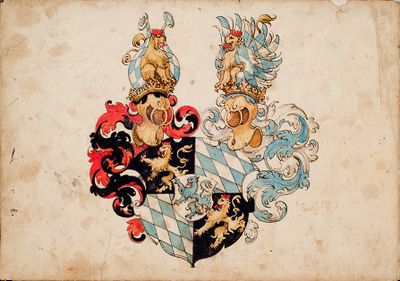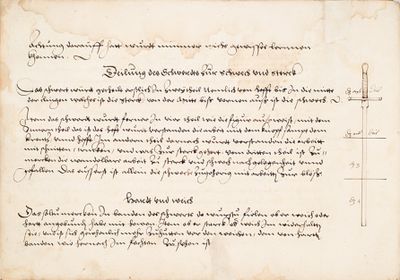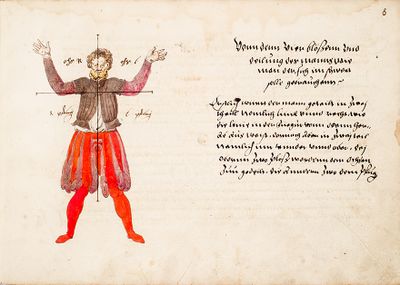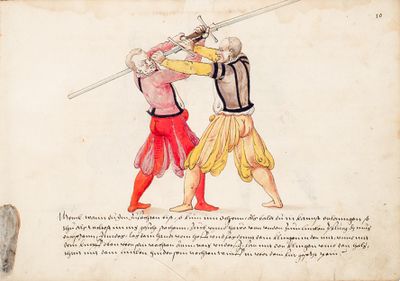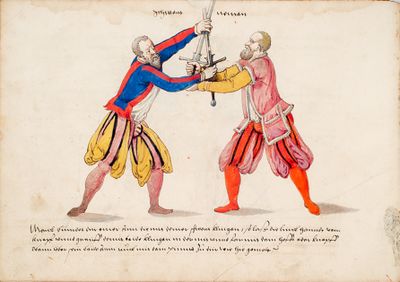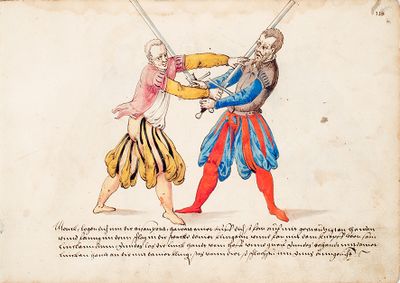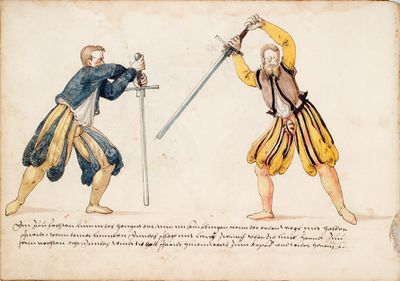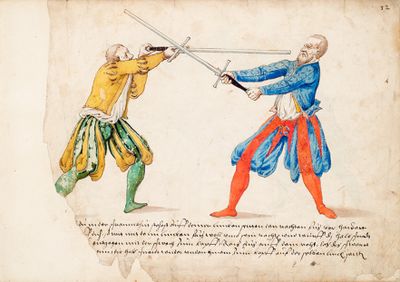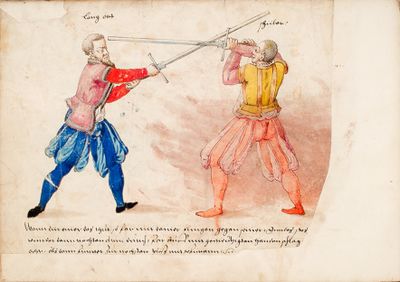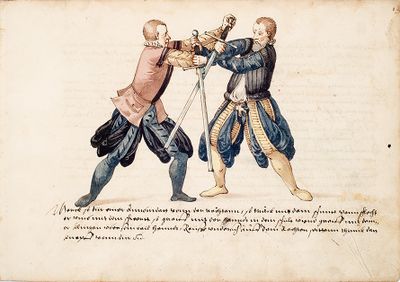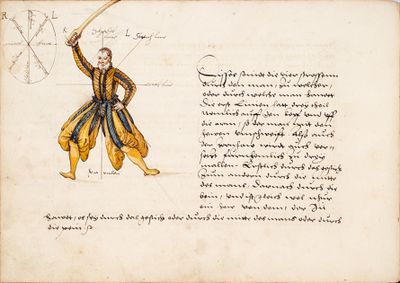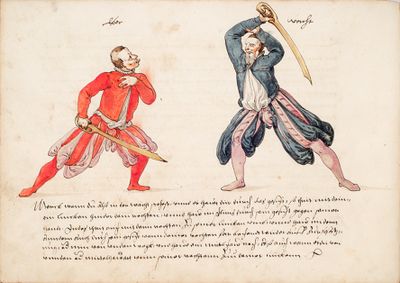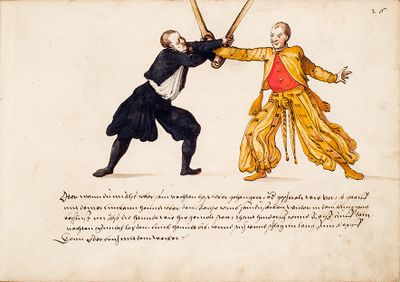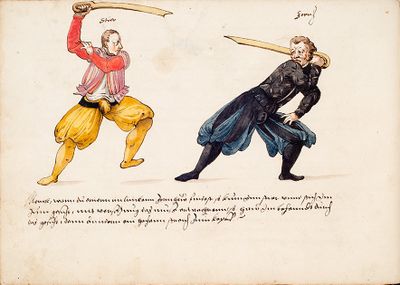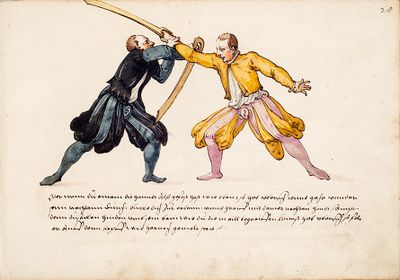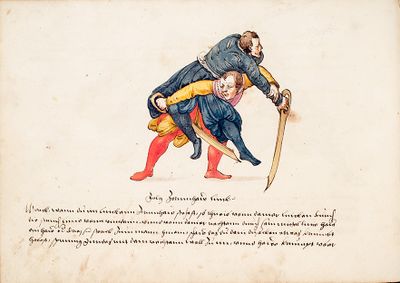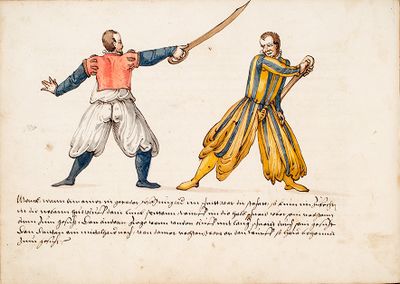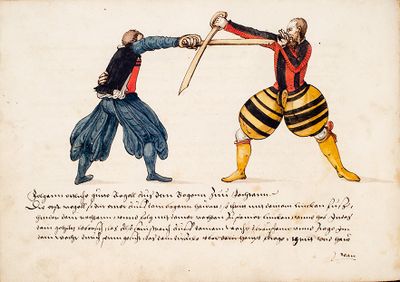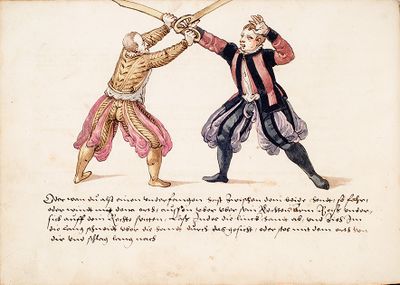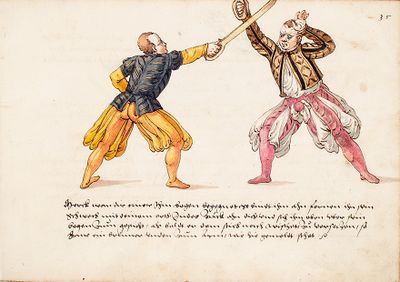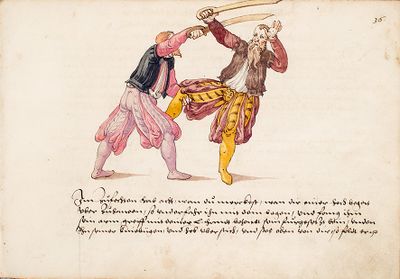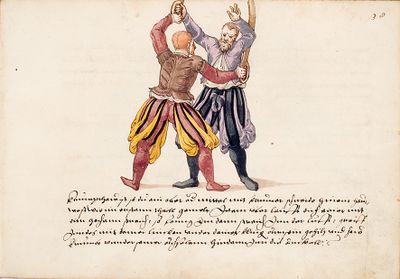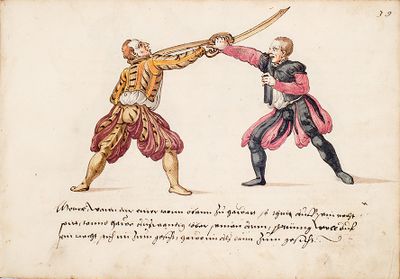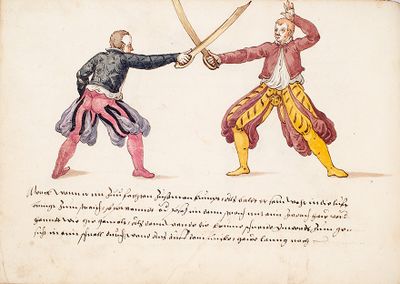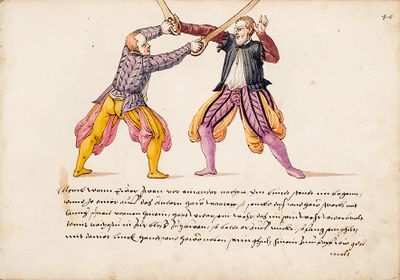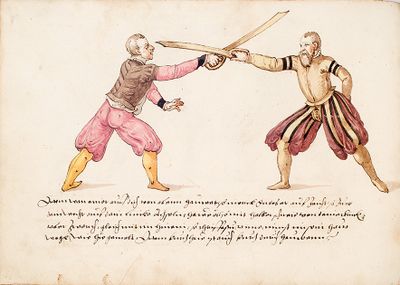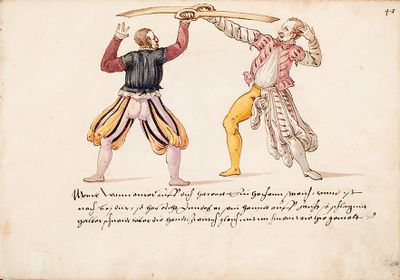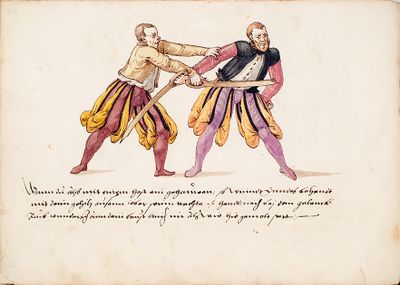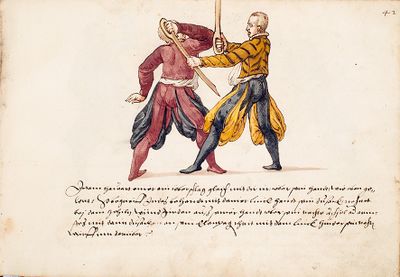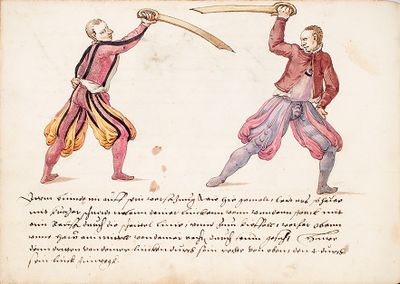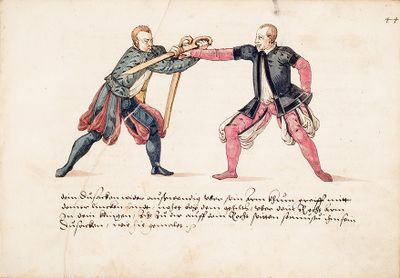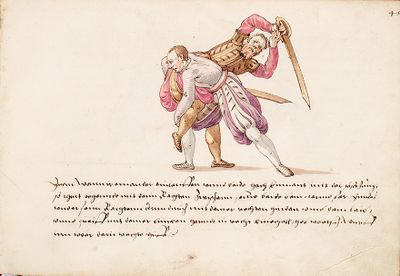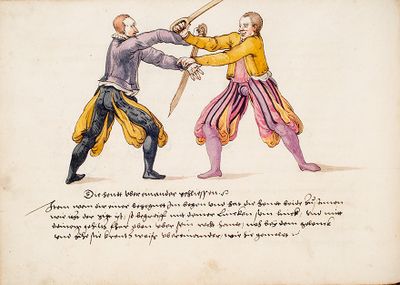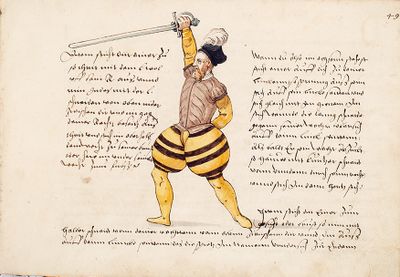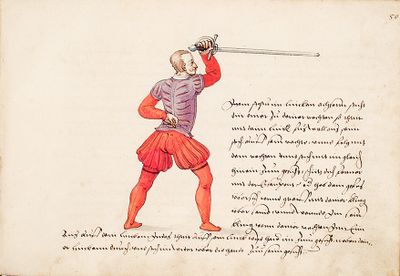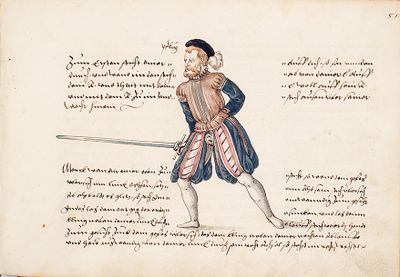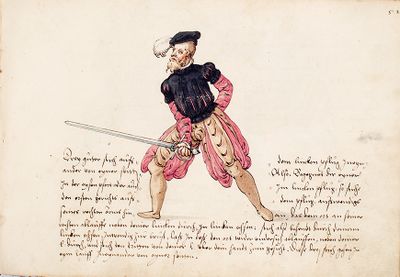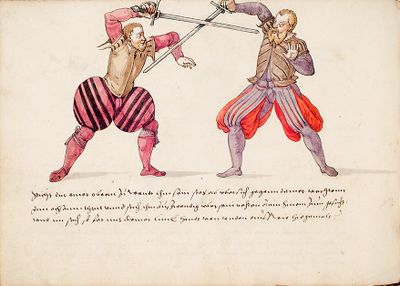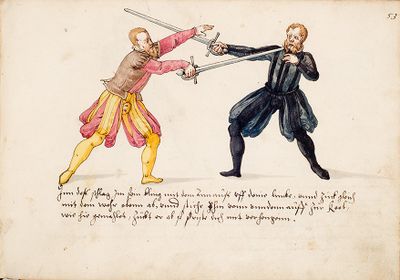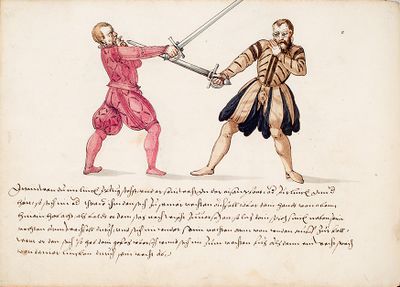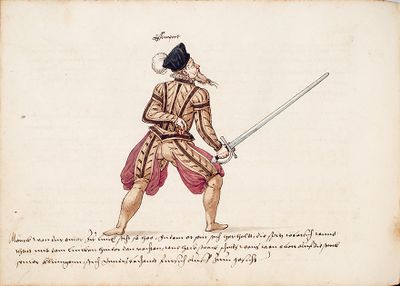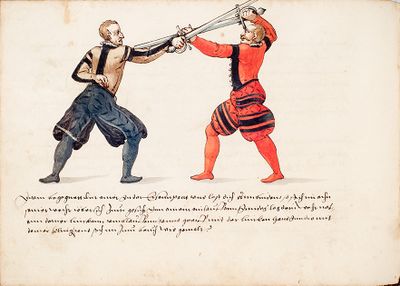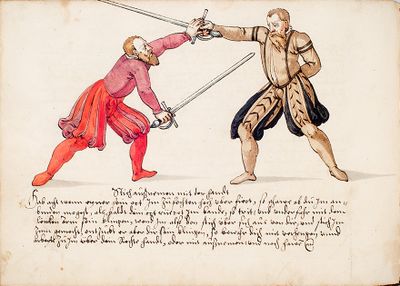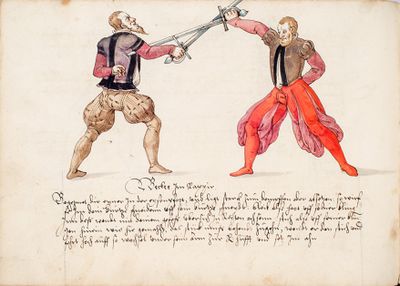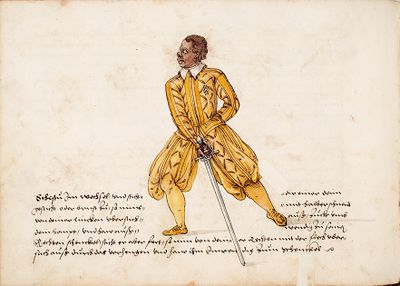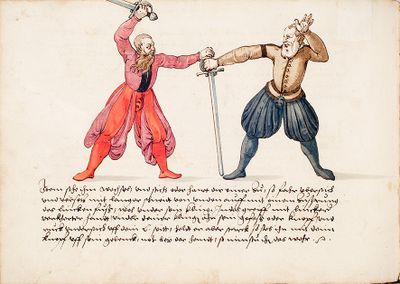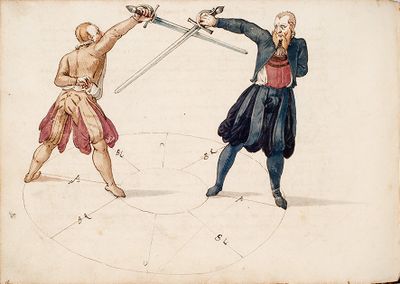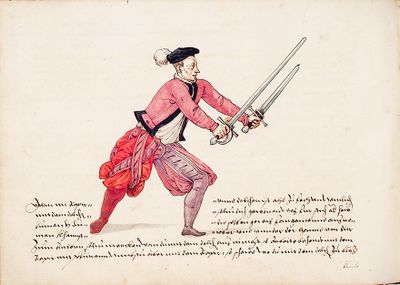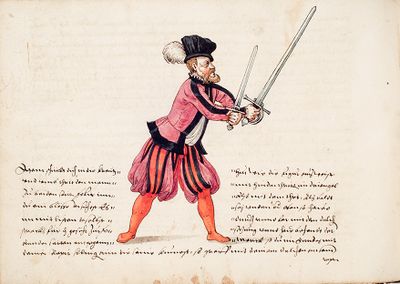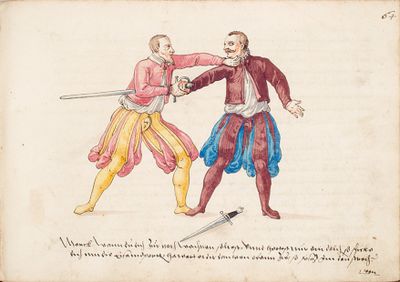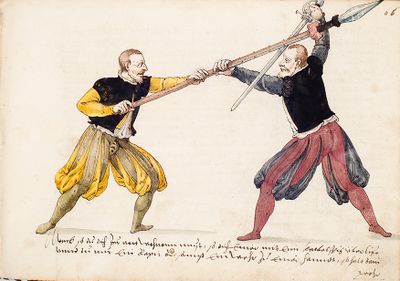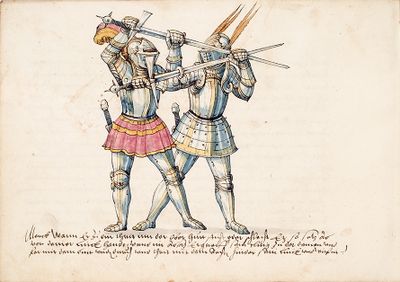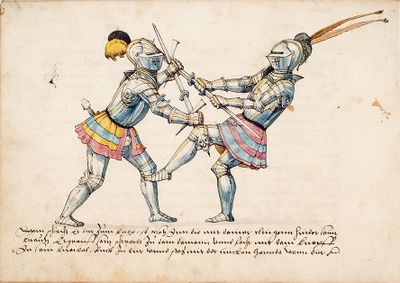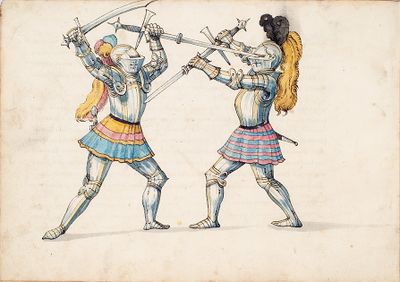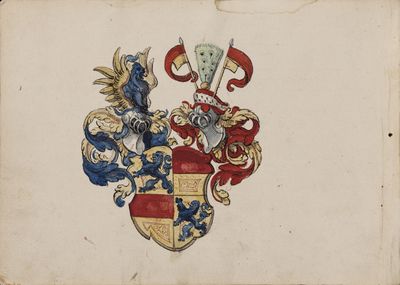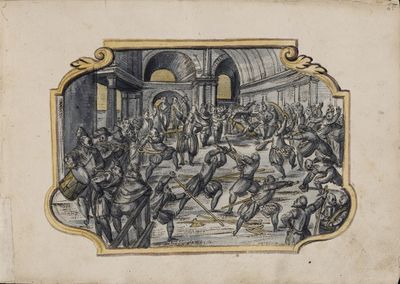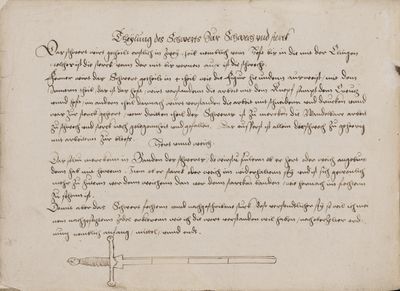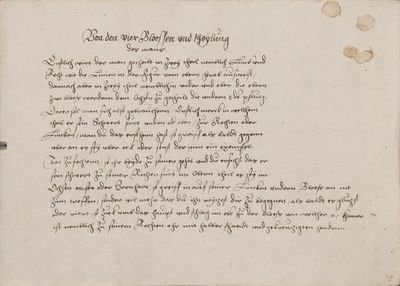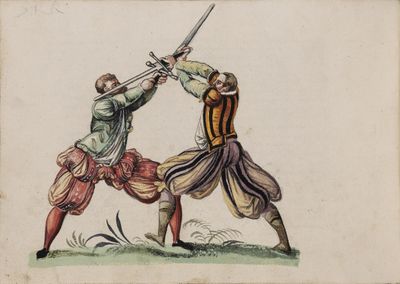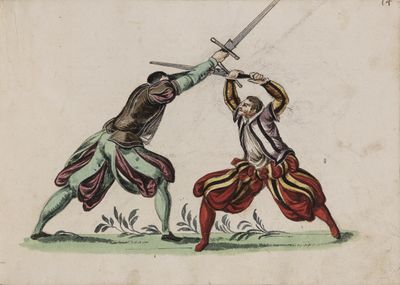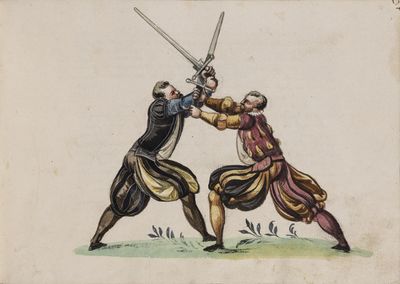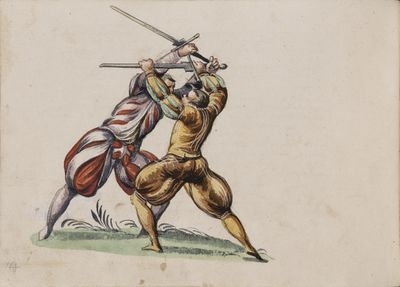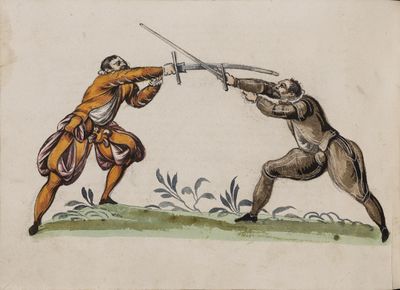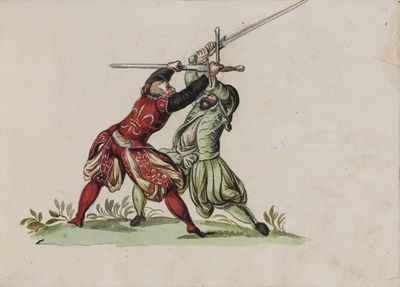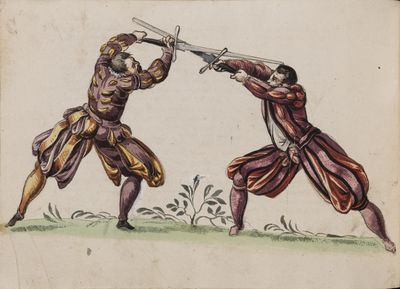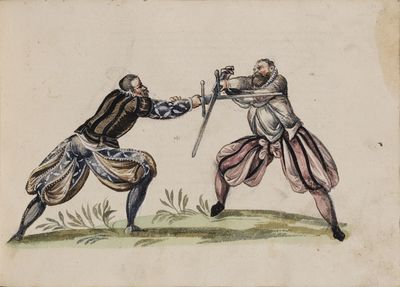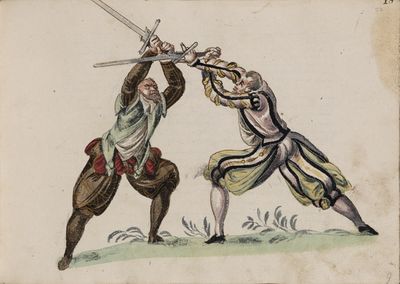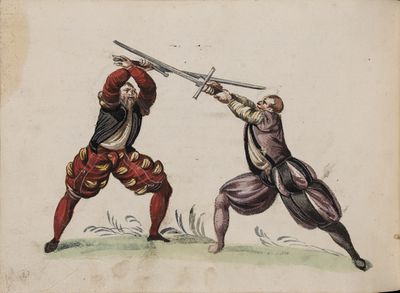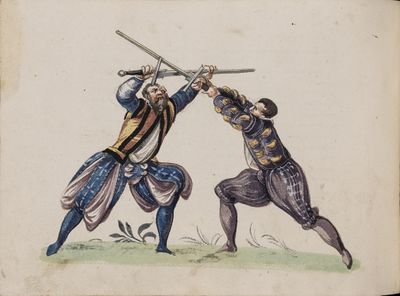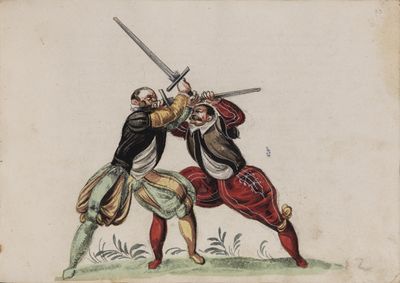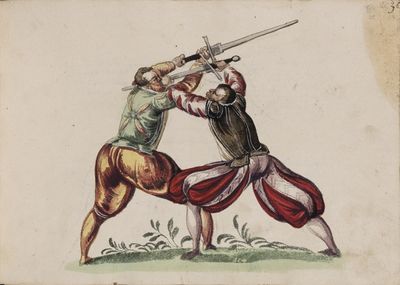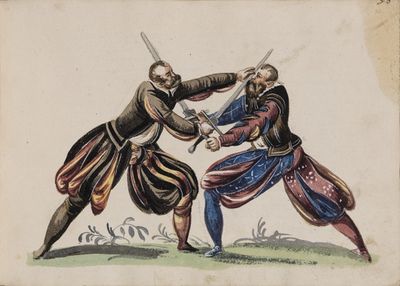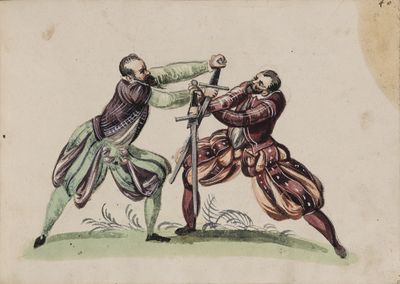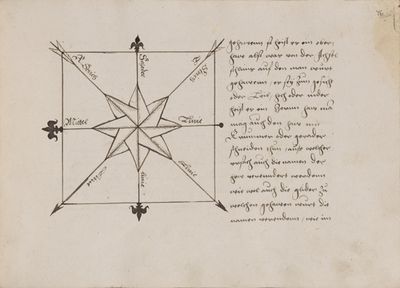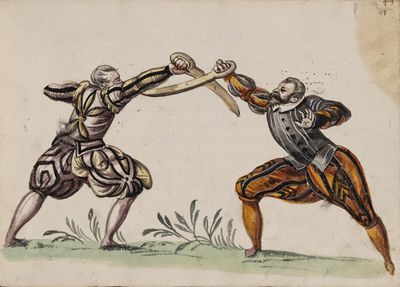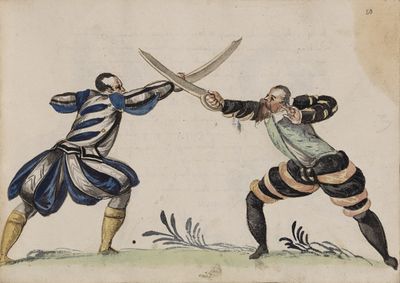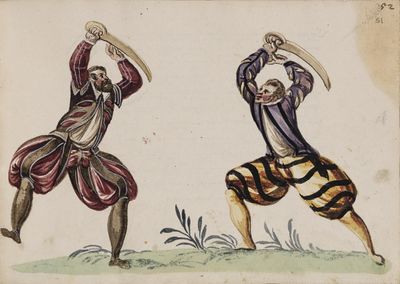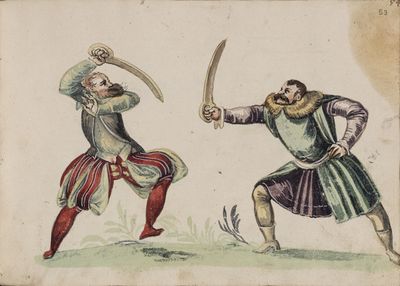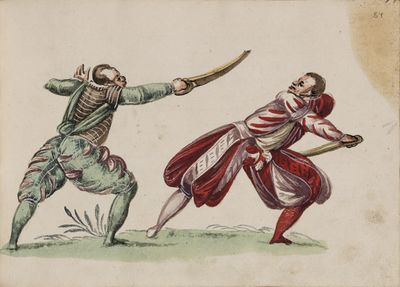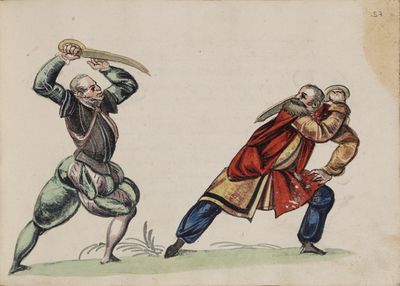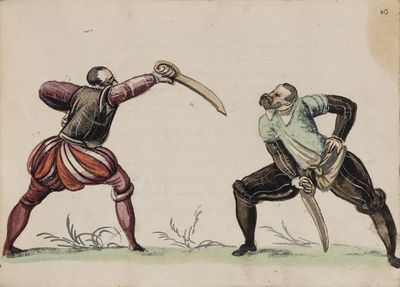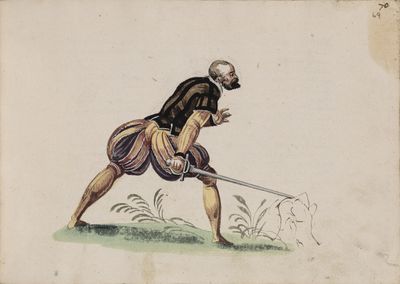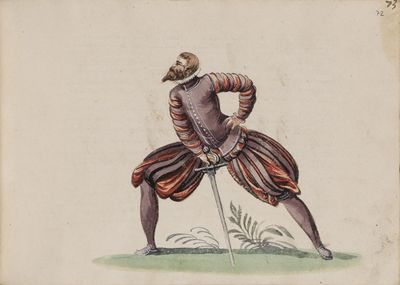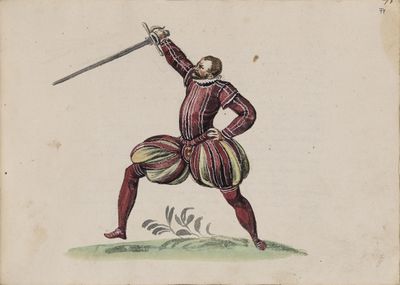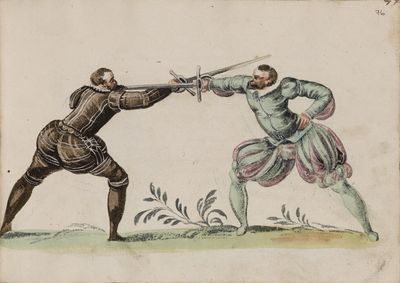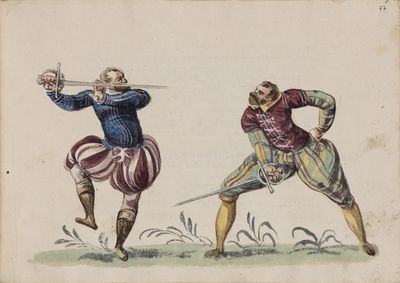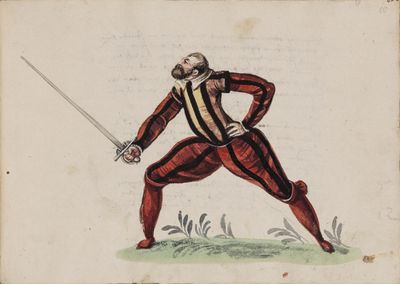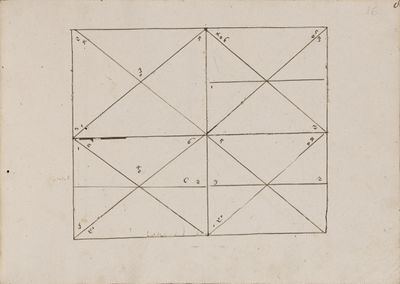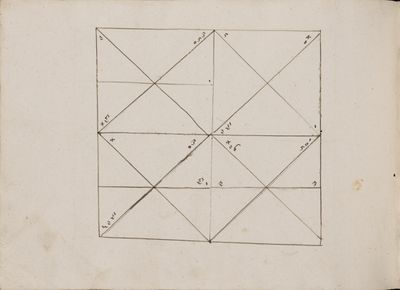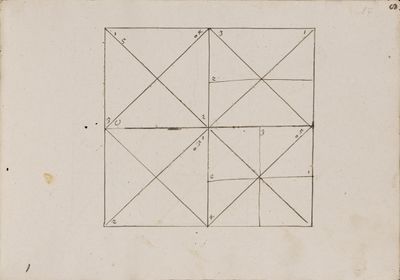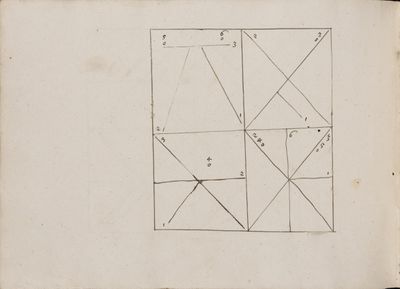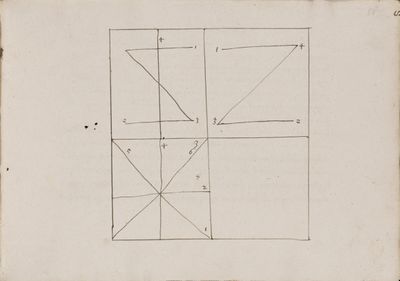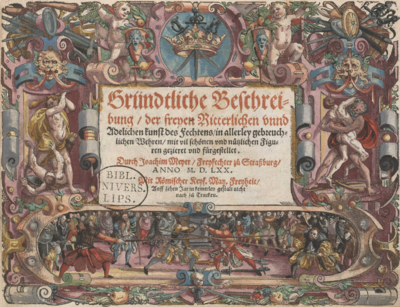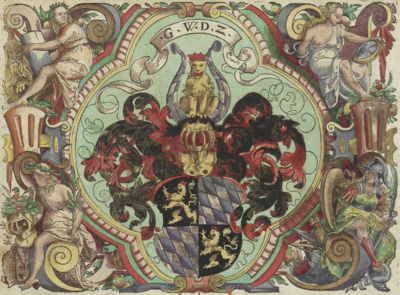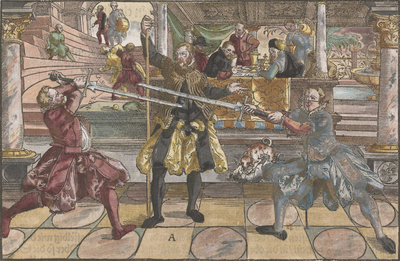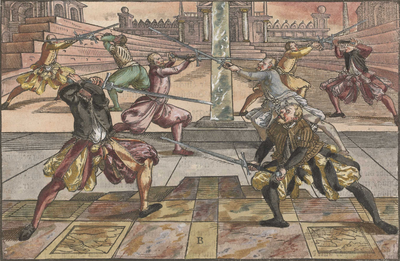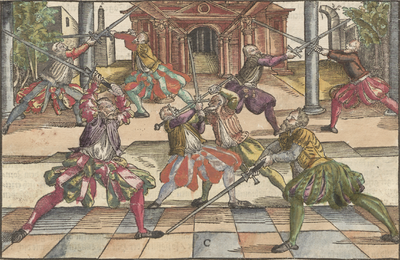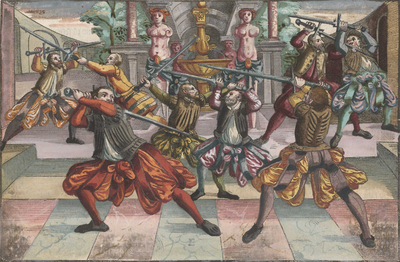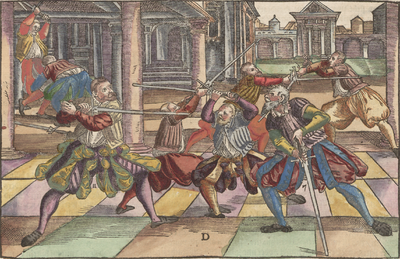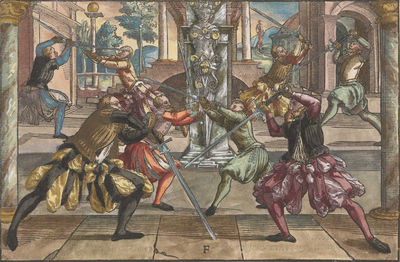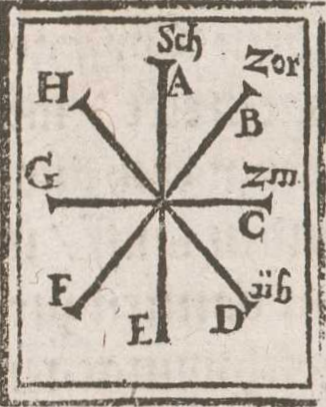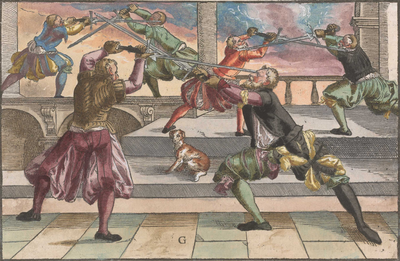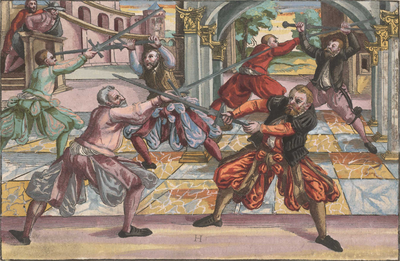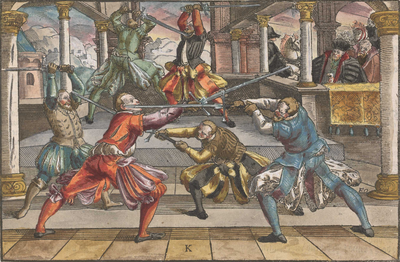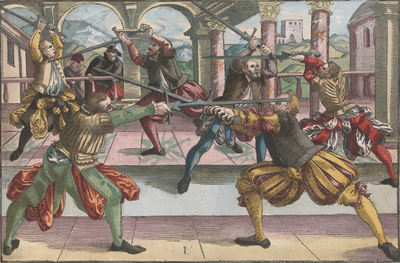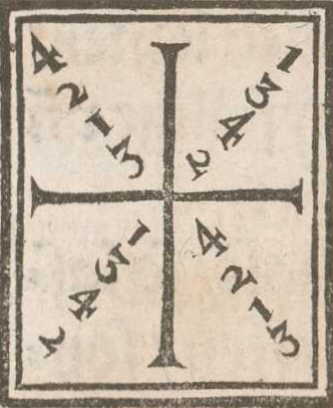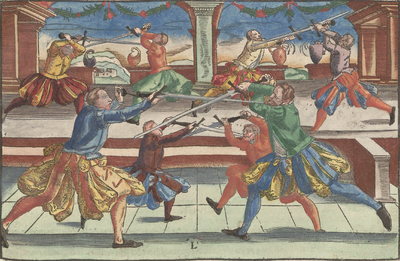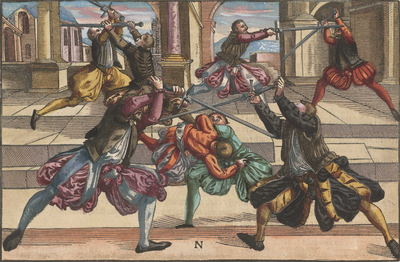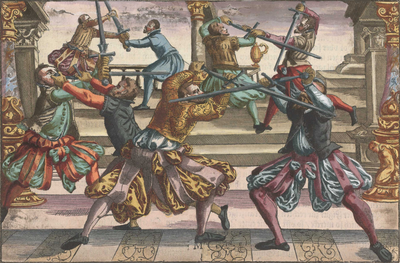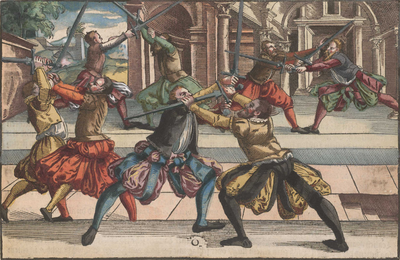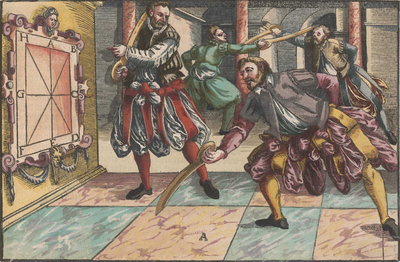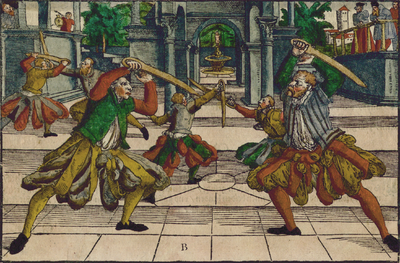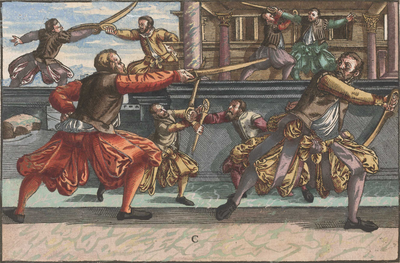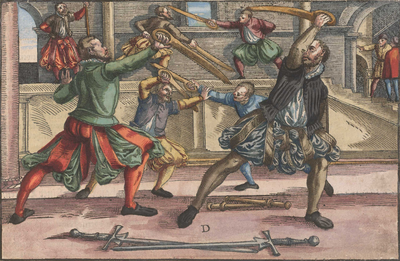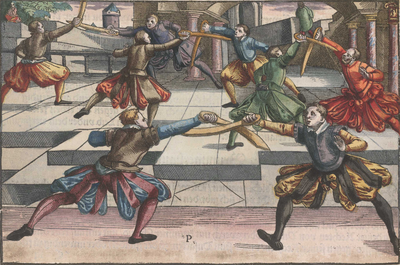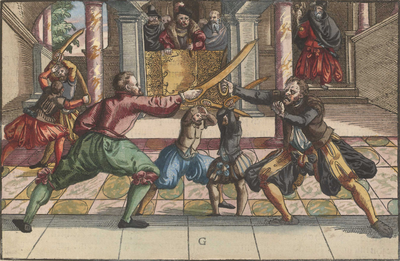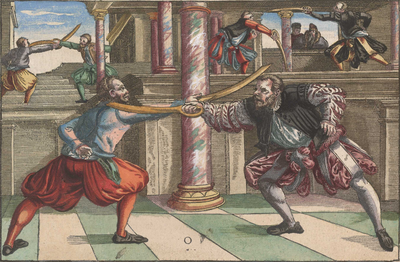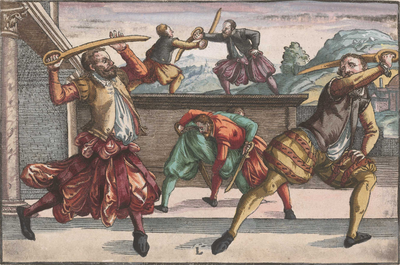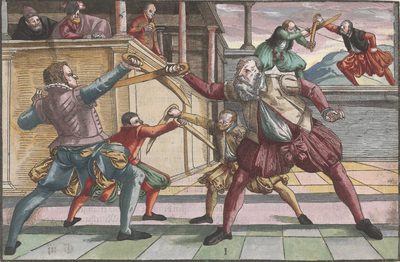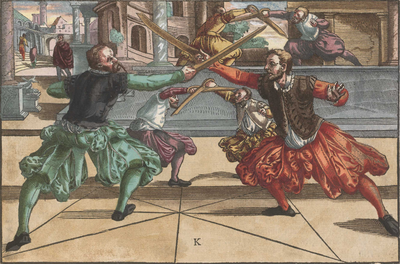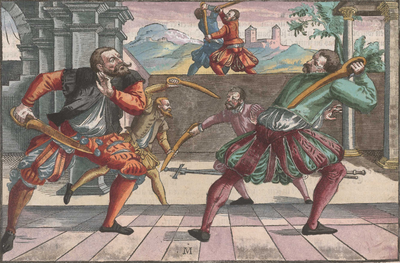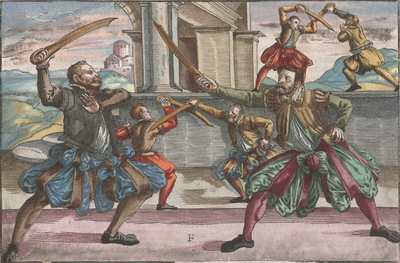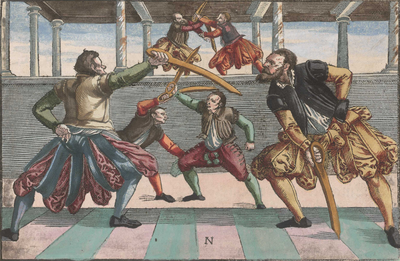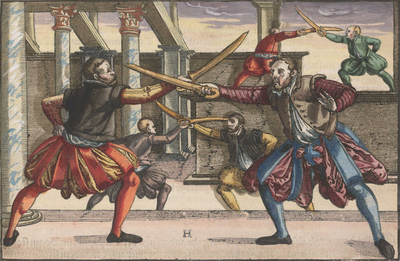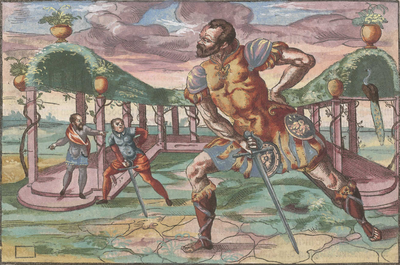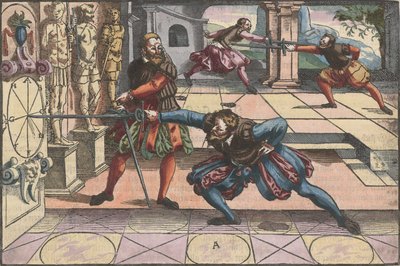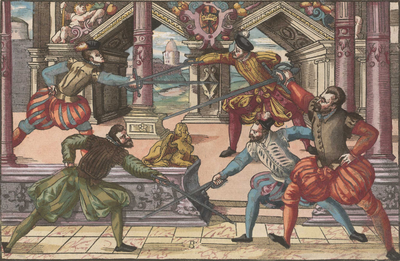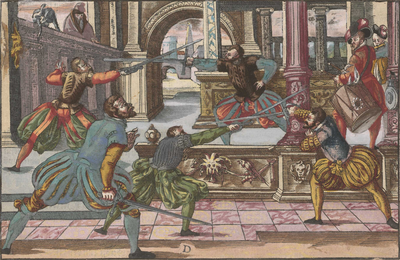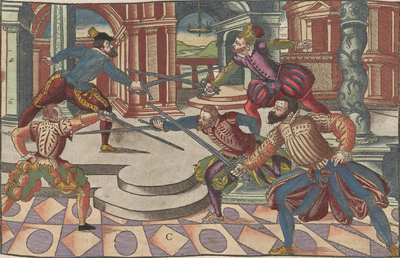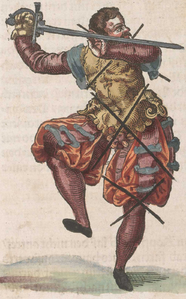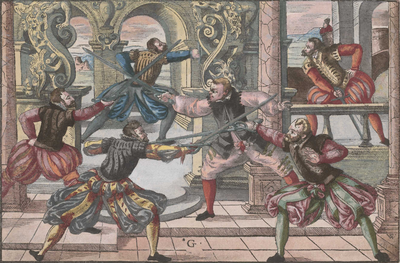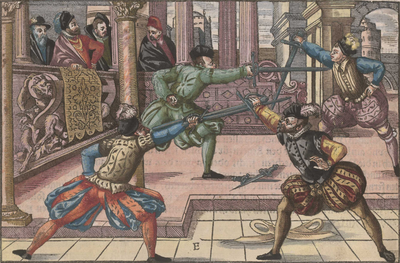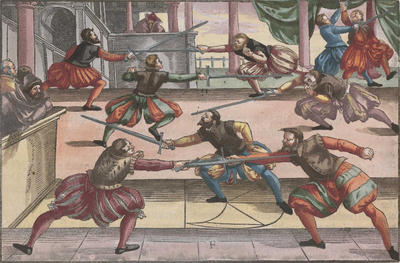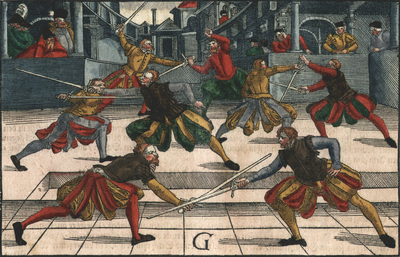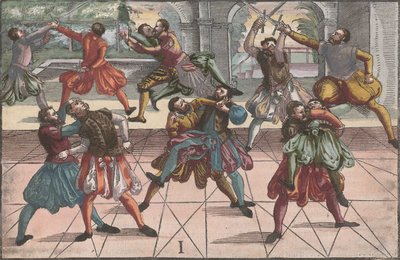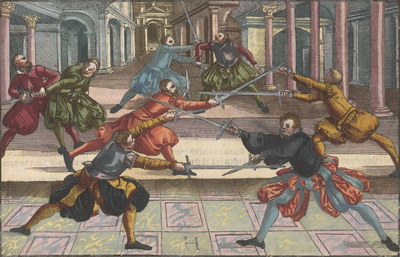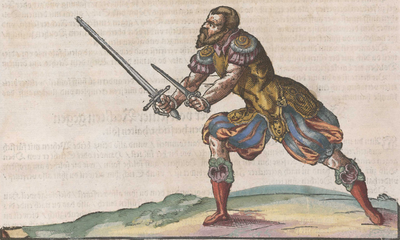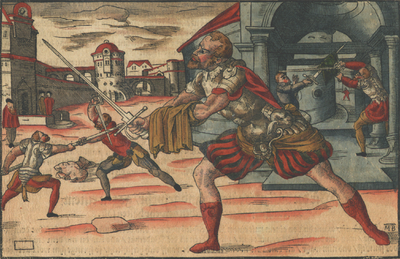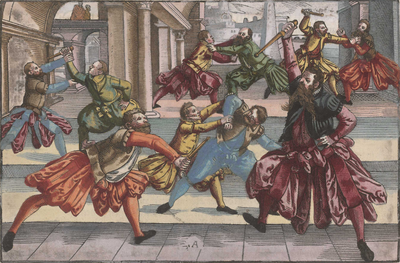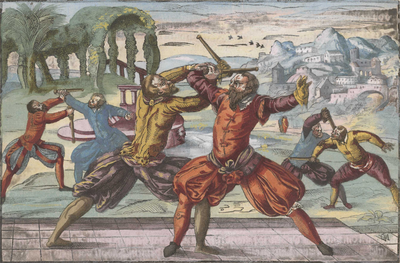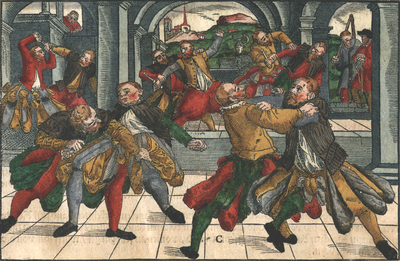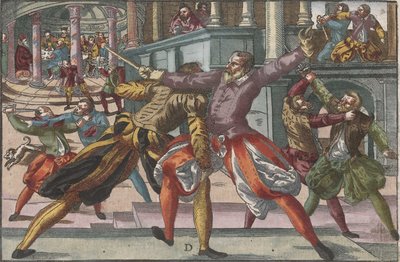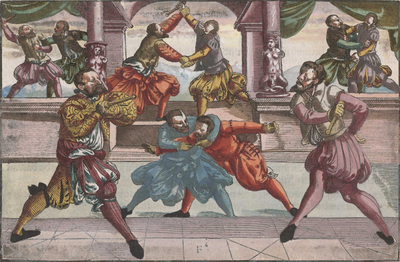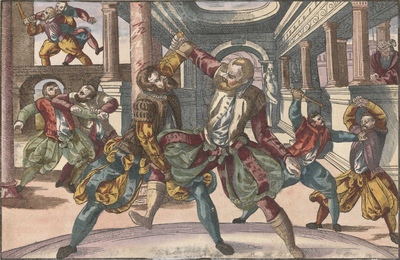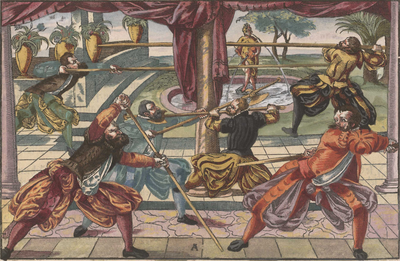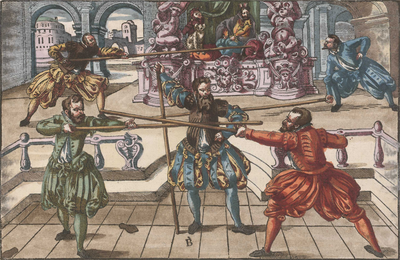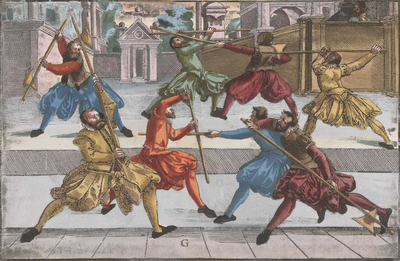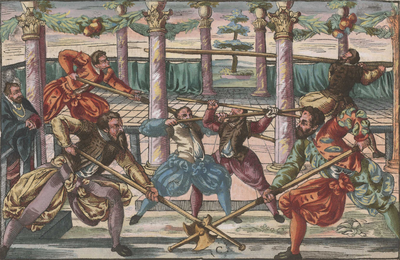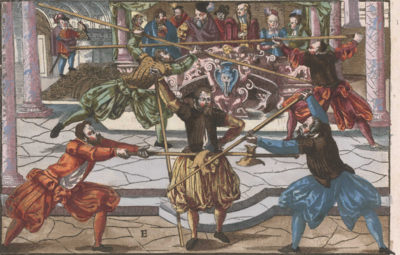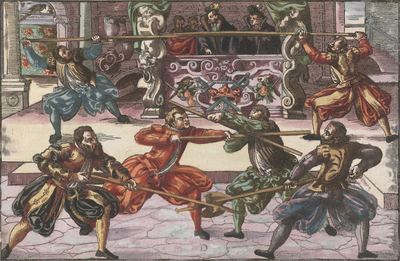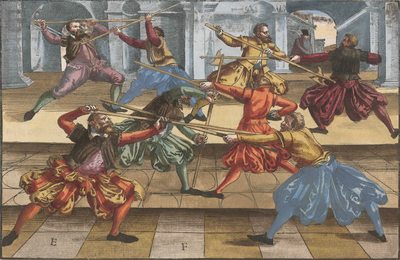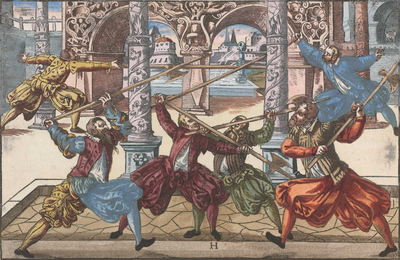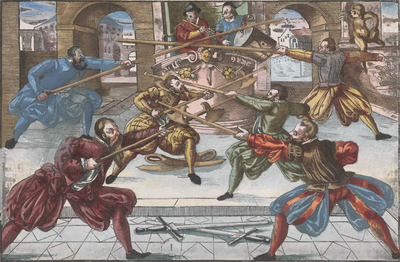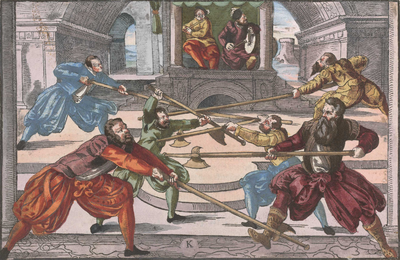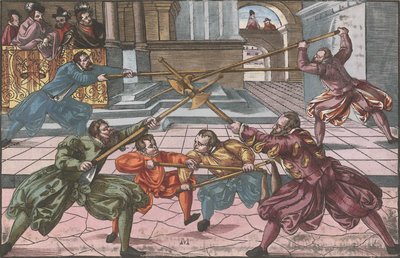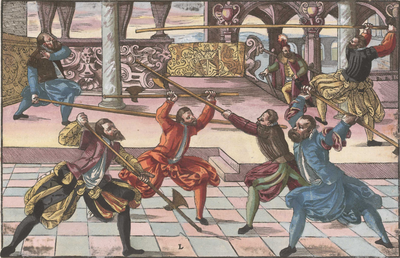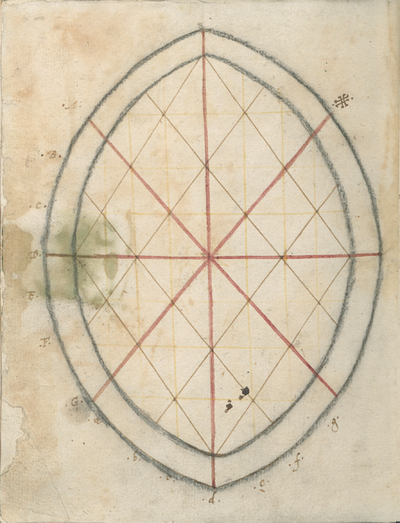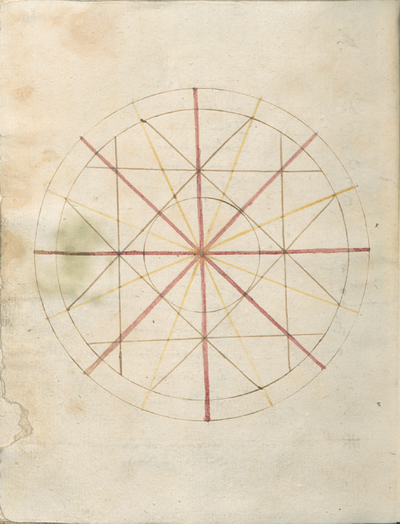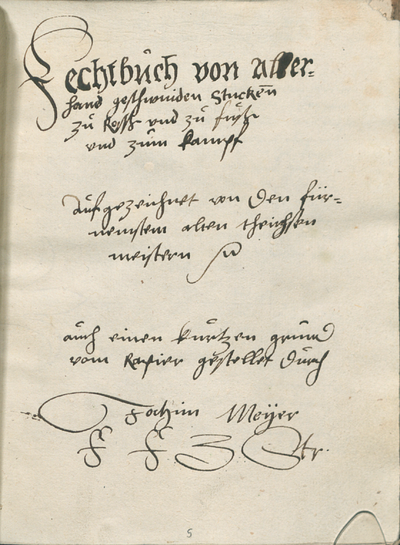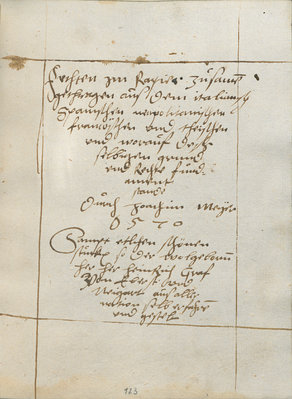|
|
You are not currently logged in. Are you accessing the unsecure (http) portal? Click here to switch to the secure portal. |
Difference between revisions of "Joachim Meyer"
(→Temp) |
|||
| (17 intermediate revisions by the same user not shown) | |||
| Line 23: | Line 23: | ||
| education = | | education = | ||
| alma_mater = | | alma_mater = | ||
| − | | patron = {{ | + | | patron = {{plainlist |
| Georg Johann Ⅰ | | Georg Johann Ⅰ | ||
| − | | | + | | Otto von Solms |
| + | | Johann Casimir | ||
| Johann Albrecht | | Johann Albrecht | ||
| − | |||
| − | |||
}} | }} | ||
| period = | | period = | ||
| Line 49: | Line 48: | ||
| relatives = | | relatives = | ||
| influences = {{collapsible list | | influences = {{collapsible list | ||
| − | | [[ | + | | [[Sigmund Ain ringeck]] |
| [[Johannes Lecküchner]] | | [[Johannes Lecküchner]] | ||
| [[Johannes Liechtenauer]] | | [[Johannes Liechtenauer]] | ||
| + | | [[Lew]] | ||
| [[Achille Marozzo]] | | [[Achille Marozzo]] | ||
| [[Andre Paurenfeyndt]] | | [[Andre Paurenfeyndt]] | ||
| − | |||
| [[Martin Syber]] | | [[Martin Syber]] | ||
}} | }} | ||
| influenced = {{plainlist | | influenced = {{plainlist | ||
| − | |||
| [[Jakob Sutor von Baden]] | | [[Jakob Sutor von Baden]] | ||
| [[Theodori Verolini]] | | [[Theodori Verolini]] | ||
| Line 120: | Line 118: | ||
|- | |- | ||
| − | | <p>Noble high-born Prince, Your Princely Grace, my submissive obedient willing and diligent service is ready at all times, gracious Lord | + | | <p>Noble high-born Prince, Your Princely Grace, my submissive obedient willing and diligent service is ready at all times, gracious Lord. The ancient scholars have not in vain made the art of fencing famous with all praise and diligence to all and the same enthusiastic princes and lords imagined especially because of the greater part of chivalrous fights and excellent deeds, hence an origin was taken and credibly told, by which many of the most famous minds are so awakened and strengthened that they may be praised and honored for their high observance and administration of war, and will be magnificent. Therefore, up to the present day, the inspired practice and the art of fencing has not fallen to any decline but has retained its old praises and worthiness by all, the youth are instructed in many noble deeds and practices, solely in accordance with all the arts, intact and undamaged, in the old traditional standings, and have become infatuated. But since I have heard and understood how that Your Princely Grace bears no displeasure to such honorable fencing but much more gracious respect to such fighting ''Stucken'', and how they are not to be divided, and that as such, their virtues are composed in writing, the same to give Your Grace an easy account of all these ''Stucke'', done to keep and retain the much covered arts quite free from defects, in subservience, I shall not spare my diligence, in which, Your Princely Grace, through my submissive means and ways, and as much as I have learned from youth and sought to describe and show here. Which and although it might be a little longer than I myself hoped, and that Your Princely Grace shall forgive and take into account that such multiple works require so much time and effort to write. To this end, it would not be enough that one weapon, two or three is taught and delivered to you, but rather that one ''Stuck'' is attached to the other like in a chain, one thing after another is noted, and experience is gained, and one weapon is the teacher of another, I have been caused to assemble the entire fencing art, as if it was very proper and I, in consideration, have ascribed this tract to Your Princely Grace as a princely person, and have produced it solely by the limited ''Stucken'' of the same, for Your Princely Grace, giving their proper titles and names, how I know and am obliged to do, also in good part so that the teaching can be clearly understood, and brought to this point, that some ''Stucken'' are so completely incomprehensible for and to the hand, that I myself may scarcely understand again their same proper titles and reverence, not to mention where the honorific words should remain, so that it might be of use to someone, that thus not intentionally, but rather without obscuring the art, the pieces have been written with general words. I must show that the understanding is clearly taken without any error, even where one can apply a school law, the following may you learn and understand for yourself, but with what effort and work it will be done, an art that must be arranged and learned in practice alone, delivered here in writing for the eyes, and equally beheld as if they were to be practiced with the hands and the whole body. Put to paper and penned, especially those which were previously attempted and understood by few, I submissively give Your Princely Grace a high princely understanding and a graceful submission for your acceptance, from my slight ability to reveal the fencing arts in an understandable way, and to disclose the same in an intelligible manner sparing neither diligence nor effort (although the same content might be unremarkable). However, Your Princely Grace, I am most hopeful that you will graciously accept and embrace such a work as I have done, which has been carried out according to my will and how then such work has verily flowed from a loyal heart to Your Princely Grace in all possible service and in devoted submissiveness, from me as a faithful servant hereby most diligently commanded in graciousness, dated 7 March 1561. |
| | | | ||
{{section|Page:MS Bibl. 2465 IIIr.jpg|2|lbl=IIIr.2|p=1}} {{paget|Page:MS Bibl. 2465|IIIv|jpg|p=1}} {{paget|Page:MS Bibl. 2465|IVr|jpg|p=1}} {{section|Page:MS Bibl. 2465 IVv.jpg|1|lbl=IVv.1|p=1}} | {{section|Page:MS Bibl. 2465 IIIr.jpg|2|lbl=IIIr.2|p=1}} {{paget|Page:MS Bibl. 2465|IIIv|jpg|p=1}} {{paget|Page:MS Bibl. 2465|IVr|jpg|p=1}} {{section|Page:MS Bibl. 2465 IVv.jpg|1|lbl=IVv.1|p=1}} | ||
| Line 168: | Line 166: | ||
|- | |- | ||
| − | | <p>Item | + | | <p>Item: The sword is further divided in four parts how the figure shows. With the inward part, that is the haft, and (with it) the work with the pommel and cross and haft will be understood, in the next part, thereafter will the work with cutting and pushing and what belongs to the Strong be understood, to the third part of the sword should be noted the alterable work of the Weak and Strong after opportunity and liking. Which alone is extremely weak for you to work properly to the Openings.</p> |
| {{section|Page:MS Bibl. 2465 001v.jpg|3|lbl=1v.3}} | | {{section|Page:MS Bibl. 2465 001v.jpg|3|lbl=1v.3}} | ||
| Line 175: | Line 173: | ||
| <p>'''Hard and Soft'''</p> | | <p>'''Hard and Soft'''</p> | ||
| − | <p>Thus you shall mark in the binding of the swords, as you shall feel if he has become hard or soft in the bind, with the cut. Item | + | <p>Thus you shall mark in the binding of the swords, as you shall feel if he has become hard or soft in the bind, with the cut. Item: If he is yet again, Strong or Weak, and is usually more watchful of the Weak binding before the Strong, how hereafter in the fencing it can be seen.</p> |
| {{section|Page:MS Bibl. 2465 001v.jpg|4|lbl=1v.4}} | | {{section|Page:MS Bibl. 2465 001v.jpg|4|lbl=1v.4}} | ||
| Line 192: | Line 190: | ||
|- | |- | ||
| | | | ||
| − | | <p>The 8 Secondary Guards, Long Point, Iron | + | | <p>The 8 Secondary Guards, Long Point, Iron Gate, Hanging Point, Speak Window, Key, Side Guard, Barrier Guard and Wrath Guard.</p> |
| {{section|Page:MS Bibl. 2465 002r.jpg|3|lbl=2r.3}} | | {{section|Page:MS Bibl. 2465 002r.jpg|3|lbl=2r.3}} | ||
| Line 294: | Line 292: | ||
| <p>'''Wrist Cut'''</p> | | <p>'''Wrist Cut'''</p> | ||
| − | <p>Item: | + | <p>Item: If one stands in Speak Window and the other is too, or otherwise comes high so that his blade hangs down to the lower left, then cut with a horizontal strike up from below between the pommel or behind the pommel to the hands.</p> |
| {{section|Page:MS Bibl. 2465 004r.jpg|1|lbl=4r.1}} | | {{section|Page:MS Bibl. 2465 004r.jpg|1|lbl=4r.1}} | ||
| Line 308: | Line 306: | ||
| <p>'''Winding Cut'''</p> | | <p>'''Winding Cut'''</p> | ||
| − | <p>If one stands before you with outstretched arms in the Long Point, then come in the ''Zufechten'' with the right foot forward, the sword in Hanging Point | + | <p>If one stands before you with outstretched arms in the Long Point, then come in the ''Zufechten'' with the right foot forward, the sword in Hanging Point. Instantly pull around the head and cut with the long edge from the left outside and over his right arm so that your sword appears to swing between his head and sword to his left shoulder, pull back around again to the horizontal cut or Long Point.</p> |
| {{section|Page:MS Bibl. 2465 004r.jpg|3|lbl=4r.3}} | | {{section|Page:MS Bibl. 2465 004r.jpg|3|lbl=4r.3}} | ||
| Line 322: | Line 320: | ||
| <p>'''Remaining'''</p> | | <p>'''Remaining'''</p> | ||
| − | <p>Is thus understood when one cuts into an opening with the long edge and at once would pull back to himself as if to cut to another opening, but does not, and instead cuts again with the short edge on the same line, that is called remaining, when one remains with cutting on one opening. Item | + | <p>Is thus understood when one cuts into an opening with the long edge and at once would pull back to himself as if to cut to another opening, but does not, and instead cuts again with the short edge on the same line, that is called remaining, when one remains with cutting on one opening. Item: One remains in the binding of the swords and waits on the next action until he gets his opportunity to work further.</p> |
| {{section|Page:MS Bibl. 2465 004v.jpg|2|lbl=4v.2}} | | {{section|Page:MS Bibl. 2465 004v.jpg|2|lbl=4v.2}} | ||
| Line 365: | Line 363: | ||
| <p>'''Doubling'''</p> | | <p>'''Doubling'''</p> | ||
| − | <p>Doubling is when you allow it once or twice to run off, and also to double. Item | + | <p>Doubling is when you allow it once or twice to run off, and also to double. Item: One cut done twice or doubled, thus in the approach I cut from my right to his left ear, once it clashes I take it away again, to my right and cut once again inside and halfway through, allowing it to snap in again.</p> |
| {{section|Page:MS Bibl. 2465 005r.jpg|4|lbl=5r.4}} | | {{section|Page:MS Bibl. 2465 005r.jpg|4|lbl=5r.4}} | ||
| Line 372: | Line 370: | ||
| <p>'''Deceiving'''</p> | | <p>'''Deceiving'''</p> | ||
| − | <p>That is when you look at an opening and make as if you would cut there, but you don’t and instead cut somewhere else, this is the second Squinter with the face | + | <p>That is when you look at an opening and make as if you would cut there, but you don’t and instead cut somewhere else, this is the second Squinter with the face. Item: The fencer who will willingly parry, or slice away, so there you should work quickly with failing, flying around, circling or looping, so he does not know where to go and gets lost.</p> |
| {{section|Page:MS Bibl. 2465 005r.jpg|5|lbl=5r.5}} | | {{section|Page:MS Bibl. 2465 005r.jpg|5|lbl=5r.5}} | ||
| Line 407: | Line 405: | ||
| <p>'''Winding'''</p> | | <p>'''Winding'''</p> | ||
| − | <p>When you have bound with him, then remain with the edge on his blade, turn the half edge inwards to his head. Item | + | <p>When you have bound with him, then remain with the edge on his blade, turn the half edge inwards to his head. Item: When you have thus wound in with the half edge then turn with the pommel again out to the other side upwards and wind the half edge outwards to his head from below through the horizontal.</p> |
| {{section|Page:MS Bibl. 2465 005v.jpg|5|lbl=5v.5}} | | {{section|Page:MS Bibl. 2465 005v.jpg|5|lbl=5v.5}} | ||
| Line 481: | Line 479: | ||
| <p>'''Hanging'''</p> | | <p>'''Hanging'''</p> | ||
| − | <p>Hanging is various, namely to constrain while hanging over | + | <p>Hanging is various, namely to constrain while hanging over. Item: Stand in Plow if one strikes at you, then drive up with the arms and catch the strike on the flat of your blade on the Strong, that is Hanging.</p> |
| {{section|Page:MS Bibl. 2465 007r.jpg|2|lbl=7r.2}} | | {{section|Page:MS Bibl. 2465 007r.jpg|2|lbl=7r.2}} | ||
| Line 495: | Line 493: | ||
| <p>'''Barring'''</p> | | <p>'''Barring'''</p> | ||
| − | <p>Then if one stands in Changer or the Fool before you, fall on him quickly thereafter with the long edge. Item | + | <p>Then if one stands in Changer or the Fool before you, fall on him quickly thereafter with the long edge. Item: If one strikes out before you, then bar him also with setting off.</p> |
| {{section|Page:MS Bibl. 2465 007r.jpg|4|lbl=7r.4}} | | {{section|Page:MS Bibl. 2465 007r.jpg|4|lbl=7r.4}} | ||
| Line 547: | Line 545: | ||
| <p>'''Another'''</p> | | <p>'''Another'''</p> | ||
| − | <p>In the ''Zufechten'' when the opponent holds his sword on the left, then go through before him from your right, and cut with strength to his right. As soon as he slips after the strike, then pull in a loop to the left opening, if he slips after it again, then let it fly back around, thus going from one opening to the other, crosswise and against each other according to opportunity. Every fighter should be accustomed to be promptly heedful in all hits, from whichever opening the cut has come, instantly to follow after there. And before I conclude I will add the teaching concerning parrying. It is written in the ancient ''Zedel'', Who often parries is often hit.</p> | + | <p>In the ''Zufechten'' when the opponent holds his sword on the left, then go through before him from your right, and cut with strength to his right. As soon as he slips after the strike, then pull in a loop to the left opening, if he slips after it again, then let it fly back around, thus going from one opening to the other, crosswise and against each other according to opportunity. Every fighter should be accustomed to be promptly heedful in all hits, from whichever opening the cut has come, instantly to follow after there. And before I conclude I will add the teaching concerning parrying. It is written in the ancient ''Zedel'', "Who often parries is often hit".</p> |
| {{section|Page:MS Bibl. 2465 008v.jpg|3|lbl=8v.3}} | | {{section|Page:MS Bibl. 2465 008v.jpg|3|lbl=8v.3}} | ||
|- | |- | ||
| | | | ||
| − | | <p>Item | + | | <p>Item: Liechtenauer says in his secret words "Guard yourself against parrying, if need befalls you it will hurt you". Therefore every fighter should be accustomed to be the first to attack and finish, then if every fighter is accustomed to watch and wait for another, this same rarely comes away without harm, or at the least does not achieve very much. A proper fighter however does not parry much unless he has a great advantage. And when the opponent strikes so he strikes too, if the opponent thrusts then he thrusts too, if the opponent steps, he steps also. For when two like strokes come together, they bring their parrying with them, and when someone cuts from above and you cut against it with a Thwart, then you parry and hit at the same time. Likewise you shall pay attention to simultaneous cutting and take good heed of your advantage in it. Therefore, every fencer should know that he should quickly consider, as mentioned above, when two good fencers come together, which I consider is the same as shown before.<ref>Note: here I have included this line for clarity from Dr. Forgeng’s 1568 Lund translation: “Therefore every fighter shall know as has been said above, for when two good fighters come together, whoever thinks quicker triumphs quicker.”</ref></p> |
| | | | ||
{{section|Page:MS Bibl. 2465 008v.jpg|4|lbl=8v.4|p=1}} {{section|Page:MS Bibl. 2465 009r.jpg|1|lbl=9r.1|p=1}} | {{section|Page:MS Bibl. 2465 008v.jpg|4|lbl=8v.4|p=1}} {{section|Page:MS Bibl. 2465 009r.jpg|1|lbl=9r.1|p=1}} | ||
| Line 588: | Line 586: | ||
|- | |- | ||
| [[File:MS Bibl. 2465 011r.jpg|400px|center]] | | [[File:MS Bibl. 2465 011r.jpg|400px|center]] | ||
| − | | <p>Note | + | | <p>Note: Position yourself in the Iron Gate, if he cuts at you, then drive up with crossed hands and catch his strike on the Strong of your blade, and drive with the pommel over his left arm, instantly release your left hand from the hilt and grab ''Indes'' quickly with your left hand onto the middle of your blade, push it from you, thus you strike him ''Indes'' to the face.</p> |
| {{paget|Page:MS Bibl. 2465|011r|jpg}} | | {{paget|Page:MS Bibl. 2465|011r|jpg}} | ||
| Line 625: | Line 623: | ||
|- | |- | ||
| | | | ||
| − | | <p>First of all, you should notice when someone comes near to you in such a way that you are in a bind or standing close, and you have the (sword) above the head in the speaking window or Roof, and one cuts directly at your fingers or fists, then cut against his incoming strike with a Thwart Cut, and step well out from his strike, to the side to which you have cut the Thwart, then Thwart again at once back around to the other opening | + | | <p>First of all, you should notice when someone comes near to you in such a way that you are in a bind or standing close, and you have the (sword) above the head in the speaking window or Roof, and one cuts directly at your fingers or fists, then cut against his incoming strike with a Thwart Cut, and step well out from his strike, to the side to which you have cut the Thwart, then Thwart again at once back around to the other opening. When you are well prepared for it and understand it well, then you can always hit him as often as he cuts at your fingers.</p> |
| {{section|Page:MS Bibl. 2465 013v.jpg|2|lbl=13v.2}} | | {{section|Page:MS Bibl. 2465 013v.jpg|2|lbl=13v.2}} | ||
| Line 676: | Line 674: | ||
| '''If you scare easily, <br/>don’t learn to fence.''' | | '''If you scare easily, <br/>don’t learn to fence.''' | ||
|} | |} | ||
| − | <p>Since I have taught sufficiently about the Before and After, the Weak and Strong, I will solely explain the word ''Indes'', which word has no other in it than an earnest meaning to be kept and considered | + | <p>Since I have taught sufficiently about the Before and After, the Weak and Strong, I will solely explain the word ''Indes'', which word has no other in it than an earnest meaning to be kept and considered. For when I strike to an opening, without first considering how I should strike the next, but rather see a cut along with it to the most conducive opening.</p> |
| {{section|Page:MS Bibl. 2465 014v.jpg|1|lbl=14v.1}} | | {{section|Page:MS Bibl. 2465 014v.jpg|1|lbl=14v.1}} | ||
| Line 743: | Line 741: | ||
<p>'''Of the 4 Openings'''</p> | <p>'''Of the 4 Openings'''</p> | ||
| − | <p>Although I have written in the first part extensively about the 4 openings, I want to explain the contents and make them explicit. The rhyme stands in the old ''Zedel'' and the Frankfurt ''Zedel'' but there is no interpretation about what are the 4 openings, what is taking aim | + | <p>Although I have written in the first part extensively about the 4 openings, I want to explain the contents and make them explicit. The rhyme stands in the old ''Zedel'' and the Frankfurt ''Zedel'' but there is no interpretation about what are the 4 openings, what is "taking aim", what is "to drive on against everyone", what is "how he bears". When one reads the rhymes already for so long, then one knows much about it afterwards, when he interprets the rhymes, and is showed freely with a sword, I thought a lot about it, I would like to see a master who can tell me the truth about aiming. But you should then understand the rhyme. The four openings are two above by the head and shoulders, and two by the elbows. But aiming* is when you strike to the upper openings and soon you see that the man has noticed, and does not slip after, then throw your sword in a Loop, or circle, you don’t lay on though, but rather to an opening on the arm, which you certainly have, that is called aiming. But what is; without any danger, that is when the opponent has not seen that you should strike, what is; however he acts, that is to all openings, then would the ''Zedel'' say, you hit him when his defense becomes open, he who knows well the four openings, can make wonder out of them, but the noble work can not be written in the books, one must prove it with iron.</p> |
| | | | ||
{{section|Page:MS Bibl. 2465 015v.jpg|2|lbl=15v.2|p=1}} {{section|Page:MS Bibl. 2465 016r.jpg|1|lbl=16r.1|p=1}} | {{section|Page:MS Bibl. 2465 015v.jpg|2|lbl=15v.2|p=1}} {{section|Page:MS Bibl. 2465 016r.jpg|1|lbl=16r.1|p=1}} | ||
| Line 920: | Line 918: | ||
| <p>'''Failer Twice'''</p> | | <p>'''Failer Twice'''</p> | ||
| − | <p>In ''Zufechten'', fail in deep enough at his left ear with the long edge, if he slips after, and will parry, so cast your sword in a circle and present it at his right ear, as soon as you see that you have touched swords, or hit, then you may use the ancient Slice,<ref>This is a reference to Liechtenauer verses 56 and 79. ~[[Michael Chidester|MCC]]</ref> that is doing the (handwork) Remaining, you push your sword over both his arms with the long edge so that he cannot defend it | + | <p>In ''Zufechten'', fail in deep enough at his left ear with the long edge, if he slips after, and will parry, so cast your sword in a circle and present it at his right ear, as soon as you see that you have touched swords, or hit, then you may use the ancient Slice,<ref>This is a reference to Liechtenauer verses 56 and 79. ~[[Michael Chidester|MCC]]</ref> that is doing the (handwork) Remaining, you push your sword over both his arms with the long edge so that he cannot defend it. However, what is the saying: “Double Failer, Step left until not allowed”.<ref>Liechtenauer verse 57. ~[[Michael Chidester|MCC]]</ref> It is all in a ''stuck'', and relies on one another, that when you slice or push to the arms, then you must continue it twice, that is, you must step around well to the opponent with the left foot. That is called Stepping in Left, until not allowed, with it the rhyme means that you must go quickly, so that the opponent doesn’t also veer away, and this is called Doubling.</p> |
| {{section|Page:MS Bibl. 2465 018v.jpg|2|lbl=18v.2}} | | {{section|Page:MS Bibl. 2465 018v.jpg|2|lbl=18v.2}} | ||
| Line 993: | Line 991: | ||
| '''Twice, or in it, <br/>With it your work begins''' | | '''Twice, or in it, <br/>With it your work begins''' | ||
|} | |} | ||
| − | <p>Chasing after is an exceptionally good work, however very few are the fencers who do it correctly | + | <p>Chasing after is an exceptionally good work, however very few are the fencers who do it correctly. Now note that this is the chasing after, when one will cut in at you from above, and as he draws up his sword to strike, so rush to him before he brings his strike, the work is all good against those who cut around too wide in the onset, then because they have their sword so far away, thus they are easier to reach, but the word Doubled means that you shall overtake me, when I have allowed my sword to fall or go nearly to the ground after the strike, so you must be cautious against the man who gladly allows his sword to fall nearly to the ground, then you must cut in at his head with the Head Strike, that is Doubling after shrewdly. In summation: when the opponent brings his sword in the air, then Chase after when he goes too far behind himself, ''Indes'' cut in the onset, then commit yourself to the chasing after, because the saying is made so well for the traveling after.</p> |
| | | | ||
{{section|Page:MS Bibl. 2465 020r.jpg|2|lbl=20r.2|p=1}} {{section|Page:MS Bibl. 2465 020v.jpg|1|lbl=20v.1|p=1}} | {{section|Page:MS Bibl. 2465 020r.jpg|2|lbl=20r.2|p=1}} {{section|Page:MS Bibl. 2465 020v.jpg|1|lbl=20v.1|p=1}} | ||
| Line 1,018: | Line 1,016: | ||
| '''Learn the feeling,<br/>''Indes'' is a word that cuts severely''' | | '''Learn the feeling,<br/>''Indes'' is a word that cuts severely''' | ||
|} | |} | ||
| − | <p>Feeling is nothing more than testing, binding on, or searching, so that feeling, testing and binding on is a thing, then the feeling is a simple word in all fencing, test whether the opponent fights hard or soft, if he cuts or pushes hard after, then pull your sword fine and softly, thus you will certainly find an opening, because the hard fencers reveal it themselves | + | <p>Feeling is nothing more than testing, binding on, or searching, so that feeling, testing and binding on is a thing, then the feeling is a simple word in all fencing, test whether the opponent fights hard or soft, if he cuts or pushes hard after, then pull your sword fine and softly, thus you will certainly find an opening, because the hard fencers reveal it themselves. But why is there a saying right after this “''Indes'' the word cuts severely”, therefore, one is a gentle and fast swordsman who cuts around at once so you are there with the slices, thus it is broken.</p> |
| | | | ||
{{section|Page:MS Bibl. 2465 020v.jpg|3|lbl=20v.3|p=1}} {{section|Page:MS Bibl. 2465 021r.jpg|1|lbl=21r.1|p=1}} | {{section|Page:MS Bibl. 2465 020v.jpg|3|lbl=20v.3|p=1}} {{section|Page:MS Bibl. 2465 021r.jpg|1|lbl=21r.1|p=1}} | ||
| Line 1,041: | Line 1,039: | ||
:'''Whoever steps after cutting<br/>Shall have little joy in his Art.'''<ref>This is the fourth of Paurnfeyndt's Twelve Rules for the Beginner Fencer, found on [[Page:Der Allten Fechter gründtliche Kunst (Christian Egenolff) 1531-1537.pdf/12|page 4r]] of Egenolff 1531. This is particularly odd because the first line comes from Egenolff, but the second line seems to be from Liechtenauer verse 11, which the rule was based on. The version in the fourth rule is ''Der darff sich kunst nit frewen.'' ~[[Michael Chidester|MCC]]</ref> | :'''Whoever steps after cutting<br/>Shall have little joy in his Art.'''<ref>This is the fourth of Paurnfeyndt's Twelve Rules for the Beginner Fencer, found on [[Page:Der Allten Fechter gründtliche Kunst (Christian Egenolff) 1531-1537.pdf/12|page 4r]] of Egenolff 1531. This is particularly odd because the first line comes from Egenolff, but the second line seems to be from Liechtenauer verse 11, which the rule was based on. The version in the fourth rule is ''Der darff sich kunst nit frewen.'' ~[[Michael Chidester|MCC]]</ref> | ||
| − | <p>Every cut must have its step, they must go together, otherwise the ''stuck'' will not work, for much relies on stepping, then if you step too soon or too late, thus you (will be responsible for your own loss). The stepping makes it so that the opponent’s work cannot go on, but that yours’ can, you must attack the opponent in a stance or wide position, so he thinks he has you for sure but that you are further from him than you have presented yourself, if on the other hand the opponent thinks you want to step in at him, then do not hurry to the attack. There is great art and cunning in the stepping, and the right measure lies in it | + | <p>Every cut must have its step, they must go together, otherwise the ''stuck'' will not work, for much relies on stepping, then if you step too soon or too late, thus you (will be responsible for your own loss). The stepping makes it so that the opponent’s work cannot go on, but that yours’ can, you must attack the opponent in a stance or wide position, so he thinks he has you for sure but that you are further from him than you have presented yourself, if on the other hand the opponent thinks you want to step in at him, then do not hurry to the attack. There is great art and cunning in the stepping, and the right measure lies in it. About it, all fencers say, so notice when you are close to the man, then let yourself note with the cutting as if you were treading with great, wide steps, but remain with your feet near to each other, meanwhile, strike off the man secretly like one who wants to steal a step, once you think it is time, then step further with your feet and boldly attack.</p> |
| {{paget|Page:MS Bibl. 2465|021v|jpg|lbl=21v}} | | {{paget|Page:MS Bibl. 2465|021v|jpg|lbl=21v}} | ||
| Line 1,059: | Line 1,057: | ||
|- | |- | ||
! <p>Figures</p> | ! <p>Figures</p> | ||
| − | ! <p>{{rating}}</p> | + | ! <p>{{rating|c}}<br/>by [[Kevin Maurer]]</p> |
! <p>[[Joachim Meyers Fechtbuch (MS Bibl. 2465)|Munich Manuscript]]{{edit index|Joachim Meyers Fechtbuch (MS Bibl. 2465)}}<br/>Transcribed by [[Olivier Dupuis]]</p> | ! <p>[[Joachim Meyers Fechtbuch (MS Bibl. 2465)|Munich Manuscript]]{{edit index|Joachim Meyers Fechtbuch (MS Bibl. 2465)}}<br/>Transcribed by [[Olivier Dupuis]]</p> | ||
| Line 1,071: | Line 1,069: | ||
|- | |- | ||
| | | | ||
| − | | <p>Next there are the cuts, which, although I will tell you there are sixteen, you will not have more than 4 Main Cuts, from which the others have their origins, namely the first, the High Cut, the second the Wrath Cut, the third is the Middle Cut, and fourth is a Low Cut | + | | <p>Next there are the cuts, which, although I will tell you there are sixteen, you will not have more than 4 Main Cuts, from which the others have their origins, namely the first, the High Cut, the second the Wrath Cut, the third is the Middle Cut, and fourth is a Low Cut. Yet none will ever cut or deliver any so rare or crooked, but that he must bring from above or diagonally, athwart or from below. And the many names and variations of the cuts come from the diverse intentions of the one who delivers them. Of this I'll give an example, when I stand before someone in the same work, and cannot at all come to his openings, then I strike in strongly to him from above with a Knocking Cut, not so that I would hit, but so that I would attack him and provoke him to cut so that he would then open up for me, and give me room for the opening, and although it is a High Cut, the cut is still called the Knocking Cut, because my intent is only to knock onto him to see whether he will open up for me.<ref>The above text appears somewhat synonymous with pages 44-45 of the Lund Dussack section, except that in the Lund Meyer says there are 12 cuts and yet here he says there are 16.</ref></p> |
| {{section|Page:MS Bibl. 2465 022v.jpg|1|lbl=22v.1}} | | {{section|Page:MS Bibl. 2465 022v.jpg|1|lbl=22v.1}} | ||
| Line 1,078: | Line 1,076: | ||
| <p>'''From the Openings'''</p> | | <p>'''From the Openings'''</p> | ||
| − | <p>Thirdly, you should take note of the openings and learn to recognize them by the man's arms with which he leads the weapon | + | <p>Thirdly, you should take note of the openings and learn to recognize them by the man's arms with which he leads the weapon. So you should note if he stands too high with the arm, then he is open below.</p> |
| {{section|Page:MS Bibl. 2465 022v.jpg|2|lbl=22v.2}} | | {{section|Page:MS Bibl. 2465 022v.jpg|2|lbl=22v.2}} | ||
|- | |- | ||
| | | | ||
| − | | <p>If he falls in too deep, then he is just open above, likewise, if he goes too far to the sides. Further as to the four parts of the man, the Before and After, the Weak and the Strong. Item | + | | <p>If he falls in too deep, then he is just open above, likewise, if he goes too far to the sides. Further as to the four parts of the man, the Before and After, the Weak and the Strong. Item: The Rounding and the Circle Cut, slicing and the like and all kinds of hand works have been explained at length previously in the Sword, which one should also use here.</p> |
| {{section|Page:MS Bibl. 2465 023r.jpg|1|lbl=23r.1}} | | {{section|Page:MS Bibl. 2465 023r.jpg|1|lbl=23r.1}} | ||
| Line 1,097: | Line 1,095: | ||
| <p>'''After that are the cuts'''</p> | | <p>'''After that are the cuts'''</p> | ||
| − | <p>High Cut, Wrath Cut, Middle Cut, Low Cut, Crooked Cut, | + | <p>High Cut, Wrath Cut, Middle Cut, Low Cut, Crooked Cut, Whacker Cut, Roarer Cut, Winding Cut, Blind Cut, Knock Cut, Short Cut, Striking Over, Danger Cut, Swinger Cut, Rose Cut, Failer Cut.</p> |
| {{section|Page:MS Bibl. 2465 023r.jpg|3|lbl=23r.3}} | | {{section|Page:MS Bibl. 2465 023r.jpg|3|lbl=23r.3}} | ||
| Line 1,110: | Line 1,108: | ||
|- | |- | ||
| rowspan="2" | [[File:MS Bibl. 2465 023v.jpg|400px|center]] | | rowspan="2" | [[File:MS Bibl. 2465 023v.jpg|400px|center]] | ||
| − | | <p>These are the four routes through the opponent, to which or through which one cuts, the first line has three parts namely to the head, to the arm so that the opponent sweeps around with the cuts | + | | <p>These are the four routes through the opponent, to which or through which one cuts, the first line has three parts namely to the head, to the arm so that the opponent sweeps around with the cuts. Then also the Wrath Cut will be displaced mainly three ways, firstly through the face the next through the middle of the opponent, thereafter through the legs and it is still only one cut from he who cuts it, whether it is through the face, or through the middle of the opponent, or through the legs.</p> |
| {{paget|Page:MS Bibl. 2465|023v|jpg|lbl=23v}} | | {{paget|Page:MS Bibl. 2465|023v|jpg|lbl=23v}} | ||
|- | |- | ||
| − | | <p>In summation, whatever goes from above, that is cut to the head or arms or feet, so it is called a High Cut | + | | <p>In summation, whatever goes from above, that is cut to the head or arms or feet, so it is called a High Cut. Then those from the shoulder that are cut diagonally to the opponent, be it to the face or body, high or low so it is called a Wrath Cut. You may also do the cut using the crooked or straight edge, for which reason the names of the cuts are diverse, as well as the limbs to which they are cut, they take their names, how it follows hereafter in Rapier, and still the cut remains basically a Wrath Cut or Middle Cut. And so it is created with all.</p> |
| {{section|Page:MS Bibl. 2465 024r.jpg|1|lbl=24r.1}} | | {{section|Page:MS Bibl. 2465 024r.jpg|1|lbl=24r.1}} | ||
| Line 1,167: | Line 1,165: | ||
| <p>'''A good ''Stuck'' to the After Cuts from the Watch'''</p> | | <p>'''A good ''Stuck'' to the After Cuts from the Watch'''</p> | ||
| − | <p>Item | + | <p>Item: If you stand in the Guard of the Boar, step and cut him through like it is reported above, as soon as he cuts after, then quickly drive above and capture the strike on the Strong of your Dussack, ''Indes'' grasp simultaneously with your open left hand under your Dussack onto his hilt with it you hold him off and then cut him to his forward set leg.</p> |
| {{section|Page:MS Bibl. 2465 025v.jpg|2|lbl=25v.2}} | | {{section|Page:MS Bibl. 2465 025v.jpg|2|lbl=25v.2}} | ||
|- | |- | ||
| rowspan="3" | [[File:MS Bibl. 2465 026r.jpg|400px|center]] | | rowspan="3" | [[File:MS Bibl. 2465 026r.jpg|400px|center]] | ||
| − | | <p>Item | + | | <p>Item: If someone cuts you from above, then displace like before and drive underneath your displacement with your open left hand onto his hilt as described above, cut Crooked over to his left ear, instantly drive down through the nose and flick from the outside over his right arm to the head, allowing it to run off by his right, then with an over hand, wrench his arm to your right side and cut long after.</p> |
| {{section|Page:MS Bibl. 2465 025v.jpg|3|lbl=25v.3}} | | {{section|Page:MS Bibl. 2465 025v.jpg|3|lbl=25v.3}} | ||
| Line 1,180: | Line 1,178: | ||
|- | |- | ||
| − | | <p>'''The Boar counter with the | + | | <p>'''The Boar counter with the Whacker.'''</p> |
| {{section|Page:MS Bibl. 2465 026r.jpg|2|lbl=26r.2}} | | {{section|Page:MS Bibl. 2465 026r.jpg|2|lbl=26r.2}} | ||
| Line 1,187: | Line 1,185: | ||
| <p>'''Steer<br/> Wrath Guard'''</p> | | <p>'''Steer<br/> Wrath Guard'''</p> | ||
| − | <p>Note | + | <p>Note: When you find someone in left Wrath Guard, then come into Steer and thrust him to the face, so that he must defend himself with parrying, then cut him quickly through the face, the other is a High Strike to the head.<ref>Lund 57v.1 Zornhau.</ref></p> |
| {{paget|Page:MS Bibl. 2465|026v|jpg|lbl=26v}} | | {{paget|Page:MS Bibl. 2465|026v|jpg|lbl=26v}} | ||
| Line 1,198: | Line 1,196: | ||
|- | |- | ||
| | | | ||
| − | | <p>Item | + | | <p>Item: When you stand in the Steer, then step in at him with your right foot, turn the steer from your left to your right, take out those from below from your left, how it is taught above.</p> |
| {{section|Page:MS Bibl. 2465 027r.jpg|2|lbl=27r.2}} | | {{section|Page:MS Bibl. 2465 027r.jpg|2|lbl=27r.2}} | ||
| Line 1,233: | Line 1,231: | ||
|- | |- | ||
| [[File:MS Bibl. 2465 028v.jpg|400px|center]] | | [[File:MS Bibl. 2465 028v.jpg|400px|center]] | ||
| − | | <p>'''Follow | + | | <p>'''Follow left Wrath Guard'''</p> |
<p>Note when you are positioned in the left Wrath Guard, then drive up through the strike line from your lower left, and then cut from your right through his middle line, with one to three strikes strongly in at the opponent, see that you have your Dussack somewhat crooked, spring ''Indes'' with the right foot well to him, and cut Crooked overhand, and over his displacement to the head, quickly snap ''Indes'' back around Crooked below to his arm or face, cut away with a strong Middle Cut, or cut from outside to the right.</p> | <p>Note when you are positioned in the left Wrath Guard, then drive up through the strike line from your lower left, and then cut from your right through his middle line, with one to three strikes strongly in at the opponent, see that you have your Dussack somewhat crooked, spring ''Indes'' with the right foot well to him, and cut Crooked overhand, and over his displacement to the head, quickly snap ''Indes'' back around Crooked below to his arm or face, cut away with a strong Middle Cut, or cut from outside to the right.</p> | ||
| Line 1,302: | Line 1,300: | ||
|- | |- | ||
| | | | ||
| − | | <p>Item: | + | | <p>Item: When you displace him from your right to his left, as soon as the parry happens or when he has set off, then cut with the short edge from the lower left to his arm, conversely, when you parry from your left to his right then cut with the short edge from your lower right through to his left and then fight to the next opening.</p> |
| {{section|Page:MS Bibl. 2465 031r.jpg|3|lbl=31r.3}} | | {{section|Page:MS Bibl. 2465 031r.jpg|3|lbl=31r.3}} | ||
| Line 1,324: | Line 1,322: | ||
|- | |- | ||
| | | | ||
| − | | <p>The fourth rule, note whenever someone strikes on the Weak of your Dussack, then drive up and cut a | + | | <p>The fourth rule, note whenever someone strikes on the Weak of your Dussack, then drive up and cut a Roar Cut from your right to his arm.</p> |
| {{section|Page:MS Bibl. 2465 032v.jpg|1|lbl=32v.1}} | | {{section|Page:MS Bibl. 2465 032v.jpg|1|lbl=32v.1}} | ||
| Line 1,341: | Line 1,339: | ||
|- | |- | ||
| | | | ||
| − | | <p>Item | + | | <p>Item: If you are a strong man, then come into the Change as before, wrench away his forward Bow up from below with the half edge, cut quickly after to his face.</p> |
| {{section|Page:MS Bibl. 2465 033r.jpg|1|lbl=33r.1}} | | {{section|Page:MS Bibl. 2465 033r.jpg|1|lbl=33r.1}} | ||
| Line 1,369: | Line 1,367: | ||
| <p>'''Breaking in over the Bow'''</p> | | <p>'''Breaking in over the Bow'''</p> | ||
| − | <p>Note | + | <p>Note: In the Onset come with your left foot forward, hold your Dussack beside your right, reverse your grip so that you have your Dussack crooked, ''Indes'' step, then break in Crooked over his Bow, wrench out downwards to your left, step with your right foot around his right thigh, cut from outside over his right arm high up to the head, the next; cut Crooked under his right arm to his face so that your parrying remains high, the third; forward to the face, or to his left with a step out.<ref>Above paragraph “Breaking in over the Bow” is found in Lund 63v.1. Here Meyer added ''schenkel'' (thigh), also he added another line to the next; “zum gesicht das dein versatzung hoch pleibt” The third paragraph here is not found in the Lund.</ref></p> |
| {{section|Page:MS Bibl. 2465 034r.jpg|2|lbl=34r.2}} | | {{section|Page:MS Bibl. 2465 034r.jpg|2|lbl=34r.2}} | ||
|- | |- | ||
| | | | ||
| − | | <p>Item: | + | | <p>Item: When you strike someone outside over his right arm as has been said above, and he goes high upwards, then step out quickly and cut in Crooked to his face.</p> |
| {{section|Page:MS Bibl. 2465 034v.jpg|1|lbl=34v.1}} | | {{section|Page:MS Bibl. 2465 034v.jpg|1|lbl=34v.1}} | ||
| Line 1,381: | Line 1,379: | ||
| <p>'''A Swift ''Stuck'''''</p> | | <p>'''A Swift ''Stuck'''''</p> | ||
| − | <p>Item: | + | <p>Item: Reverse your grip so that you have your Dussack crooked how it is reported above, cut then in a springing manner from your right with a High Cut overhand in over his Bow so that in this strike, your right side comes well to his left side, then cut in a flick back around below in to his face so that your haft remains high, quickly cut away short.</p> |
| {{section|Page:MS Bibl. 2465 034v.jpg|2|lbl=34v.2}} | | {{section|Page:MS Bibl. 2465 034v.jpg|2|lbl=34v.2}} | ||
|- | |- | ||
| | | | ||
| − | | <p>Item: | + | | <p>Item: When someone stands in the Bow and allows the point to sink downwards, then step and cut from your right on the Weak of his Dussack from under his arm, so that your Dussack comes out to your left side, instantly take (his Dussack) away with the flat over his arm from your left and cut long after to the opening near by his hand.<ref>First paragraph here found as last and separate para in 63v.1 Lund. Meyer changed words here on the last line of the second paragraph from |
hand to haft, “so that your haft remains high”.</ref></p> | hand to haft, “so that your haft remains high”.</ref></p> | ||
| {{section|Page:MS Bibl. 2465 034v.jpg|3|lbl=34v.3}} | | {{section|Page:MS Bibl. 2465 034v.jpg|3|lbl=34v.3}} | ||
| Line 1,416: | Line 1,414: | ||
|} | |} | ||
{{master subsubsection end}} | {{master subsubsection end}} | ||
| − | + | ||
{{master subsubsection begin | {{master subsubsection begin | ||
| title = Part Two | | title = Part Two | ||
| Line 1,424: | Line 1,422: | ||
|- | |- | ||
! <p>Figures</p> | ! <p>Figures</p> | ||
| − | ! <p>{{rating}}</p> | + | ! <p>{{rating|c}}<br/>by [[Kevin Maurer]]</p> |
! <p>[[Joachim Meyers Fechtbuch (MS Bibl. 2465)|Munich Manuscript]]{{edit index|Joachim Meyers Fechtbuch (MS Bibl. 2465)}}<br/>Transcribed by [[Olivier Dupuis]]</p> | ! <p>[[Joachim Meyers Fechtbuch (MS Bibl. 2465)|Munich Manuscript]]{{edit index|Joachim Meyers Fechtbuch (MS Bibl. 2465)}}<br/>Transcribed by [[Olivier Dupuis]]</p> | ||
|- | |- | ||
| | | | ||
| − | | | + | | <p>'''In this second part follow the hews together with their explanation, and uses and customary ''Stucken'', and a number of running in (techniques) and wrestling.'''</p> |
| {{section|Page:MS Bibl. 2465 036v.jpg|1|lbl=36v.1}} | | {{section|Page:MS Bibl. 2465 036v.jpg|1|lbl=36v.1}} | ||
|- | |- | ||
| | | | ||
| − | | | + | | <p>'''High Cut'''</p> |
| + | |||
| + | <p>The High Cut is a straight cut from above to the scalp, this cut breaks all other cuts. In this way, if he cuts a Wrath Strike against you, then step ''Indes'' out from his cut and cut from above strongly on his cut close by his hand, then also suppress the Middle Cuts and Low Cuts from above close to his hand, so if you want to suppress his cuts, make sure you reach them excessively long.</p> | ||
| {{section|Page:MS Bibl. 2465 036v.jpg|2|lbl=36v.2}} | | {{section|Page:MS Bibl. 2465 036v.jpg|2|lbl=36v.2}} | ||
|- | |- | ||
| | | | ||
| − | | | + | | <p>'''Wrath Cut'''</p> |
| + | |||
| + | <p>Wrath Cut is a diagonal cut from the shoulder, it is the strongest of all four cuts. For this reason, it is called a Battle Cut by the fighters.</p> | ||
| {{section|Page:MS Bibl. 2465 036v.jpg|3|lbl=36v.3}} | | {{section|Page:MS Bibl. 2465 036v.jpg|3|lbl=36v.3}} | ||
|- | |- | ||
| | | | ||
| + | | <p>'''Middle Cut'''</p> | ||
| + | |||
| + | <p>It is a horizontal cut, that is primarily used for taking out.</p> | ||
| | | | ||
| + | {{section|Page:MS Bibl. 2465 036v.jpg|4|lbl=36v.4}} | ||
| + | |||
| + | |- | ||
| + | | | ||
| + | | <p>'''Low Cut'''</p> | ||
| + | |||
| + | <p>Low Cut and Middle Cut, although they are certainly weak, are nevertheless great and artful when done at speed, they also take both the High Cuts.<ref>These descriptions differ in wording from the Lund.</ref> Firstly, when someone cuts a High Cut at you, then step out from his cut and cut it away from you. Then always break his strike with another cut in the After. Note however, a good rule to break the cuts, do not allow a cut to go too wide. The sooner you catch him in the air, or a Middle Cut in the distance, or an Low Cut down low, the less strength his cut has, but the further his hand gets with the cut, the stronger he is. Whoever can well understand this rule can easily break, bar and suppress all ''Stucken'', according to his pleasure.</p> | ||
| | | | ||
| − | {{section|Page:MS Bibl. 2465 036v.jpg| | + | {{section|Page:MS Bibl. 2465 036v.jpg|5|lbl=36v.5|p=1}} {{section|Page:MS Bibl. 2465 037r.jpg|1|lbl=37r.1|p=1}} |
|- | |- | ||
| | | | ||
| − | | | + | | <p>Secondly, every cut has three distinctions in use or in cutting, namely, a Provoker, a Taker and a Hitter, understand it like this: if he stays before you and will not strike, cut or otherwise work, and you are unable to hit him freely either, because he remains in his advantage, so then strike in with a High or Low Cut, not that you desire to hit him, but rather to Provoke him out from his advantage to counter strike at you, take this incoming strike away with another cut, that is called the Taker, and with the taking out you cause him to become open, cut at once to this opening, that is called the Hitter.</p> |
| {{section|Page:MS Bibl. 2465 037r.jpg|2|lbl=37r.2}} | | {{section|Page:MS Bibl. 2465 037r.jpg|2|lbl=37r.2}} | ||
|- | |- | ||
| | | | ||
| − | | | + | | <p>'''Example'''</p> |
| + | |||
| + | <p>If someone stands in the Bow, then cut through with a Wrath Strike on his Bow, so that you have made yourself open, as soon as he cuts in at you, then take away his strike with a Middle Cut from the left, and when he pulls up to parry, then cut in from under to the face, on this Low Cut, where it is from afar, shall one pay good attention to in all fighting.</p> | ||
| {{section|Page:MS Bibl. 2465 037v.jpg|1|lbl=37v.1}} | | {{section|Page:MS Bibl. 2465 037v.jpg|1|lbl=37v.1}} | ||
|- | |- | ||
| | | | ||
| − | | | + | | <p>The third you should pay attention to the Changers or cuts, to change up one cut into another. As an example, cut the first from your right diagonal through his left, strike the next from above and from your left through his right middle line, the third an Apex Cut<ref>''Apicem'' id from Latin: Apex Cut or a Scalp Cut; as also used in the Lund.</ref> from above, another, cut from your left from below through his right strike line, the next through his left Middle line from your right, the third from above and from your left through his right shoulder or strike line, the fourth from your right through his left away to the head.</p> |
| {{section|Page:MS Bibl. 2465 037v.jpg|2|lbl=37v.2}} | | {{section|Page:MS Bibl. 2465 037v.jpg|2|lbl=37v.2}} | ||
|- | |- | ||
| − | | [[File:MS Bibl. 2465 038r.jpg|400px|center]] | + | | rowspan="2" | [[File:MS Bibl. 2465 038r.jpg|400px|center]] |
| − | | | + | | <p>Crooked Cut is when you cut in with a High or Middle with the short edge, as depicted in the first part.</p> |
| + | |||
| + | <p>Item: If one overruns you with High Strikes, then capture his strike in the air, ''Indes'' grab with your left hand under your blade onto his hilt and cut Crooked under and behind his shoulder to the back of his head.<ref>Possible translation of ''anckell'': “back of head”, as the image clearly shows a strike there.</ref></p> | ||
| {{paget|page:MS Bibl. 2465|038r|jpg|lbl=38r}} | | {{paget|page:MS Bibl. 2465|038r|jpg|lbl=38r}} | ||
|- | |- | ||
| − | | | + | | <p>Item: In the approach, grip the Dussack crooked and thrust the first from above to the face, pull the thrust back to you and cut Crooked through the middle line from your right through his left and let it to fade into a Double Round, then next cut a Roarer from your right, the third is a long Cross Cut from above.</p> |
| − | |||
| {{section|Page:MS Bibl. 2465 038v.jpg|1|lbl=38v.1}} | | {{section|Page:MS Bibl. 2465 038v.jpg|1|lbl=38v.1}} | ||
|- | |- | ||
| | | | ||
| − | | | + | | <p>'''Then the Whacker is:'''</p> |
| + | |||
| + | <p>When you cut in at his opening and in striking you wind the cut into a thrust as the figure for the Winding Cut shows.</p> | ||
| {{section|Page:MS Bibl. 2465 038v.jpg|2|lbl=38v.2}} | | {{section|Page:MS Bibl. 2465 038v.jpg|2|lbl=38v.2}} | ||
|- | |- | ||
| | | | ||
| − | | | + | | <p>Item: when you cut in with a High Cut at him and when it clashes then thrust in on his weapon, as soon as he wards off your thrust, then drive with the hilt under his parry into his head.</p> |
| {{section|Page:MS Bibl. 2465 038v.jpg|3|lbl=38v.3}} | | {{section|Page:MS Bibl. 2465 038v.jpg|3|lbl=38v.3}} | ||
|- | |- | ||
| | | | ||
| − | | | + | | <p>Item: In ''Zufechten'' allow yourself to bind on with him from below, then thrust in quickly on his bind, then immediately grab low on his Dussack together with yours and wind it from his hand out to your left side. Note: In grabbing, the open hand should be towards you. |
| {{section|Page:MS Bibl. 2465 038v.jpg|4|lbl=38v.4}} | | {{section|Page:MS Bibl. 2465 038v.jpg|4|lbl=38v.4}} | ||
|- | |- | ||
| | | | ||
| − | | | + | | <p>Roarer, this cut gets its name from the fast-rushing wind (sound) that in part, is made by the flat running through the air.</p></p> |
| {{section|Page:MS Bibl. 2465 038v.jpg|5|lbl=38v.5}} | | {{section|Page:MS Bibl. 2465 038v.jpg|5|lbl=38v.5}} | ||
|- | |- | ||
| [[File:MS Bibl. 2465 039r.jpg|400px|center]] | | [[File:MS Bibl. 2465 039r.jpg|400px|center]] | ||
| − | | | + | | <p>Note: when one cuts at you from above, then step out to his right side and cut outside and over his arm, spring well into his right, thrust in at his face, then cut him at once to the face.</p> |
| {{paget|page:MS Bibl. 2465|039r|jpg|lbl=39r}} | | {{paget|page:MS Bibl. 2465|039r|jpg|lbl=39r}} | ||
|- | |- | ||
| [[File:MS Bibl. 2465 039v.jpg|400px|center]] | | [[File:MS Bibl. 2465 039v.jpg|400px|center]] | ||
| − | | | + | | <p>Note: when you both come together in the ''Zufechten'', as soon as he brings his weapon in the air to strike, then wind off or parry his strike with a Thwart Cut in front of the hand, how it is shown here. Then wind the crooked edge inwards to the face in a flick, wind through out to your left, and cut long after.</p> |
| {{paget|page:MS Bibl. 2465|039v|jpg|lbl=39v}} | | {{paget|page:MS Bibl. 2465|039v|jpg|lbl=39v}} | ||
|- | |- | ||
| [[File:MS Bibl. 2465 040r.jpg|400px|center]] | | [[File:MS Bibl. 2465 040r.jpg|400px|center]] | ||
| − | | | + | | <p>Note: when two stand in front of each other in a bind in the bow and each one of them waits on the other's cut, then sink yourself and cut in with the long edge straight forth, hard against his Dussack, so that it bounces against his weapon, with this you provoke him to cut to your opening, as soon as he moves up then capture his hilt with your left hand and cut beside his hilt to his head as depicted.</p> |
| {{paget|page:MS Bibl. 2465|040r|jpg|lbl=40r}} | | {{paget|page:MS Bibl. 2465|040r|jpg|lbl=40r}} | ||
|- | |- | ||
| [[File:MS Bibl. 2465 040v.jpg|400px|center]] | | [[File:MS Bibl. 2465 040v.jpg|400px|center]] | ||
| − | | | + | | <p>Item: when one cuts at you from above, note instantly when he draws up, then pull your weapon to your left shoulder and cut in with the half edge from your left horizontally at the same time as him, thus you meet and take his cut away how it is shown here.</p> |
| + | |||
| + | <p>Item: Short Cut, is also cutting through short.</p> | ||
| {{paget|page:MS Bibl. 2465|040v|jpg|lbl=40v}} | | {{paget|page:MS Bibl. 2465|040v|jpg|lbl=40v}} | ||
|- | |- | ||
| [[File:MS Bibl. 2465 041r.jpg|400px|center]] | | [[File:MS Bibl. 2465 041r.jpg|400px|center]] | ||
| − | | | + | | <p>Note: when one cuts a High Strike at you, and is still close to you, so pay attention to when he draws his hand up, then strike in with him with the half edge overhand, how it is depicted here.</p> |
| {{paget|page:MS Bibl. 2465|041r|jpg|lbl=41r}} | | {{paget|page:MS Bibl. 2465|041r|jpg|lbl=41r}} | ||
|- | |- | ||
| [[File:MS Bibl. 2465 041v.jpg|400px|center]] | | [[File:MS Bibl. 2465 041v.jpg|400px|center]] | ||
| − | | | + | | <p>When you have hit simultaneously with one, then wind ''Indes'' quickly with your hilt outside and over his right hand onto his wrist joint, jerk downwards towards your breast and break him like you see depicted here.</p> |
| {{paget|page:MS Bibl. 2465|041v|jpg|lbl=41v}} | | {{paget|page:MS Bibl. 2465|041v|jpg|lbl=41v}} | ||
|- | |- | ||
| [[File:MS Bibl. 2465 042r.jpg|400px|center]] | | [[File:MS Bibl. 2465 042r.jpg|400px|center]] | ||
| − | | | + | | <p>Item: If one cuts in with an High Cut at the same time as you, overhand, how it is taught above, then ''Indes'' and quickly grab with your left hand onto his Dussack near by his hilt wind down from his hand over his right shoulder or arm, thrust with your dussack on his elbow, step with your left behind his right and throw him over.</p> |
| {{paget|page:MS Bibl. 2465|042r|jpg|lbl=42r}} | | {{paget|page:MS Bibl. 2465|042r|jpg|lbl=42r}} | ||
|- | |- | ||
| [[File:MS Bibl. 2465 042v.jpg|400px|center]] | | [[File:MS Bibl. 2465 042v.jpg|400px|center]] | ||
| − | | | + | | <p>Item: Bind him on his parrying, how it is shown here, if he permits then cut with the short edge beside your left up from below strongly with a rush up through the scalp line, and to the jaw, then proceed above and cut a Middle from your right through his face, cut the third from your left above and through his right, the fourth cut away through his left.</p> |
| {{paget|page:MS Bibl. 2465|042v|jpg|lbl=42v}} | | {{paget|page:MS Bibl. 2465|042v|jpg|lbl=42v}} | ||
|- | |- | ||
| | | | ||
| − | | | + | | <p>'''A very good ''Stuck'' using three Middle Cuts''' by which many will be hurt</p> |
| + | |||
| + | <p>When you have bound on to him with the half edge over hand, then note whether it fairly glances or will, then snap around and do as if you would cut to his right ear with the half edge, but don't do this, rather pull your hand back around and cut the first Middle Cut from your right above his hilt through his face, the second from your left below his hand strongly through, the third from your right again in to his face.</p> | ||
| {{section|Page:MS Bibl. 2465 043r.jpg|1|lbl=43r.1}} | | {{section|Page:MS Bibl. 2465 043r.jpg|1|lbl=43r.1}} | ||
|- | |- | ||
| | | | ||
| − | | | + | | <p>'''Two types of Constrainers'''</p> |
| + | |||
| + | <p>The first is a taking out from your left and a turning away with the flat. The second is a strong cut from your left through his face with the long edge with a double stroke through the Cross.</p> | ||
| {{section|Page:MS Bibl. 2465 043r.jpg|2|lbl=43r.2}} | | {{section|Page:MS Bibl. 2465 043r.jpg|2|lbl=43r.2}} | ||
|- | |- | ||
| | | | ||
| − | | | + | | <p>Item: If you are positioned in left steer then continue stepping with the right foot, and cut strongly to his right arm, from below, with this it provokes him to cut, when he goes to cut and brings his hand into the air, then cut quickly to his face from the inside beside his hand.<ref>Note: The first paragraph of Two Constrainers appears in Lund 55v.1, but it does not include second paragraph found here from left steer.</ref></p> |
| {{section|Page:MS Bibl. 2465 043r.jpg|3|lbl=43r.3}} | | {{section|Page:MS Bibl. 2465 043r.jpg|3|lbl=43r.3}} | ||
|- | |- | ||
| | | | ||
| − | | | + | | <p>'''An example from the Constrainer Cut'''</p> |
| + | |||
| + | <p>Note: In ''Zufechten'' come into the Slice, do not let him too close to you, as soon as he cuts from above at you, then pull through under his strike to your left side giving way out from his strike, cut quickly from your left over his right arm with two High Strokes to his head, thus you constrain him.<ref>This paragraph is from Lund 56r.1, but is titled there: "a Good ''Stuck'' from the Constrainer"; here Meyer calls it an “Example”.</ref></p> | ||
| {{section|Page:MS Bibl. 2465 043v.jpg|1|lbl=43v.1}} | | {{section|Page:MS Bibl. 2465 043v.jpg|1|lbl=43v.1}} | ||
|- | |- | ||
| | | | ||
| − | | | + | | <p>'''Rose Cut'''</p> |
| + | |||
| + | <p>Item: In the ''Zufechten'' cut from above to go through below outside his right arm, so that your Dussack comes back around in a circle over your head, ''Indes'' let it quickly run off beside your left; cut him from your right to his face.</p> | ||
| {{section|Page:MS Bibl. 2465 043v.jpg|2|lbl=43v.2}} | | {{section|Page:MS Bibl. 2465 043v.jpg|2|lbl=43v.2}} | ||
|- | |- | ||
| | | | ||
| − | | | + | | <p>Item: If you find one in the Bow, drive him from outside over the bow back around through the rose, and flick your point under his Bow at his mouth, if he cuts ''Indes'', then cut simultaneously with him to the face.<ref>The Rose Cut's first paragraph above is found in the Lund 56r.2, but the 2nd paragraph here is not found in Lund.</ref></p> |
| {{section|Page:MS Bibl. 2465 043v.jpg|3|lbl=43v.3}} | | {{section|Page:MS Bibl. 2465 043v.jpg|3|lbl=43v.3}} | ||
|- | |- | ||
| [[File:MS Bibl. 2465 044r.jpg|400px|center]] | | [[File:MS Bibl. 2465 044r.jpg|400px|center]] | ||
| − | | | + | | <p>Item: Stab him outside over his right arm and through so that your Dussack comes outside and over his arm, then with your left hand over your right arm, grab your blade close by the hilt, pull to your right side, thus you take his Dussack, how it is depicted here.</p> |
| | | | ||
{{section|Page:MS Bibl. 2465 043v.jpg|4|lbl=43v.4|p=1}} {{paget|Page:MS Bibl. 2465|044r|jpg|lbl=44r|p=1}} | {{section|Page:MS Bibl. 2465 043v.jpg|4|lbl=43v.4|p=1}} {{paget|Page:MS Bibl. 2465|044r|jpg|lbl=44r|p=1}} | ||
| Line 1,571: | Line 1,598: | ||
|- | |- | ||
| | | | ||
| − | | | + | | <p>'''Failer Cut'''</p> |
| + | |||
| + | <p>Note when you come near to him, and both of you are high in the parrying, then cut before his weapon falls, in a Circle, as soon as he pulls his shoulders around and means to strike, then cut beside his hilt to his head.<ref>''Feler hau'' description here is mostly synonymous with the Lund 50r.1, but here Meyer ends with “how it is reported in the ''Boch hau''”, which is not found in the Lund.</ref></p> | ||
| {{section|Page:MS Bibl. 2465 044v.jpg|1|lbl=44v.1}} | | {{section|Page:MS Bibl. 2465 044v.jpg|1|lbl=44v.1}} | ||
|- | |- | ||
| | | | ||
| − | | | + | | <p>Item: when someone cuts at you, then evade with your parrying and let him cut and miss; step and cut through at once outside his right arm without hitting, the second through his face; be quick again with the parrying.<ref>Synonymous with Lund 56v.3.</ref></p> |
| {{section|Page:MS Bibl. 2465 044v.jpg|2|lbl=44v.2}} | | {{section|Page:MS Bibl. 2465 044v.jpg|2|lbl=44v.2}} | ||
|- | |- | ||
| | | | ||
| − | | | + | | <p>'''A ''Stuck'' against a lefty'''</p> |
| + | |||
| + | <p>Cut through from outside to his left arm without hitting so that your Dussack comes on your left side, ''Indes'', as soon as he cuts, then cut forth at the same time as him in at his face, step with your left well on his right.<ref>Synonymous with Lund 57r.1.</ref></p> | ||
| {{section|Page:MS Bibl. 2465 044v.jpg|3|lbl=44v.3}} | | {{section|Page:MS Bibl. 2465 044v.jpg|3|lbl=44v.3}} | ||
|- | |- | ||
| | | | ||
| − | | | + | | <p>Item: Cut through without hitting outside under his arm as before; next take away with the flat from your left through his right so that your Dussack flies around above, step and cut instantly two Winding Cuts together from your left to his right at his face.<ref>Synonymous with Lund 57r.2.</ref></p> |
| {{section|Page:MS Bibl. 2465 044v.jpg|4|lbl=44v.4}} | | {{section|Page:MS Bibl. 2465 044v.jpg|4|lbl=44v.4}} | ||
|- | |- | ||
| [[File:MS Bibl. 2465 045r.jpg|400px|center]] | | [[File:MS Bibl. 2465 045r.jpg|400px|center]] | ||
| − | | | + | | <p>Item: When each other have run in together and both of you have come in high in the parrying, then step quickly with your right foot between both his legs and instantly drive down below his right arm with your right behind and around his body, grab with your left hand the (crook of his right knee) heave upwards and throw him over your right hip.</p> |
| {{paget|page:MS Bibl. 2465|045r|jpg|lbl=45r}} | | {{paget|page:MS Bibl. 2465|045r|jpg|lbl=45r}} | ||
|- | |- | ||
| [[File:MS Bibl. 2465 045v.jpg|400px|center]] | | [[File:MS Bibl. 2465 045v.jpg|400px|center]] | ||
| − | | | + | | <p>'''Clasping the hands over each other'''</p> |
| − | | {{paget|page:MS Bibl. 2465|045v|jpg|lbl=45v}} | + | |
| − | + | <p>Item: When one approaches you in the Bow and has both hands together as is the custom now, grasp his left with your left hand, and with your hilt drive over and above his right hand, well by the wrist joint and pull them (his arms/hands) crosswise over each other as shown here.</p> | |
| − | |- | + | | {{paget|page:MS Bibl. 2465|045v|jpg|lbl=45v}} |
| − | | | + | |
| − | | | + | |- |
| − | | {{section|Page:MS Bibl. 2465 046r.jpg|1|lbl=46r.1}} | + | | |
| − | + | | <p>Item: If you both run in with one another with both arms high, then grasp his left with your left, it is by the hand or behind the hand, or behind the elbow, jerk him to your left side, cut long after to his left ear.</p> | |
| − | |- | + | | {{section|Page:MS Bibl. 2465 046r.jpg|1|lbl=46r.1}} |
| − | | | + | |
| − | | | + | |- |
| − | | {{section|Page:MS Bibl. 2465 046r.jpg|2|lbl=46r.2}} | + | | |
| − | + | | <p>'''Work in the Running In'''</p> | |
| − | |- | + | |
| − | | | + | <p>Note: When you come near together, then work on him above over his parrying, firstly with a Crooked Cut over his parrying to the left ear.</p> |
| − | | | + | | {{section|Page:MS Bibl. 2465 046r.jpg|2|lbl=46r.2}} |
| − | | {{section|Page:MS Bibl. 2465 046r.jpg|3|lbl=46r.3}} | + | |
| − | + | |- | |
| − | |- | + | | |
| − | | | + | | <p>Item: If he displaces that, then strike a Crooked Cut outside over his right arm to his right ear; if he parries that again, then cut Crooked under his right arm to his face. The fourth strike is a Thwart Cut to his left ear from below with the long edge so that your grip is well reversed. In these four strikes you should always be high with the hilt over your head to the displacing.</p> |
| − | | | + | | {{section|Page:MS Bibl. 2465 046r.jpg|3|lbl=46r.3}} |
| − | | {{section|Page:MS Bibl. 2465 046v.jpg|1|lbl=46v.1}} | + | |
| − | + | |- | |
| − | |- | + | | |
| − | | | + | | <p>Item: when one will cut Crooked to your right ear, then grab with your hilt outside and over his right hand near his wrist joint, jerk downwards and then flick in with the half edge to his head.<ref>''Arbeit im einlauffen'' from Lund 60r.2; last 3 lines do not appear in Lund. Item etc.</ref></p> |
| − | | | + | | {{section|Page:MS Bibl. 2465 046r.jpg|4|lbl=46r.4}} |
| − | | {{section|Page:MS Bibl. 2465 046v.jpg|2|lbl=46v.2}} | + | |
| + | |- | ||
| + | | | ||
| + | | <p>Item: If one cuts Crooked at you over your displacement to the left ear, then push him from you with your hilt inside on his right arm to his left side, then Draw the Turkish Cut to the face.</p> | ||
| + | | {{section|Page:MS Bibl. 2465 046v.jpg|1|lbl=46v.1}} | ||
| + | |||
| + | |- | ||
| + | | | ||
| + | | <p>'''The Driving'''</p> | ||
| + | |||
| + | <p>The first driving is as follows: stand with your right foot forward and do the High Cut and the Low Cut together so that your Dussack always flies around over your head to the Plunge.</p> | ||
| + | | {{section|Page:MS Bibl. 2465 046v.jpg|2|lbl=46v.2}} | ||
| + | |||
| + | |- | ||
| + | | | ||
| + | | <p>'''The Second'''</p> | ||
| + | |||
| + | <p>Stand with your right forward as above, drive from your left shoulder over your right leg through the opponent’s right Stroke Line, from below and above together with strength through his face.</p> | ||
| + | | {{section|Page:MS Bibl. 2465 046v.jpg|3|lbl=46v.3}} | ||
| + | |||
| + | |- | ||
| + | | | ||
| + | | <p>'''The Third Driving'''</p> | ||
| + | |||
| + | <p>Stand as before, drive the Middle Cut through the Middle Line from the right and left together.<ref>The Drivings also appear in Lund 64v.1 – 65r.1.</ref></p> | ||
| + | | {{section|Page:MS Bibl. 2465 046v.jpg|4|lbl=46v.4}} | ||
| + | |||
| + | |- | ||
| + | | | ||
| + | | <p>'''The Fourth'''</p> | ||
| + | |||
| + | <p>is driving the Cross from above together strongly in upon the opponent.</p> | ||
| + | | {{section|Page:MS Bibl. 2465 047r.jpg|1|lbl=47r.1}} | ||
| + | |||
| + | |- | ||
| + | | | ||
| + | | <p>'''The Fifth Driving'''</p> | ||
| + | |||
| + | <p>The two Low Cuts together from below with the flat through the Cross.</p> | ||
| + | | {{section|Page:MS Bibl. 2465 047r.jpg|2|lbl=47r.2}} | ||
| + | |||
| + | |- | ||
| + | | | ||
| + | | <p>'''The Sixth Driving is the Double Changer, an excellent cut.<br/><br/>'''</p> | ||
| + | |||
| + | <p>Do it as follows: Stand with your right foot forward and strike the first cut from your right from above through the opponent’s left Strike Line, thus you come into the left Change, slash with the half edge back from below through the same Strike through which you have come, change in the air, and cut from above from your left through his right Strike line over your right thigh, thus the point comes to the ground beside your right; drive back upwards through the same Strike through which you have come, then change back in the air and cut back from your right through the opponent’s left Strike Line. Thus drive the cut one to six times one after another, always twice through one Strike, namely once from above and back from below with the half edge. With this Change one breaks all postures and cuts.<ref>Note this line is missing from 6th driving here, but found in Lund 65r.1: ''sonderlich einem starcken zum schlachtschwert'', "particularly for someone who is strong with a Battlesword".</ref></p> | ||
| + | | | ||
| + | {{section|Page:MS Bibl. 2465 047r.jpg|3|lbl=47r.3|p=1}} {{section|Page:MS Bibl. 2465 047v.jpg|1|lbl=47v.1|p=1}} | ||
| + | |||
| + | |- | ||
| + | | | ||
| + | | <p>If one cuts a High Cut at you, so cut it away with a Middle Cut or a Wrath Cut, ''Indes'' quickly with another cut to the opening below or above.</p> | ||
| + | | {{section|Page:MS Bibl. 2465 047v.jpg|2|lbl=47v.2}} | ||
| + | |||
| + | |- | ||
| + | | | ||
| + | | <p>If one cuts a Middle Cut or a Low Cut, then cut with a High Cut strongly through from above the next again to the opening, and as often as you have cut to his opening, then see that you are always quick to the parrying on his weapon or arm.</p> | ||
| + | | {{section|Page:MS Bibl. 2465 047v.jpg|3|lbl=47v.3}} | ||
| + | |||
| + | |- | ||
| + | | | ||
| + | | <p>If one cuts low, then you cut high, if he cuts high, then cut in with him diagonally while stepping out (voiding), if he drives you high, then cut through the middle, if one fails in too deep, then follow him to the face from above, if he wishes to displace upwards, then pull the cut around your head and cut from below, if he swipes after your Low Cut, then pull away and cut from above.</p> | ||
| + | | {{section|Page:MS Bibl. 2465 047v.jpg|4|lbl=47v.4}} | ||
| + | |||
| + | |- | ||
| + | | | ||
| + | | <p>Item: If he drives too wide to his left, then cut outside over his right arm to the head so that you, if you want one to have the left opening, then deceive to the right, thus if you want to have the right opening, then deceive to the left, also if you will have him open above, then attack low with cuts and thrusts.<ref>Note: The handwriting appears closer together with less spacing between sentences and words, so that maybe the author had a lot to share and yet was bound to limit the page space used? Appears Crammed together more.</ref></p> | ||
| + | | {{section|Page:MS Bibl. 2465 047v.jpg|5|lbl=47v.5}} | ||
| + | |||
| + | |- | ||
| + | | | ||
| + | | <p>Item: Pay attention as soon as he brings his hand in the air to strike, then cut in by his hand to the face. If one approaches you in bow then cut him outside to the arm with this he will be provoked to cut, as soon as he pull his hand in the air then cut the next beside his hilt to the face.</p> | ||
| + | | | ||
| + | {{section|Page:MS Bibl. 2465 047v.jpg|6|lbl=47v.6|p=1}} {{section|Page:MS Bibl. 2465 048r.jpg|1|lbl=48r.1|p=1}} | ||
| + | |||
| + | |- | ||
| + | | class="noline" | | ||
| + | | class="noline" | <p>Item: If you get too close to him, thus you should use slicing, traveling after with the point, setting on, cutting over, winding over, pushing, grabbing and throwing.</p> | ||
| + | | class="noline" | {{section|Page:MS Bibl. 2465 048r.jpg|2|lbl=48r.2}} | ||
| + | |||
| + | |} | ||
| + | {{master subsubsection end}} | ||
| + | {{master subsection end}} | ||
| + | |||
| + | == Temp == | ||
| + | {{master subsection begin | ||
| + | | title = Rapier | ||
| + | | width = 90em | ||
| + | }} | ||
| + | {| class="master" | ||
| + | |- | ||
| + | ! <p>Figures</p> | ||
| + | ! <p>{{rating|c}}<br/>by [[Kevin Maurer]]</p> | ||
| + | ! <p>[[Joachim Meyers Fechtbuch (MS Bibl. 2465)|Munich Manuscript]]{{edit index|Joachim Meyers Fechtbuch (MS Bibl. 2465)}}<br/>Transcribed by [[Olivier Dupuis]]</p> | ||
| + | |||
| + | |- | ||
| + | | | ||
| + | | <p>'''Rapier Fencing'''</p> | ||
| + | |||
| + | <p>First of all, there are seven cuts in the rapier. Namely the first one is a High Cut, the second is a Shoulder Cut, the third a Hip Cut, the fourth a Thigh Cut, the fifth a Foot Cut, the sixth a Joint Cut, the seventh a Forearm Cut, and yet the four remain as taught in the Dussack only the names of the limbs increase the number of the cuts.</p> | ||
| + | | {{section|Page:MS Bibl. 2465 048r.jpg|3|lbl=48r.3}} | ||
| + | |||
| + | |- | ||
| + | | | ||
| + | | <p>'''The seven thrusts'''</p> | ||
| + | |||
| + | <p>Namely the face thrust, the second is the heart thrust, third is the throat thrust, the fourth is the groin thrust, the fifth is the joint thrust, the sixth is a double thrust and the seventh is armpit thrust.</p> | ||
| + | | {{section|Page:MS Bibl. 2465 048r.jpg|4|lbl=48r.4}} | ||
| + | |||
| + | |- | ||
| + | | | ||
| + | | <p>'''Of the Openings'''</p> | ||
| + | |||
| + | <p>In rapier fencing, special attention is to be paid to the four parts of the man. Namely to the left and right, lower and upper, the belt (line) and the two (openings) above the belt line known as the Ox, and the other two below the belt line are known as the Plow, whose thrusts therefore should be used. In ''Zufechten'' pay attention to which part he has his weapon, below or above, or from which opening he brings his strikes or thrusts.</p> | ||
| + | |||
| + | <p>Next, pay attention to which openings you may conveniently attack to, so note an example, if the opponent has his weapon in his upper right opening, then work to his lower left openings with cuts or thrusts, with this you compel him to either work or defend, so then thrust to his upper right opening.</p> | ||
| + | | {{section|Page:MS Bibl. 2465 048v.jpg|1|lbl=48v.1}} | ||
| + | |||
| + | |- | ||
| + | | | ||
| + | | <p>Item: If he has his weapon in his upper left opening, then thrust him to the right, as soon as he parries, then wind under and through to the left opening from where he has just come from, furthermore, if one holds his weapon in a guard to the upper or lower openings, then cut or thrust him straight from above to the face so that he must defend, as soon as he drives out to parry, then wind underneath and through, and thrust at once from below to his body or hip.</p> | ||
| + | | {{section|Page:MS Bibl. 2465 048v.jpg|2|lbl=48v.2}} | ||
| + | |||
| + | |- | ||
| + | | | ||
| + | | <p>Item: If one thrusts at you, then step with the right foot well to his right and take ''Indes'' with the left then slice down from above between you and him towards your right side step out and thrust him above his weapon to the chest or cut him from below his weapon to the foot.</p> | ||
| + | | {{section|Page:MS Bibl. 2465 049r.jpg|1|lbl=49r.1}} | ||
| + | |||
| + | |- | ||
| + | | rowspan="2" | [[File:MS Bibl. 2465 049r.jpg|400px|center]] | ||
| + | | <p>When you are thus positioned in Ox, and one thrusts at you, to your left, then spring out from his thrust out to his left side, and thrust in with him at the same time, wind your long edge against his weapon upwards to your left side, as soon as he pulls back with his weapon, then cut with the short edge from below through his right and thrust him with the whole thrust.</p> | ||
| + | | {{section|Page:MS Bibl. 2465 049r.jpg|2|lbl=49r.2}} | ||
| + | |||
| + | |- | ||
| + | | <p>Item: If one thrusts at your face or breast, then take him out with the half edge from your upper right between you and him to your left side so that in this parrying, the point hangs downwards to the ground..... ''Indes'' allow the hand to run up to a face thrust, then take out the thrust between you and him through the hanging like before and then thrust. ?????</p> | ||
| + | | | ||
| + | {{section|Page:MS Bibl. 2465 049r.jpg|3|lbl=49r.3|p=1}} {{section|Page:MS Bibl. 2465 049v.jpg|1|lbl=49v.1|p=1}} | ||
| + | |||
| + | |- | ||
| + | | | ||
| + | | <p>Item: If one cuts at your feet, then sink the point down towards the ground and bar him with the flat, displacing through the Bastian and then thrust him overhand to the face.</p> | ||
| + | | {{section|Page:MS Bibl. 2465 049v.jpg|2|lbl=49v.2}} | ||
| + | |||
| + | |- | ||
| + | | | ||
| + | | <p>Item: pay attention to when he thrusts low at you, and when he stretches his hand out before his face, cut him through the hand and then stab him in the face.</p> | ||
| + | | {{section|Page:MS Bibl. 2465 049v.jpg|3|lbl=49v.3}} | ||
| + | |||
| + | |- | ||
| + | | rowspan="2" | [[File:MS Bibl. 2465 050r.jpg|400px|center]] | ||
| + | | <p>'''Will the opponent not attack at you'''</p> | ||
| + | |||
| + | <p>Note when one confronts you in the left Changer and you are positioned in Ox, then cut from your lower right through his left to the face, so that your weapon runs around into left Ox ''Indes'' take out with the half edge downwards through to your right side so that your weapon runs around into the right Ox and then thrust him to the face.</p> | ||
| + | | {{section|Page:MS Bibl. 2465 049v.jpg|4|lbl=49v.4}} | ||
| + | |||
| + | |- | ||
| + | | <p>Item: step to him with your left foot and thrust forth, fall through from outside your left thigh, so that your weapon comes into left Ox, take out with the half edge going through to your right side, so that your weapon again comes into the right Ox and thrust to the face and cut him outside to the right thigh.</p> | ||
| + | | {{section|Page:MS Bibl. 2465 049v.jpg|5|lbl=49v.5}} | ||
| + | |||
| + | |- | ||
| + | | | ||
| + | | <p>Item: If you stand in left Ox and one thrusts at your right, then step with your left foot well out from his thrust to his right and follow with your right foot, thrusting in at the same time as him, to his face, protect yourself further with the Iron Door or heave your hilt above you and grab with your blade over his and turn his blade from your right in a wrenching to your left, ''Indes'' step to his left and cut through to his face beside your left, and thrust him again overhand to his face.</p> | ||
| + | | {{paget|Page:MS Bibl. 2465|050r|jpg|lbl=50r}} | ||
| + | |||
| + | |- | ||
| + | | | ||
| + | | <p>Note when one thrusts low at you, then step with your left foot to his right side and take away his thrust with the Bastian from your left through to your right from above between you and him and thrust him to the face from under his weapon.</p> | ||
| + | | {{section|Page:MS Bibl. 2465 050v.jpg|1|lbl=50v.1}} | ||
| + | |||
| + | |- | ||
| + | | rowspan="2" | [[File:MS Bibl. 2465 051r.jpg|400px|center]] | ||
| + | | <p>Additionally, if one thrusts low at you, and you are positioned in the Ox, then step with your left foot well in to his right like before, set off his thrust underneath from your left to your right, thus you stand in the right Plow, thrust him from the Plow upwards to his face, so that he must parry this, then step and thrust him with reversed hand under his arm to the hip, pull your hilt back to you and cut a Defensive Strike from your left through to his right shoulder.</p> | ||
| + | | {{section|Page:MS Bibl. 2465 050v.jpg|2|lbl=50v.2}} | ||
| + | |||
| + | |- | ||
| + | | <p>Item: If one thrusts at your face or breast, then strongly take out the thrust from below and beside your left with the short edge through his right, so that your weapon runs around again above your head, and cut him outside to his right shoulder, if he bars this cut, then thrust him quickly overhand to the face, if he does not bar, then come through into the right changer, if he thrusts further at you then turn your hilt upwards and take out his thrust with your flat through the hanging and thrust him overhand to the face.</p> | ||
| + | | {{section|Page:MS Bibl. 2465 050v.jpg|3|lbl=50v.3}} | ||
| + | |||
| + | |- | ||
| + | | | ||
| + | | <p>At first if one thrusts at you, then drive down through, and turn his thrust away from your left to your right and step with the right well to his right and thrust in from outside and over his weapon.</p> | ||
| + | | {{section|Page:MS Bibl. 2465 051r.jpg|1|lbl=51r.1}} | ||
| + | |||
| + | |- | ||
| + | | | ||
| + | | <p>Note when one thrusts above at you, turn your hilt upwards above your left shoulder and set off his thrust upwards, then as soon as it clashes, thrust him slightly to the face, ''Indes'' allow your point to sink towards the ground, your blade running through to your left, thrust overhand to the face, pull your hilt above you so that the blade runs off beside your right and cut outside from your left through his right shoulder, thus you stand in right Changer.<ref>This paragraph here is from Lund 76v.1.</ref></p> | ||
| + | | {{section|Page:MS Bibl. 2465 051r.jpg|2|lbl=51r.2}} | ||
| + | |||
| + | |- | ||
| + | | | ||
| + | | <p>Item: Set off his thrust as has already been taught, remain in the bind on his blade, and turn your blade upward against his; wrench out to your left side, instantly heave your hilt upwards and cut from your right inside through his right thigh, thus you come into the left Changer, if he thrusts further at you, then spring with your left foot well to his right side and thrust in from the Changer at the same time as him, work further at him with the Irongate.</p> | ||
| + | | {{section|Page:MS Bibl. 2465 051v.jpg|1|lbl=51v.1}} | ||
| + | |||
| + | |- | ||
| + | | | ||
| + | | <p>Item: Parry his thrust as before, heave your hilt upwards into the left Ox, and take out with the half edge from your lower left up through his right, so that your weapon flies above your head into the right Ox, ''Indes'' strike quickly with a middle Cut down through his feet from your right through his left, so that your weapon shoots into the left Ox, take it with the half edge downwards from the left Ox, so that your weapon shoots through in a running off back into the right Ox, quickly let the right Ox run through with taking out beside your left, and thrust through a double taking out overhand; come into the Irongate. However, if he will not thrust, and you stand in the right Plow, then step to him with your left foot and thrust through outside of your left thigh, so that your weapon comes into the left Ox, step with your right well to his right, and thrust in outside his right arm, pull around your head and cut through his face, thus you come into the left Changer, from there take out with the half edge.<ref>These paragraphs found in Lund 77v.1 and 78v.1. These paragraphs found in Lund Rapier prior to this poem: ''Drei Lauffende Stich auss dem linken Pflug von einer seitten''.</ref></p> | ||
| + | | {{section|Page:MS Bibl. 2465 051v.jpg|2|lbl=51v.2}} | ||
| + | |||
| + | |- | ||
| + | | [[File:MS Bibl. 2465 052r.jpg|400px|center]] | ||
| + | | <p>'''Three good thrusts from the left Plow which flow into each other from one side'''</p> | ||
| + | |||
| + | <p>Thus, if someone confronts you in the Irongate or also in the left Plow, then thrust the first straight in from the Plow outside his right arm, so that your point runs off to his right side beside your left through into the left Ox, thrust quickly through your left Ox inside to the chest, ''Indes'' allow your point to run off again downwards through beside your left, and thrust the third from your left overhand to his face, these three thrusts flow as one into each other from one side.<ref>Paragraph found in Lund 78v.2.</ref></p> | ||
| + | | {{paget|Page:MS Bibl. 2465|052r|jpg|lbl=52r}} | ||
| + | |||
| + | |- | ||
| + | | [[File:MS Bibl. 2465 052v.jpg|400px|center]] | ||
| + | | <p>If one thrusts high at you, turn his thrust away upwards toward your right into the Ox, step and thrust in outside over his right arm at his face, and in the thrust drive with your left hand up from below, how it is depicted here.<ref>From Lund 79r.1.</ref></p> | ||
| + | | {{paget|Page:MS Bibl. 2465|052v|jpg|lbl=52v}} | ||
| + | |||
| + | |- | ||
| + | | [[File:MS Bibl. 2465 053r.jpg|400px|center]] | ||
| + | | <p>Take out the strike of his blade on your left arm and simultaneously pull back up with your weapon and thrust him from below to his face, how it is depicted here, if he pulls back then protect yourself with hanging.</p> | ||
| + | | {{paget|Page:MS Bibl. 2465|053r|jpg|lbl=53r}} | ||
| + | |||
| + | |- | ||
| + | | [[File:MS Bibl. 2465 053v.jpg|400px|center]] | ||
| + | | <p>Item: When you stand in left Plow and he has his weapon in the Irongate or in another guard at your left, then thrust in at him or threaten the thrust in at his right shoulder overhand from above, pay attention to when he wishes to travel after this and set it off, then allow your point to sink down beside his right arm, change under through and thrust in from below his right arm to his head, if he wards this off, then heave your hilt upwards and thrust him to his right foot, and then a Defensive Strike from your left through to his right.</p> | ||
| + | | {{paget|Page:MS Bibl. 2465|053v|jpg|lbl=53v}} | ||
| + | |||
| + | |- | ||
| + | | | ||
| + | | <p>Item: Displace his thrust from the left Plow with the hilt upwards to your right, and cut at once with a Middle Cut through his feet from your right so that your weapon comes into the left Ox, ''Indes'' take him out with a double running off from your left and right and thrust overhand with a step to using the left, this is a deception in Rapier.</p> | ||
| + | | {{section|Page:MS Bibl. 2465 054r.jpg|1|lbl=54r.1}} | ||
| + | |||
| + | |- | ||
| + | | | ||
| + | | <p>Item: If you stand in Plow and he is in the Irongate or rather in a guard to the left, then thrust him upwards to the face from below and outside on his weapon, if he defends this thrust, turn your blade downwards and to his right and thrust in at him with reversed hand below to his body, ''Indes'' cut from your left, a Defensive Strike to his right.</p> | ||
| + | | {{section|Page:MS Bibl. 2465 054r.jpg|2|lbl=54r.2}} | ||
| + | |||
| + | |- | ||
| + | | | ||
| + | | <p>Item: If you stand in left Plow, and one cuts or thrusts high at you, then displace upwards so that you come into right Ox, transform the Ox down into right Plow and thrust him from below to his grip or his hand, however if he instantly takes care of the hands to protect them, then thrust him overhand to the face.</p> | ||
| + | | {{section|Page:MS Bibl. 2465 054r.jpg|3|lbl=54r.3}} | ||
| + | |||
| + | |- | ||
| + | | [[File:MS Bibl. 2465 054v.jpg|400px|center]] | ||
| + | | <p>Note when one thrusts at your left, then lift your point upwards to where he holds his thrust, and step with the left behind the right, cut strongly edgewise up to the strong of his blade, ''Indes'' thrust quickly forth to his face.</p> | ||
| + | | {{paget|Page:MS Bibl. 2465|054v|jpg|lbl=54v}} | ||
| + | |||
| + | |- | ||
| + | | | ||
| + | | <p>Item: However, if one thrusts at you outside to the right arm, then step with the left well to his right side and suppress from above how its previously taught, step and thrust on his blade up to his face, if he wards your thrust, and drives up high with his parrying, then thrust in below his right, if he displaces the thrust again, then pull your hilt upwards and thrust in overhand from above and over his parry then cut him to the right leg.</p> | ||
| + | | {{section|Page:MS Bibl. 2465 055r.jpg|1|lbl=55r.1}} | ||
| + | |||
| + | |- | ||
| + | | | ||
| + | | <p>'''Cutting Off'''</p> | ||
| + | |||
| + | <p>Item: Suppress his incoming thrust like before, however, in suppressing allow your blade edgewise* to rush off of his beside you in a flight, thrust or cut in again from the same side.</p> | ||
| + | | {{section|Page:MS Bibl. 2465 055r.jpg|2|lbl=55r.2}} | ||
| + | |||
| + | |- | ||
| + | | | ||
| + | | <p>Item: If you stand in the Irongate, and one thrusts at you from outside to your right arm, then take this out with half edge, down towards your right side, so that your blade runs off simultaneously into the right Ox, ''Indes'' take out his next cut also through a running off from your right to your left, and thrust with him at the same time quickly overhand together with a step to, this ''Stuck'' goes to both sides.</p> | ||
| + | | {{section|Page:MS Bibl. 2465 055r.jpg|3|lbl=55r.3}} | ||
| + | |||
| + | |- | ||
| + | | [[File:MS Bibl. 2465 055v.jpg|400px|center]] | ||
| + | | | ||
| + | | {{paget|Page:MS Bibl. 2465|055v|jpg|lbl=55v}} | ||
| + | |||
| + | |- | ||
| + | | | ||
| + | | | ||
| + | | {{section|Page:MS Bibl. 2465 056r.jpg|1|lbl=56r.1}} | ||
| + | |||
| + | |- | ||
| + | | | ||
| + | | | ||
| + | | {{section|Page:MS Bibl. 2465 056r.jpg|2|lbl=56r.2}} | ||
| + | |||
| + | |- | ||
| + | | | ||
| + | | | ||
| + | | {{section|Page:MS Bibl. 2465 056r.jpg|3|lbl=56r.3}} | ||
| + | |||
| + | |- | ||
| + | | [[File:MS Bibl. 2465 056v.jpg|400px|center]] | ||
| + | | | ||
| + | | {{paget|Page:MS Bibl. 2465|056v|jpg|lbl=56v}} | ||
| + | |||
| + | |- | ||
| + | | | ||
| + | | | ||
| + | | {{section|Page:MS Bibl. 2465 057r.jpg|1|lbl=57r.1}} | ||
| + | |||
| + | |- | ||
| + | | | ||
| + | | | ||
| + | | {{section|Page:MS Bibl. 2465 057r.jpg|2|lbl=57r.2}} | ||
| + | |||
| + | |- | ||
| + | | | ||
| + | | | ||
| + | | {{section|Page:MS Bibl. 2465 057r.jpg|3|lbl=57r.3}} | ||
| + | |||
| + | |- | ||
| + | | | ||
| + | | | ||
| + | | {{section|Page:MS Bibl. 2465 057r.jpg|4|lbl=57r.4}} | ||
| + | |||
| + | |- | ||
| + | | | ||
| + | | | ||
| + | | {{section|Page:MS Bibl. 2465 057r.jpg|5|lbl=57r.5}} | ||
| + | |||
| + | |- | ||
| + | | [[File:MS Bibl. 2465 057v.jpg|400px|center]] | ||
| + | | | ||
| + | | {{paget|Page:MS Bibl. 2465|057v|jpg|lbl=57v}} | ||
| + | |||
| + | |- | ||
| + | | | ||
| + | | | ||
| + | | {{section|Page:MS Bibl. 2465 058r.jpg|1|lbl=58r.1}} | ||
| + | |||
| + | |- | ||
| + | | | ||
| + | | | ||
| + | | {{section|Page:MS Bibl. 2465 058r.jpg|2|lbl=58r.2}} | ||
| + | |||
| + | |- | ||
| + | | | ||
| + | | | ||
| + | | {{section|Page:MS Bibl. 2465 058r.jpg|3|lbl=58r.3}} | ||
| + | |||
| + | |- | ||
| + | | [[File:MS Bibl. 2465 058v.jpg|400px|center]] | ||
| + | | | ||
| + | | {{paget|Page:MS Bibl. 2465|058v|jpg|lbl=58v}} | ||
| + | |||
| + | |- | ||
| + | | | ||
| + | | | ||
| + | | {{section|Page:MS Bibl. 2465 059r.jpg|1|lbl=59r.1}} | ||
| + | |||
| + | |- | ||
| + | | | ||
| + | | | ||
| + | | {{section|Page:MS Bibl. 2465 059r.jpg|2|lbl=59r.2}} | ||
| + | |||
| + | |- | ||
| + | | | ||
| + | | | ||
| + | | {{section|Page:MS Bibl. 2465 059r.jpg|3|lbl=59r.3}} | ||
| + | |||
| + | |- | ||
| + | | [[File:MS Bibl. 2465 059v.jpg|400px|center]] | ||
| + | | | ||
| + | | {{paget|Page:MS Bibl. 2465|059v|jpg|lbl=59v}} | ||
| + | |||
| + | |- | ||
| + | | | ||
| + | | | ||
| + | | {{section|Page:MS Bibl. 2465 060r.jpg|1|lbl=60r.1}} | ||
| + | |||
| + | |- | ||
| + | | | ||
| + | | | ||
| + | | {{section|Page:MS Bibl. 2465 060r.jpg|2|lbl=60r.2}} | ||
| + | |||
| + | |- | ||
| + | | [[File:MS Bibl. 2465 060v.jpg|400px|center]] | ||
| + | | | ||
| + | | | ||
| + | |||
| + | |- | ||
| + | | | ||
| + | | | ||
| + | | {{section|Page:MS Bibl. 2465 061r.jpg|1|lbl=61r.1}} | ||
| + | |||
| + | |- | ||
| + | | | ||
| + | | | ||
| + | | {{section|Page:MS Bibl. 2465 061r.jpg|2|lbl=61r.2}} | ||
| + | |||
| + | |- | ||
| + | | | ||
| + | | | ||
| + | | {{section|Page:MS Bibl. 2465 061r.jpg|3|lbl=61r.3}} | ||
| + | |||
| + | |- | ||
| + | | | ||
| + | | | ||
| + | | {{section|Page:MS Bibl. 2465 061r.jpg|4|lbl=61r.4}} | ||
| + | |||
| + | |- | ||
| + | | | ||
| + | | | ||
| + | | {{section|Page:MS Bibl. 2465 061r.jpg|5|lbl=61r.5}} | ||
| + | |||
| + | |- | ||
| + | | rowspan="2" | [[File:MS Bibl. 2465 061v.jpg|400px|center]] | ||
| + | | | ||
| + | | {{section|Page:MS Bibl. 2465 061v.jpg|1|lbl=61v.1}} | ||
| + | |||
| + | |- | ||
| + | | | ||
| + | | | ||
| + | {{section|Page:MS Bibl. 2465 061v.jpg|2|lbl=61v.2|p=1}} {{section|Page:MS Bibl. 2465 062r.jpg|1|lbl=62r.1|p=1}} | ||
| + | |||
| + | |- | ||
| + | | | ||
| + | | | ||
| + | | {{section|Page:MS Bibl. 2465 062r.jpg|2|lbl=62r.2}} | ||
| + | |||
| + | |- | ||
| + | | | ||
| + | | | ||
| + | | {{section|Page:MS Bibl. 2465 062r.jpg|3|lbl=62r.3}} | ||
| + | |||
| + | |- | ||
| + | | | ||
| + | | | ||
| + | | {{section|Page:MS Bibl. 2465 062r.jpg|4|lbl=62r.4}} | ||
| + | |||
| + | |- | ||
| + | | [[File:MS Bibl. 2465 062v.jpg|400px|center]] | ||
| + | | | ||
| + | | | ||
| + | {{paget|Page:MS Bibl. 2465|062v|jpg|lbl=62v|p=1}} {{section|Page:MS Bibl. 2465 063r.jpg|1|lbl=63r.1|p=1}} | ||
| + | |||
| + | |- | ||
| + | | | ||
| + | | | ||
| + | | {{section|Page:MS Bibl. 2465 063r.jpg|2|lbl=63r.2}} | ||
| + | |||
| + | |- | ||
| + | | | ||
| + | | | ||
| + | | {{section|Page:MS Bibl. 2465 063r.jpg|3|lbl=63r.3}} | ||
| + | |||
| + | |- | ||
| + | | | ||
| + | | | ||
| + | | {{section|Page:MS Bibl. 2465 063r.jpg|4|lbl=63r.4}} | ||
| + | |||
| + | |- | ||
| + | | | ||
| + | | | ||
| + | | | ||
| + | {{section|Page:MS Bibl. 2465 063r.jpg|5|lbl=63r.5|p=1}} {{section|Page:MS Bibl. 2465 063v.jpg|1|lbl=63v.1|p=1}} | ||
| + | |||
| + | |- | ||
| + | | | ||
| + | | | ||
| + | | {{section|Page:MS Bibl. 2465 063v.jpg|2|lbl=63v.2}} | ||
| + | |||
| + | |- | ||
| + | | | ||
| + | | | ||
| + | | {{section|Page:MS Bibl. 2465 063v.jpg|3|lbl=63v.3}} | ||
| + | |||
| + | |- | ||
| + | | [[File:MS Bibl. 2465 064r.jpg|400px|center]] | ||
| + | | | ||
| + | | {{paget|Page:MS Bibl. 2465|064r|jpg|lbl=64r|p=1}} {{section|Page:MS Bibl. 2465 064v.jpg|1|lbl=64v.1|p=1}} | ||
| + | |||
| + | |- | ||
| + | | | ||
| + | | | ||
| + | | {{section|Page:MS Bibl. 2465 064v.jpg|2|lbl=64v.2}} | ||
| + | |||
| + | |- | ||
| + | | | ||
| + | | | ||
| + | | {{section|Page:MS Bibl. 2465 064v.jpg|3|lbl=64v.3}} | ||
| + | |||
| + | |- | ||
| + | | | ||
| + | | | ||
| + | | {{section|Page:MS Bibl. 2465 064v.jpg|4|lbl=64v.4}} | ||
| + | |||
| + | |- | ||
| + | | | ||
| + | | | ||
| + | | {{section|Page:MS Bibl. 2465 065r.jpg|1|lbl=65r.1}} | ||
| + | |||
| + | |- | ||
| + | | | ||
| + | | | ||
| + | | | ||
| + | {{section|Page:MS Bibl. 2465 065r.jpg|2|lbl=65r.2|p=1}} {{section|Page:MS Bibl. 2465 065v.jpg|1|lbl=65v.1|p=1}} | ||
| + | |||
| + | |- | ||
| + | | | ||
| + | | | ||
| + | | {{section|Page:MS Bibl. 2465 065v.jpg|2|lbl=65v.2}} | ||
| + | |||
| + | |- | ||
| + | | | ||
| + | | | ||
| + | | {{section|Page:MS Bibl. 2465 065v.jpg|3|lbl=65v.3}} | ||
| + | |||
| + | |- | ||
| + | | | ||
| + | | | ||
| + | | {{section|Page:MS Bibl. 2465 065v.jpg|4|lbl=65v.4}} | ||
| + | |||
| + | |- | ||
| + | | [[File:MS Bibl. 2465 066r.jpg|400px|center]] | ||
| + | | | ||
| + | | | ||
| + | {{paget|Page:MS Bibl. 2465|066r|jpg|lbl=66r|p=1}} {{section|Page:MS Bibl. 2465 066v.jpg|1|lbl=66v.1|p=1}} | ||
| + | |||
| + | |- | ||
| + | | | ||
| + | | | ||
| + | | {{section|Page:MS Bibl. 2465 066v.jpg|2|lbl=66v.2}} | ||
| + | |||
| + | |- | ||
| + | | | ||
| + | | | ||
| + | | {{section|Page:MS Bibl. 2465 066v.jpg|3|lbl=66v.3}} | ||
| + | |||
| + | |- | ||
| + | | | ||
| + | | | ||
| + | | {{section|Page:MS Bibl. 2465 066v.jpg|4|lbl=66v.4}} | ||
| + | |||
| + | {{section|Page:MS Bibl. 2465 066ar.jpg|1|lbl=66ar.1}} | ||
| + | |||
| + | |- | ||
| + | | | ||
| + | | | ||
| + | | {{section|Page:MS Bibl. 2465 066ar.jpg|2|lbl=66ar.2}} | ||
| + | |||
| + | |- | ||
| + | | | ||
| + | | | ||
| + | | {{section|Page:MS Bibl. 2465 066ar.jpg|3|lbl=66ar.3}} | ||
| + | |||
| + | |- | ||
| + | | | ||
| + | | | ||
| + | | | ||
| + | {{section|Page:MS Bibl. 2465 066ar.jpg|4|lbl=66ar.4|p=1}} {{section|Page:MS Bibl. 2465 066av.jpg|1|lbl=66av.1|p=1}} | ||
| + | |||
| + | |- | ||
| + | | | ||
| + | | | ||
| + | | {{section|Page:MS Bibl. 2465 066av.jpg|2|lbl=66av.2}} | ||
| + | |||
| + | |- | ||
| + | | | ||
| + | | | ||
| + | | {{section|Page:MS Bibl. 2465 066av.jpg|3|lbl=66av.3}} | ||
| + | |||
| + | |- | ||
| + | | | ||
| + | | | ||
| + | | {{section|Page:MS Bibl. 2465 066av.jpg|4|lbl=66av.4}} | ||
| + | |||
| + | |- | ||
| + | | | ||
| + | | | ||
| + | | | ||
| + | {{section|Page:MS Bibl. 2465 066av.jpg|5|lbl=66av.5|p=1}} {{section|Page:MS Bibl. 2465 066br.jpg|1|lbl=66br.1|p=1}} | ||
| + | |||
| + | |- | ||
| + | | | ||
| + | | | ||
| + | | {{section|Page:MS Bibl. 2465 066br.jpg|2|lbl=66br.2}} | ||
| + | |||
| + | |- | ||
| + | | | ||
| + | | | ||
| + | | {{section|Page:MS Bibl. 2465 066br.jpg|3|lbl=66br.3}} | ||
| + | |||
| + | |- | ||
| + | | | ||
| + | | | ||
| + | | {{section|Page:MS Bibl. 2465 066br.jpg|4|lbl=66br.4}} | ||
| + | |||
| + | |- | ||
| + | | | ||
| + | | | ||
| + | | {{section|Page:MS Bibl. 2465 066br.jpg|5|lbl=66br.5}} | ||
| + | |||
| + | |- | ||
| + | | | ||
| + | | | ||
| + | | {{section|Page:MS Bibl. 2465 066br.jpg|6|lbl=66br.6}} | ||
|- | |- | ||
| | | | ||
| | | | ||
| − | | {{section|Page:MS Bibl. 2465 | + | | {{section|Page:MS Bibl. 2465 066br.jpg|7|lbl=66br.7}} |
| − | |||
| − | |||
| − | |||
| − | |||
| − | |||
| − | |||
| − | |||
| − | |||
| − | |||
| − | |||
|- | |- | ||
| | | | ||
| | | | ||
| − | | {{section|Page:MS Bibl. 2465 | + | | {{section|Page:MS Bibl. 2465 066br.jpg|8|lbl=66br.8}} |
|- | |- | ||
| | | | ||
| | | | ||
| − | | {{section|Page:MS Bibl. 2465 | + | | {{section|Page:MS Bibl. 2465 066bv.jpg|1|lbl=66bv.1}} |
|- | |- | ||
| | | | ||
| | | | ||
| − | | {{section|Page:MS Bibl. 2465 | + | | {{section|Page:MS Bibl. 2465 066bv.jpg|2|lbl=66bv.2}} |
|- | |- | ||
| | | | ||
| | | | ||
| − | | {{section|Page:MS Bibl. 2465 | + | | {{section|Page:MS Bibl. 2465 066bv.jpg|3|lbl=66bv.3}} |
|- | |- | ||
| | | | ||
| | | | ||
| − | | {{section|Page:MS Bibl. 2465 | + | | {{section|Page:MS Bibl. 2465 066bv.jpg|4|lbl=66bv.4}} |
|- | |- | ||
| | | | ||
| | | | ||
| − | | {{section|Page:MS Bibl. 2465 | + | | {{section|Page:MS Bibl. 2465 066bv.jpg|5|lbl=66bv.5}} |
| − | |||
| − | |||
| − | |||
| − | |||
| − | |||
|} | |} | ||
| − | |||
{{master subsection end}} | {{master subsection end}} | ||
{{master subsection begin | {{master subsection begin | ||
| − | | title = | + | | title = Dagger |
| width = 90em | | width = 90em | ||
}} | }} | ||
| Line 1,892: | Line 2,490: | ||
| | | | ||
| | | | ||
| − | |||
| − | |||
| − | |||
| − | |||
| − | |||
| − | |||
| − | |||
| − | |||
| − | |||
| − | |||
| − | |||
| − | |||
| − | |||
| − | |||
| − | |||
| − | |||
| − | |||
| − | |||
| − | |||
| − | |||
| − | |||
| − | |||
| − | |||
|- | |- | ||
| Line 2,242: | Line 2,817: | ||
| <p>'''To the Well born Lord, Duke Ottbo Count of Solms, Lord of Munzenberg and Sonnewaldt my Gracious Sir'''<br/><br/></p> | | <p>'''To the Well born Lord, Duke Ottbo Count of Solms, Lord of Munzenberg and Sonnewaldt my Gracious Sir'''<br/><br/></p> | ||
| − | <p>Well born Gracious Sir, Your Grace, my subservience and willing service, is as every time before. Kindly Sir, | + | <p>Well born Gracious Sir, Your Grace, my subservience and willing service, is as every time before. Kindly Sir, it's not without particular Reasons that the Old Writings of the Knightly Free Art of Fencing with all diligence, in their Books are praised and reposed and the Princes and gentlemen themselves, with earnestness Ordered namely but that more portions of Knightly Fighting and forthright strikes from there have arisen from trustworthy, credible words, that what through' splendid feelings for Manhood originated, for the Praise also thereby in the Highest Command and administration of War will be attained/revealed not solely in the History of the Greeks and Romans but is especially proven also through daily experience, that the training in various Knights games and Fencing, is learned with diligence, like those same practices that came long before, and it is masterful with all speed. Then more to our times Princes and Noblemen no less, lve it, and to the highest advancement than our Old Riders, how then also, You Grace, besides other free Arts, associates this manly Art with earnestness, and therefore I, Your grace, as an innocent Fencing Master, to this end, I must Instruct your grace which I in all Subservience and with willful courage have accepted, and while I am not alone, a particular beauty to such Art, but rather through Your Grace’s, merciful and consecrated will, you have sensed and found out about me I have no knowledge and Way but with it I, Your Grace, in such Art can subserviently serve and want to save, so this Fencing manual was put together, and all ''Stücken'' described, to Your Grace, and delivered in the subservient hope, that Your grace, would not only learn the techniques that are taught here, but through them thus they be cast in memory to be held, but rather also will swift and useful ''Stücken'' hence be learnt from not less than, thus, a similar Fencing master, that Your Grace will have had. I beg thus in subservience Your grace, wants a work such as mine, although unwary and minor a work, than that from one, Your grace, to all possible service in subservience and wholeheartedly, studiously flowed and graciously will accept. Of this will I, Your Grace, subserviently serve and wherewith I can pleasurably show, also to the Highest solicitude. May that the Almighty would confer on Your Grace, besides other prosperity, also long life in good health and Freedoms.</p> |
| | | | ||
{{paget|Page:MS A.4º.2|03r|jpg|p=1}} {{paget|Page:MS A.4º.2|03v|jpg|p=1}} {{section|Page:MS A.4º.2 04r.jpg|1|lbl=04r.1|p=1}} | {{paget|Page:MS A.4º.2|03r|jpg|p=1}} {{paget|Page:MS A.4º.2|03v|jpg|p=1}} {{section|Page:MS A.4º.2 04r.jpg|1|lbl=04r.1|p=1}} | ||
| Line 2,276: | Line 2,851: | ||
|- | |- | ||
| − | | <p>Secondly one should note the Before and After, Weak and Strong. The Before is when you drive with your ''Stücken'' so that he cannot come to his senses, especially by positioning yourself close, and how he defends before your ''Stücken'' and these same would like to break and bar, with this, he runs off the Before to you. The After is, when you have been rushed upon by your opponent how it is reported next and above. Thus you should respond ''Indes'' quickly with convenient work, with this, you are strongest on his ''Stücken'', when you lay on with your work in the Before, and in this you are crowded so that you must displace him after, thus is a constant changing with the Before and After, now you have it, then he does | + | | <p>Secondly one should note the Before and After, Weak and Strong. The Before is when you drive with your ''Stücken'' so that he cannot come to his senses, especially by positioning yourself close, and how he defends before your ''Stücken'' and these same would like to break and bar, with this, he runs off the Before to you. The After is, when you have been rushed upon by your opponent how it is reported next and above. Thus you should respond ''Indes'' quickly with convenient work, with this, you are strongest on his ''Stücken'', when you lay on with your work in the Before, and in this you are crowded so that you must displace him after, thus is a constant changing with the Before and After, now you have it, then he does. But he who does not pay attention to it, he will nonetheless never learn to fence.</p> |
| {{section|Page:MS A.4º.2 06r.jpg|2|lbl=6r.2}} | | {{section|Page:MS A.4º.2 06r.jpg|2|lbl=6r.2}} | ||
| Line 2,299: | Line 2,874: | ||
|- | |- | ||
| | | | ||
| − | | <p>Item If he is yet again, strong or weak, and is usually more watchful of the weak binding before the strong, how hereafter in the fencing it can be seen.</p> | + | | <p>Item: If he is yet again, strong or weak, and is usually more watchful of the weak binding before the strong, how hereafter in the fencing it can be seen.</p> |
| {{section|Page:MS A.4º.2 06v.jpg|4|lbl=6v.4}} | | {{section|Page:MS A.4º.2 06v.jpg|4|lbl=6v.4}} | ||
| Line 2,320: | Line 2,895: | ||
| <p>'''The Eight Secondary Guards'''</p> | | <p>'''The Eight Secondary Guards'''</p> | ||
| − | <p>Long-point, Iron | + | <p>Long-point, Iron Gate, Hanging Point, Speak Window, Key, Side Guard, Barrier Guard, Wrath Guard</p> |
| {{section|Page:MS A.4º.2 07r.jpg|2|lbl=7r.2}} | | {{section|Page:MS A.4º.2 07r.jpg|2|lbl=7r.2}} | ||
| Line 2,495: | Line 3,070: | ||
| <p>'''Cut Crooked to his Flat<br/>And you will Weaken the Master.'''</p> | | <p>'''Cut Crooked to his Flat<br/>And you will Weaken the Master.'''</p> | ||
| − | <p>This is a lesson how you shall weaken one's incoming strike, and goes thus | + | <p>This is a lesson how you shall weaken one's incoming strike, and goes thus. In ''Zufechten'' pay attention when he cuts in at you from his right, then step well out from his strike and cut with crossed hands and the Long edge onto the strong of his sword's blade, on the Flat, thereby you weaken him, so that he can barely recover for another strike, then before he recovers you are on his head with winding and flicking.</p> |
| | | | ||
{{section|Page:MS A.4º.2 14v.jpg|3|lbl=14v.3|p=1}} {{section|Page:MS A.4º.2 15v.jpg|1|lbl=15v.1|p=1}} | {{section|Page:MS A.4º.2 14v.jpg|3|lbl=14v.3|p=1}} {{section|Page:MS A.4º.2 15v.jpg|1|lbl=15v.1|p=1}} | ||
| Line 2,644: | Line 3,219: | ||
|- | |- | ||
| | | | ||
| − | | <p>'''Item''' If one changes through under your Squinting Cut to your right side, then remain nevertheless with the point right before his face and turn the long edge against his blade, allow ''Indes'' your pommel to go through under your right arm and step with your left foot well to his right side. Thus he has changed through in vain, for you come at his head with the first Squinting Cut and crossed hands | + | | <p>'''Item''' If one changes through under your Squinting Cut to your right side, then remain nevertheless with the point right before his face and turn the long edge against his blade, allow ''Indes'' your pommel to go through under your right arm and step with your left foot well to his right side. Thus he has changed through in vain, for you come at his head with the first Squinting Cut and crossed hands. At once allow it to run off by his right side using the Circle and Thwart to his left.</p> |
| {{section|Page:MS A.4º.2 22r.jpg|2|lbl=22r.2}} | | {{section|Page:MS A.4º.2 22r.jpg|2|lbl=22r.2}} | ||
| Line 2,651: | Line 3,226: | ||
| <p>'''Counter to the Plow'''</p> | | <p>'''Counter to the Plow'''</p> | ||
| − | <p>Note when an opponent comes before you in the guard of the Plow, then attack happily with the Squinting Cut | + | <p>Note when an opponent comes before you in the guard of the Plow, then attack happily with the Squinting Cut. As soon as he drives out, then work to his lower openings and further to all four openings.</p> |
| {{section|Page:MS A.4º.2 22r.jpg|3|lbl=22r.3}} | | {{section|Page:MS A.4º.2 22r.jpg|3|lbl=22r.3}} | ||
| Line 2,658: | Line 3,233: | ||
| <p>'''Counter to the Long Point'''</p> | | <p>'''Counter to the Long Point'''</p> | ||
| − | <p>Item | + | <p>Item: If one stands before you in the Long Point, thus position yourself with the gesture that you would cut in with a long High Cut to his left ear, do not do this, but rather turn in the air and cut a strong Squinting Cut to his sword, when it clashes, then slice the point forward into his face so that he must displace. When he drives upwards then pull your sword around your head in a flight and cut with the short edge and crossed hands; athwart to his right ear, allow the left hand to go well out and thus the short edge goes deep. Pull again around your head and wrench out his blade with the flat from your right athwart to his left, so that your sword again flies around above your head and allow the short edge to shoot in deep to his left ear, at once cut two Low Cuts to his right and left, ''Indes'' cut away.</p> |
| | | | ||
{{section|Page:MS A.4º.2 22r.jpg|4|lbl=22r.4|p=1}} {{section|Page:MS A.4º.2 23r.jpg|1|lbl=23r.1|p=1}} | {{section|Page:MS A.4º.2 22r.jpg|4|lbl=22r.4|p=1}} {{section|Page:MS A.4º.2 23r.jpg|1|lbl=23r.1|p=1}} | ||
| Line 2,664: | Line 3,239: | ||
|- | |- | ||
| | | | ||
| − | | <p>Item If an opponent comes before you who will gladly bind long on to you from above or sends his first stroke long at you from the Roof, then when you are near to him or have come to him, slash through before him, up and out to your left, so that your sword's blade shoots around over your head in the Plunge to his left, ''Indes'' allow your sword to snap around back over your head, the right hand over the left and strike in at his right ear with the short edge at the same time as his strike, how it is taught above, do this correctly and step well there to him thus you will hit. So then this ''Stück'' is only on going, if he displaces however and drives out how he then (when he will displace) must drive out, at once pull around your head and cut him with the Long Edge from below athwart to his left radial forearm, close to his pommel to the wrist. Of these two openings, one will be apparent to you | + | | <p>Item: If an opponent comes before you who will gladly bind long on to you from above or sends his first stroke long at you from the Roof, then when you are near to him or have come to him, slash through before him, up and out to your left, so that your sword's blade shoots around over your head in the Plunge to his left, ''Indes'' allow your sword to snap around back over your head, the right hand over the left and strike in at his right ear with the short edge at the same time as his strike, how it is taught above, do this correctly and step well there to him thus you will hit. So then this ''Stück'' is only on going, if he displaces however and drives out how he then (when he will displace) must drive out, at once pull around your head and cut him with the Long Edge from below athwart to his left radial forearm, close to his pommel to the wrist. Of these two openings, one will be apparent to you. Pull your hilt again upwards around your head and cut long with a strong cut to his upper left head, in these three strikes, step well with both your feet, in a double, step around his left side, thus the cuts go on well, this a good and earnest ''Stück'', when you will seek to send it home.</p> |
| | | | ||
{{section|Page:MS A.4º.2 23r.jpg|2|lbl=23r.2|p=1}} {{section|Page:MS A.4º.2 23v.jpg|1|lbl=23v.1|p=1}} | {{section|Page:MS A.4º.2 23r.jpg|2|lbl=23r.2|p=1}} {{section|Page:MS A.4º.2 23v.jpg|1|lbl=23v.1|p=1}} | ||
| Line 2,679: | Line 3,254: | ||
| <p>'''The Double Squinter'''</p> | | <p>'''The Double Squinter'''</p> | ||
| − | <p>Item At the Start, thus cut against his cut from your right, with a Squinter to his sword, when this clashes, then reverse your sword on his blade and slide off to your left, step out with the right, continuing towards his left side, allow your blade to drive around your head and cut the next Squinter to his head, also from your right above and in deep to his left. Then cut a Double Squinter, nimbly, one into the other, stepping to his left, this is a very swift ''Stück'' against slow fencers who fight with their arms far from themselves.</p> | + | <p>Item: At the Start, thus cut against his cut from your right, with a Squinter to his sword, when this clashes, then reverse your sword on his blade and slide off to your left, step out with the right, continuing towards his left side, allow your blade to drive around your head and cut the next Squinter to his head, also from your right above and in deep to his left. Then cut a Double Squinter, nimbly, one into the other, stepping to his left, this is a very swift ''Stück'' against slow fencers who fight with their arms far from themselves.</p> |
| {{section|Page:MS A.4º.2 23v.jpg|3|lbl=23v.3}} | | {{section|Page:MS A.4º.2 23v.jpg|3|lbl=23v.3}} | ||
| Line 2,723: | Line 3,298: | ||
|- | |- | ||
| | | | ||
| − | | <p>'''Item''' To the Crossing over, Falling and others which are similar, as soon as you realize that he will change through, then fall from such work into the Long Slice, to the opening that he gives you by changing through. For often when he changes through he opens himself | + | | <p>'''Item''' To the Crossing over, Falling, and others which are similar, as soon as you realize that he will change through, then fall from such work into the Long Slice, to the opening that he gives you by changing through. For often when he changes through he opens himself. And when you travel after to his opening, then watch for his sword with the long edge, if it would come too near to you, that you turn the strong against him and at the same time, remain on his opening with the short edge, as soon as you have connected, then remain no longer but rather let it quickly fly away from one opening to another.</p> |
| {{section|Page:MS A.4º.2 25v.jpg|3|lbl=25v.3}} | | {{section|Page:MS A.4º.2 25v.jpg|3|lbl=25v.3}} | ||
| Line 2,741: | Line 3,316: | ||
|- | |- | ||
| | | | ||
| − | | <p>Secondly, | + | | <p>Secondly, note when you strike in with a Thwart at the same time as him, or bind on, then from this same, at once search above and below for the openings, with reversing, snapping around again, or Thwarts, fearless Traveling after, then as soon as One will cut from above at you, thus displace him with the Thwart, so that with this, the swords clash together, then reverse, set off upwards, seek the openings and fight with the types of works that have been reported here previously. Wherein Liechtenauer speaks correctly in his cryptic verses,</p> |
:''The Thwart takes<br/>All that come from above,<br/>Thwart with the strong<br/>Mark your work with it.'' | :''The Thwart takes<br/>All that come from above,<br/>Thwart with the strong<br/>Mark your work with it.'' | ||
| Line 2,794: | Line 3,369: | ||
| <p>'''Double shall your Failer be done<br/>Likewise double the step and slice.'''</p> | | <p>'''Double shall your Failer be done<br/>Likewise double the step and slice.'''</p> | ||
| − | <p>The Failer is a good technique against the fencers who will gladly displace like in the previous ''Stück'' concerning the Thwart, then when you cut to an opening and note that he wishes to parry after, then allow your cut to fail and go by, and cut diagonal to another opening | + | <p>The Failer is a good technique against the fencers who will gladly displace like in the previous ''Stück'' concerning the Thwart, then when you cut to an opening and note that he wishes to parry after, then allow your cut to fail and go by, and cut diagonal to another opening. Double failing is an artful technique and requires an experienced fighter as well, however I will present and describe here to you several double and single techniques from which you can learn many kinds of Failers.</p> |
| {{section|Page:MS A.4º.2 27v.jpg|1|lbl=27v.1}} | | {{section|Page:MS A.4º.2 27v.jpg|1|lbl=27v.1}} | ||
| Line 2,843: | Line 3,418: | ||
|- | |- | ||
| | | | ||
| − | | <p>Item | + | | <p>Item: If he Thwarts from under, so that you can't come from below thus catch his Thwart on your shield with diverting, so that your blade hangs over his.</p> |
| {{section|Page:MS A.4º.2 29r.jpg|2|lbl=29r.2}} | | {{section|Page:MS A.4º.2 29r.jpg|2|lbl=29r.2}} | ||
| Line 2,914: | Line 3,489: | ||
|- | |- | ||
| rowspan="2" | [[File:MS A.4º.2 34r.jpg|400px|center]] | | rowspan="2" | [[File:MS A.4º.2 34r.jpg|400px|center]] | ||
| − | | <p>In the onset cut with your long edge to his left ear, as soon as this clashes or connects, pull around your head and cut the next also with the long edge, to his lower right opening, then third, to his lower left opening the fourth to his upper right opening, these 4 cuts should go quickly from one into another | + | | <p>In the onset cut with your long edge to his left ear, as soon as this clashes or connects, pull around your head and cut the next also with the long edge, to his lower right opening, then third, to his lower left opening the fourth to his upper right opening, these 4 cuts should go quickly from one into another. And all strikes should be well to the body, also you should do these cuts with the short edge, to the four openings of the man.</p> |
| {{section|Page:MS A.4º.2 33v.jpg|1|lbl=33v.1}} | | {{section|Page:MS A.4º.2 33v.jpg|1|lbl=33v.1}} | ||
| Line 2,945: | Line 3,520: | ||
| <p>'''Stück'''</p> | | <p>'''Stück'''</p> | ||
| − | <p>Item | + | <p>Item: Pull from your right a high strike to his left, but in the air, cross your hands and strike with the half edge to his left ear. Pull your hands again upwards, and strike with a Thwarter again from below to his left ear, thus also still again cut the Thwart from below to his left, with a step to Quickly pull upwards besides your right and thrust rapidly your pommel through under your right arm, and wind then with crossed hands again from your upper right in to his left, for this known strike, is also with the Flat from below and above together on one side, that goes for both sides and mark when you strike to the lower right opening, this is long or short, thus your cut comes crosswise and opposite but to the upper openings you come not crosswise, but like in the Old Squinting Cut, thus step to him and shoot before through and strike with the half edge from you left to his right, not crossed, but over you right hand, pull nimbly again above you towards your left and cross your hands in the air, strike him with crossed hands to his lower openings from your left, in this, show that your head is well behind your blade, some twice or three times to his right thus you come also with the flat and long edge from under and above besides his right to his strikes, how it is taught, like when you connect above but quickly cut Low.</p> |
| | | | ||
{{section|Page:MS A.4º.2 35r.jpg|2|lbl=35r.2|p=1}} {{section|Page:MS A.4º.2 35v.jpg|1|lbl=35v.1|p=1}} | {{section|Page:MS A.4º.2 35r.jpg|2|lbl=35r.2|p=1}} {{section|Page:MS A.4º.2 35v.jpg|1|lbl=35v.1|p=1}} | ||
| Line 2,982: | Line 3,557: | ||
|- | |- | ||
| | | | ||
| − | | <p>Item Have diligence when you attack that you will sling to the High Cut or Thwart strike, where he lets you shoot, see that you don't sling it, but rather fall off again.</p> | + | | <p>Item: Have diligence when you attack that you will sling to the High Cut or Thwart strike, where he lets you shoot, see that you don't sling it, but rather fall off again.</p> |
| {{section|Page:MS A.4º.2 38v.jpg|2|lbl=38v.2}} | | {{section|Page:MS A.4º.2 38v.jpg|2|lbl=38v.2}} | ||
| Line 2,994: | Line 3,569: | ||
|- | |- | ||
| | | | ||
| − | | <p>'''Item''' When one cuts a High Cut to you from his right, thus capture him in the air with an opposing cut, striking out, from your right, with the long edge in that when it connects, thus strike around with the Thwart to his left Ear, this goes also to both sides. Mark when you thus have laid on in the long-point, then you have the setting off to the 4 windings, which goes to all sides, namely if he cuts from above, thus strike from under on his sword, and if he remains bound hard search instantly with winding flicking | + | | <p>'''Item''' When one cuts a High Cut to you from his right, thus capture him in the air with an opposing cut, striking out, from your right, with the long edge in that when it connects, thus strike around with the Thwart to his left Ear, this goes also to both sides. Mark when you thus have laid on in the long-point, then you have the setting off to the 4 windings, which goes to all sides, namely if he cuts from above, thus strike from under on his sword, and if he remains bound hard search instantly with winding flicking. Note also instantly and feel when he will go away thus at once when he goes away around to strike, thus flick at him from above over his arm with wound blade, that the long edge smartly stays against his blade, cut nimbly around with the flat against the upper quadrants to the next opening, if its seen that as soon as you again are on his blade, he cuts at you from above, thus bar him from above it is with setting off or setting on, thus as often as it clashes so you are nimbly attentive to the next opening.</p> |
| {{section|Page:MS A.4º.2 39r.jpg|1|lbl=39r.1}} | | {{section|Page:MS A.4º.2 39r.jpg|1|lbl=39r.1}} | ||
| Line 3,026: | Line 3,601: | ||
| class="noline" | <p>'''A Sword Taking'''</p> | | class="noline" | <p>'''A Sword Taking'''</p> | ||
| − | <p>Mark when one strongly binds to you on the blade, so remove your left hand from the pommel and grab there with both blades in the middle, and drive with the haft or pommel over besides his both arms | + | <p>Mark when one strongly binds to you on the blade, so remove your left hand from the pommel and grab there with both blades in the middle, and drive with the haft or pommel over besides his both arms. Pull to you, thus must he lose his sword.</p> |
| class="noline" | {{paget|Page:MS A.4º.2|40v|jpg}} | | class="noline" | {{paget|Page:MS A.4º.2|40v|jpg}} | ||
| Line 3,085: | Line 3,660: | ||
| <p>'''Follow the Guards and they are given these Names'''</p> | | <p>'''Follow the Guards and they are given these Names'''</p> | ||
| − | <p>Watch or ''Luginslandt'', Steer, Wrath, Boar, Changer, Side Guard. | + | <p>Watch or ''Luginslandt'', Steer, Wrath, Boar, Changer, Side Guard.</p> |
| {{section|Page:MS A.4º.2 46r.jpg|3|lbl=46r.3}} | | {{section|Page:MS A.4º.2 46r.jpg|3|lbl=46r.3}} | ||
| + | |||
| + | |- | ||
| + | | | ||
| + | | <p>Item: The Slice, the Bow, which are the two displacings, one from under, the other from above.</p> | ||
| + | | {{section|Page:MS A.4º.2 46r.jpg|4|lbl=46r.4}} | ||
|- | |- | ||
| Line 3,184: | Line 3,764: | ||
| <p>'''Wind Cut'''</p> | | <p>'''Wind Cut'''</p> | ||
| − | <p>Wind Cut is thus when one would cut athwart well outside his right arm over his arm line, thus quickly in a rip, wind out again | + | <p>Wind Cut is thus when one would cut athwart well outside his right arm over his arm line, thus quickly in a rip, wind out again. You can do the Wind Cut through a High, Middle or Low Cut.</p> |
| {{section|Page:MS A.4º.2 49v.jpg|2|lbl=49v.2}} | | {{section|Page:MS A.4º.2 49v.jpg|2|lbl=49v.2}} | ||
| Line 3,238: | Line 3,818: | ||
| <p>'''High Cut on the Steer'''</p> | | <p>'''High Cut on the Steer'''</p> | ||
| − | <p>Item Thus when you may reach him, in the on going, in the Bow thus cut a long cut through his displacement to the face and cut quickly to the displacing, upwards from outside against his weapon, right away work inside and outside to the Openings.</p> | + | <p>Item: Thus when you may reach him, in the on going, in the Bow thus cut a long cut through his displacement to the face and cut quickly to the displacing, upwards from outside against his weapon, right away work inside and outside to the Openings.</p> |
| {{section|Page:MS A.4º.2 51v.jpg|2|lbl=51v.2}} | | {{section|Page:MS A.4º.2 51v.jpg|2|lbl=51v.2}} | ||
| Line 3,322: | Line 3,902: | ||
| <p>'''Rose Cut'''</p> | | <p>'''Rose Cut'''</p> | ||
| − | <p>Item In the ''Zufechten'' cut him from above outside his right arm, (go) under and through him, so that your Dussack comes around again in a Circle above your head, let it low and nimbly run out next to your left, cut him from your right to his face.</p> | + | <p>Item: In the ''Zufechten'' cut him from above outside his right arm, (go) under and through him, so that your Dussack comes around again in a Circle above your head, let it low and nimbly run out next to your left, cut him from your right to his face.</p> |
| {{section|Page:MS A.4º.2 56r.jpg|2|lbl=56r.2}} | | {{section|Page:MS A.4º.2 56r.jpg|2|lbl=56r.2}} | ||
| Line 3,345: | Line 3,925: | ||
|- | |- | ||
| | | | ||
| − | | <p>'''A ''Stuck'' on the | + | | <p>'''A ''Stuck'' on the left'''</p> |
<p>Cut him outside his left arm fail through that your Dussack comes to your low left side, as soon as he cuts, then cut with him together, ahead of the line to his face, step with the left well on his right.</p> | <p>Cut him outside his left arm fail through that your Dussack comes to your low left side, as soon as he cuts, then cut with him together, ahead of the line to his face, step with the left well on his right.</p> | ||
| Line 3,380: | Line 3,960: | ||
| <p>'''Under Cut'''</p> | | <p>'''Under Cut'''</p> | ||
| − | <p>Item When you have warded a strike twice, thus catch his strike in the air on the Bow, ''Indes'' wrench with the short edge from below, to your right through his displacement, then at once Cut Crosswise through his face.</p> | + | <p>Item: When you have warded a strike twice, thus catch his strike in the air on the Bow, ''Indes'' wrench with the short edge from below, to your right through his displacement, then at once Cut Crosswise through his face.</p> |
| {{section|Page:MS A.4º.2 59r.jpg|1|lbl=59r.1}} | | {{section|Page:MS A.4º.2 59r.jpg|1|lbl=59r.1}} | ||
| Line 3,447: | Line 4,027: | ||
|- | |- | ||
| | | | ||
| − | | <p>The Fourth Rule, | + | | <p>The Fourth Rule, note then when one is weak to you on your Dussack thus drive out and cut a Buzzer from your right to his arm.</p> |
| {{section|Page:MS A.4º.2 62r.jpg|3|lbl=62r.3}} | | {{section|Page:MS A.4º.2 62r.jpg|3|lbl=62r.3}} | ||
| Line 3,460: | Line 4,040: | ||
| <p>'''''Stück'' with the Bow'''</p> | | <p>'''''Stück'' with the Bow'''</p> | ||
| − | <p>Firstly mark when you meet one who is in the Bow, so send yourself into the Changer to your left, the right foot forwards | + | <p>Firstly mark when you meet one who is in the Bow, so send yourself into the Changer to your left, the right foot forwards. Step and thrust from under his displacement to the face or chest as soon as you find that you are in the After, so drive instantly and nimbly out with your hilt before the head and remain with the Point at his Body so that he must defend or strike, thus have care as soon as he goes on to strike, then step to his left and strike him besides his displacement line, this ''Stück'' is often on going how it is seen here in the Bow and Changer.</p> |
| | | | ||
{{section|Page:MS A.4º.2 62v.jpg|2|lbl=62v.2|p=1}} {{section|Page:MS A.4º.2 63r.jpg|1|lbl=63r.1|p=1}} | {{section|Page:MS A.4º.2 62v.jpg|2|lbl=62v.2|p=1}} {{section|Page:MS A.4º.2 63r.jpg|1|lbl=63r.1|p=1}} | ||
| Line 3,484: | Line 4,064: | ||
| <p>'''Breaking in above the Bow'''</p> | | <p>'''Breaking in above the Bow'''</p> | ||
| − | <p>Mark in the ''Zufechten'' that you come with the left foot forwards, hold your Dussack beside your right, grip your handle well that you have your Dussack Crooked, instantly Step, cut Crooked over his Bow Line, wrench downwards to your left side, step out with your right around to his right | + | <p>Mark in the ''Zufechten'' that you come with the left foot forwards, hold your Dussack beside your right, grip your handle well that you have your Dussack Crooked, instantly Step, cut Crooked over his Bow Line, wrench downwards to your left side, step out with your right around to his right. Strike then outside above his right arm high above to the head, wherein cut the next Crooked under his right arm to the face or to his left, with a step out.</p> |
| {{section|Page:MS A.4º.2 63v.jpg|2|lbl=63v.2}} | | {{section|Page:MS A.4º.2 63v.jpg|2|lbl=63v.2}} | ||
| Line 3,524: | Line 4,104: | ||
| <p>'''The Third'''</p> | | <p>'''The Third'''</p> | ||
| − | <p>Stand as before | + | <p>Stand as before. Drive the Middle Cuts together through the Middle Line from the right and left.</p> |
| {{section|Page:MS A.4º.2 64v.jpg|3|lbl=64v.3}} | | {{section|Page:MS A.4º.2 64v.jpg|3|lbl=64v.3}} | ||
| Line 3,550: | Line 4,130: | ||
|- | |- | ||
| | | | ||
| − | | <p>Stand with the right foot forward and strike the first cut from your upper right and through the opponent's | + | | <p>Stand with the right foot forward and strike the first cut from your upper right and through the opponent's strong Left Line, thus you come into the left Changer, wrench (cut) with the half edge again from under through the same Line, through which you are familiar with, and in the air change and cut from above from your left through his right Strike Line over to your right strongly, thus come to defense of your lower right side, then drive upwards through the same line you were just on, and change again in the air and cut then from your right through the opponents Left Line.</p> |
| {{section|Page:MS A.4º.2 65r.jpg|3|lbl=65r.3}} | | {{section|Page:MS A.4º.2 65r.jpg|3|lbl=65r.3}} | ||
| Line 3,597: | Line 4,177: | ||
<p>The left Ox has three displacements, cutting off, suppressing, and taking out from below with the half edge.</p> | <p>The left Ox has three displacements, cutting off, suppressing, and taking out from below with the half edge.</p> | ||
| − | <p> | + | <p>Iron Gate has six displacements, suppressing, cutting off, going through, setting off, hanging, taking out with half edge.</p> |
<p>Longpoint has three displacements cutting off, setting off, suppressing, Plow, from the Plow may you set off, simultaneously strike, take out, opening strike, double thrust, single thrust, deceptive thrust.</p> | <p>Longpoint has three displacements cutting off, setting off, suppressing, Plow, from the Plow may you set off, simultaneously strike, take out, opening strike, double thrust, single thrust, deceptive thrust.</p> | ||
| Line 3,610: | Line 4,190: | ||
|- | |- | ||
| − | | <p>When you are thus in the Side Guard and one strikes or thrusts to you whether from below or above, thus attack with your blade well from you with the long edge on the strong of his blade, and cut his strike or thrust away from you, to his right side, and in this cutting off, step with backsteps from his strike, thus you come with your Rappier in the left Changer | + | | <p>When you are thus in the Side Guard and one strikes or thrusts to you whether from below or above, thus attack with your blade well from you with the long edge on the strong of his blade, and cut his strike or thrust away from you, to his right side, and in this cutting off, step with backsteps from his strike, thus you come with your Rappier in the left Changer. Instantly step quickly further on to his left side and thrust from below to his face, thus that you stand in Longpoint, when one thrusts or strikes to you thus cut all thrusts or strikes downwards from you with opposition.</p> |
| {{section|Page:MS A.4º.2 69v.jpg|2|lbl=69v.2}} | | {{section|Page:MS A.4º.2 69v.jpg|2|lbl=69v.2}} | ||
|- | |- | ||
| | | | ||
| − | | <p>'''Item''' When you stand in this guard, how one cuts or thrusts at you from his right, thus cut away his blade from you to your left like before, thus you come into left Changer, in the clash of the blades, thus hold your hilt above you, and cut from above a straight Apilem or Scalp Cut through his face so that in this cut you come opposite with the hilt before the blade, that gives a freely seen cut through the | + | | <p>'''Item''' When you stand in this guard, how one cuts or thrusts at you from his right, thus cut away his blade from you to your left like before, thus you come into left Changer, in the clash of the blades, thus hold your hilt above you, and cut from above a straight Apilem or Scalp Cut through his face so that in this cut you come opposite with the hilt before the blade, that gives a freely seen cut through the Iron Gate, and rises from all the strikes with two Wrath Cuts from both sides through the cross with outstretched arms and far away from you.</p> |
| {{section|Page:MS A.4º.2 69v.jpg|3|lbl=69v.3}} | | {{section|Page:MS A.4º.2 69v.jpg|3|lbl=69v.3}} | ||
| Line 3,636: | Line 4,216: | ||
|- | |- | ||
| | | | ||
| − | | <p>The other displacement is Suppressing, which the cutting off is nearly equal, and almost like in the Iron | + | | <p>The other displacement is Suppressing, which the cutting off is nearly equal, and almost like in the Iron Gate.</p> |
| {{section|Page:MS A.4º.2 71r.jpg|1|lbl=71r.1}} | | {{section|Page:MS A.4º.2 71r.jpg|1|lbl=71r.1}} | ||
| Line 3,663: | Line 4,243: | ||
|- | |- | ||
| | | | ||
| − | | <p>'''Item''' Take out like before and allow your weapon to drive around your head and then cut him inside to his forward positioned thigh, thus you come again into left | + | | <p>'''Item''' Take out like before and allow your weapon to drive around your head and then cut him inside to his forward positioned thigh, thus you come again into left Changer, if he cuts or thrusts further, then set him off with the long edge, slice in at him through his weapon from your left through the Cross again at his face.</p> |
| {{section|Page:MS A.4º.2 71v.jpg|1|lbl=71v.1}} | | {{section|Page:MS A.4º.2 71v.jpg|1|lbl=71v.1}} | ||
| Line 3,716: | Line 4,296: | ||
| <p>'''Changer'''</p> | | <p>'''Changer'''</p> | ||
| − | <p>'''Item''' Take him out upwards, strongly from your left from under and gather your weapon in the air besides your left into Ox | + | <p>'''Item''' Take him out upwards, strongly from your left from under and gather your weapon in the air besides your left into Ox. Instantly step with your left foot around his right side, and throw him a thrust from under and through the Plow, to his right hip.</p> |
| {{section|Page:MS A.4º.2 72v.jpg|1|lbl=72v.1}} | | {{section|Page:MS A.4º.2 72v.jpg|1|lbl=72v.1}} | ||
|- | |- | ||
| − | | <p>'''Item''' Take out his incoming thrust with the short edge from the | + | | <p>'''Item''' Take out his incoming thrust with the short edge from the Changer strongly, upwards, so that your weapon flies around in the air, into the right Ox, and Instantly throw him a thrust from under through the right Plow, to his groin or forward positioned thigh.</p> |
| {{section|Page:MS A.4º.2 72v.jpg|2|lbl=72v.2}} | | {{section|Page:MS A.4º.2 72v.jpg|2|lbl=72v.2}} | ||
| Line 3,763: | Line 4,343: | ||
| <p>'''Hanging'''</p> | | <p>'''Hanging'''</p> | ||
| − | <p>'''Item''' If one thrusts to your chest or face, so take this out from above with the short edge or Flat from your right, between you and he, out to your left side, so that your point is taken downwards to the | + | <p>'''Item''' If one thrusts to your chest or face, so take this out from above with the short edge or Flat from your right, between you and he, out to your left side, so that your point is taken downwards to the ground. Instantly allow a thrust to run over the hand to his face take out also the cut between he and you, through the Hanging, and thrust like before.</p> |
| {{section|Page:MS A.4º.2 74r.jpg|2|lbl=74r.2}} | | {{section|Page:MS A.4º.2 74r.jpg|2|lbl=74r.2}} | ||
|- | |- | ||
| | | | ||
| − | | <p>'''Item''' If one cuts to your feet, then sink the point towards the ground and bar him with the Flat by setting off through the Bastion and thrust him over hand to the face, if one cuts or thrusts to your right thus wind the long edge against his weapon, and suppress his strike to the ground | + | | <p>'''Item''' If one cuts to your feet, then sink the point towards the ground and bar him with the Flat by setting off through the Bastion and thrust him over hand to the face, if one cuts or thrusts to your right thus wind the long edge against his weapon, and suppress his strike to the ground. Cut or thrust in the After.</p> |
| {{section|Page:MS A.4º.2 74r.jpg|3|lbl=74r.3}} | | {{section|Page:MS A.4º.2 74r.jpg|3|lbl=74r.3}} | ||
| Line 3,790: | Line 4,370: | ||
|- | |- | ||
| | | | ||
| − | | <p>'''Item''' If you are standing in Ox, and one will thrust to your right thus step with the left foot out from his strike to his right and follow with the right and thrust at the same time as him to the face, shoot forwards with the | + | | <p>'''Item''' If you are standing in Ox, and one will thrust to your right thus step with the left foot out from his strike to his right and follow with the right and thrust at the same time as him to the face, shoot forwards with the Iron Gate or lift your hilt above you and Grab both your blade and his blade, and wind his blade from your right to your left in a wrench Instantly step to his left and cut him through to the face besides your left and thrust him again over hand to the face.</p> |
| | | | ||
{{section|Page:MS A.4º.2 74v.jpg|4|lbl=74v.4|p=1}} {{section|Page:MS A.4º.2 75v.jpg|1|lbl=75v.1|p=1}} | {{section|Page:MS A.4º.2 74v.jpg|4|lbl=74v.4|p=1}} {{section|Page:MS A.4º.2 75v.jpg|1|lbl=75v.1|p=1}} | ||
| Line 3,801: | Line 4,381: | ||
|- | |- | ||
| | | | ||
| − | | <p>Further, when one thrusts from below at you, and you thus are standing in left Ox, then step with the left foot well onto his right like before, set off his thrust from your left downwards to your right, thus you stand in right Plow. Thrust him out from the right Plow upwards to his face, this he must defend, then step and thrust him with reversed hand under his arm to the face | + | | <p>Further, when one thrusts from below at you, and you thus are standing in left Ox, then step with the left foot well onto his right like before, set off his thrust from your left downwards to your right, thus you stand in right Plow. Thrust him out from the right Plow upwards to his face, this he must defend, then step and thrust him with reversed hand under his arm to the face. Pull your hilt again to you, and cut through from your left a defense strike to his right shoulder.</p> |
| | | | ||
{{section|Page:MS A.4º.2 75v.jpg|3|lbl=75v.3|p=1}} {{section|Page:MS A.4º.2 76r.jpg|1|lbl=76r.1|p=1}} | {{section|Page:MS A.4º.2 75v.jpg|3|lbl=75v.3|p=1}} {{section|Page:MS A.4º.2 76r.jpg|1|lbl=76r.1|p=1}} | ||
| Line 3,812: | Line 4,392: | ||
|- | |- | ||
| rowspan="2" | [[File:MS A.4º.2 77r.jpg|400px|center]] | | rowspan="2" | [[File:MS A.4º.2 77r.jpg|400px|center]] | ||
| − | | <p>'''Mark''' When one thrusts at you from above, thus wind your hilt above you into left Ox, set off his thrust upwards, and when they connect, then thrust him inside to the face | + | | <p>'''Mark''' When one thrusts at you from above, thus wind your hilt above you into left Ox, set off his thrust upwards, and when they connect, then thrust him inside to the face. Instantly allow your point to sink towards the ground, and allow the blade where by, to run through to your left, thrust over the hands to his face Pull your hilt upwards so that the blade runs off besides your right, and cut outside from your left through his right shoulder thus you shoot into the right Changer.</p> |
| {{section|Page:MS A.4º.2 76v.jpg|1|lbl=76v.1}} | | {{section|Page:MS A.4º.2 76v.jpg|1|lbl=76v.1}} | ||
|- | |- | ||
| − | | <p>'''Item''' Set off his thrust how you were taught above, remain then in the Bind on his blade and Wind your blade above you against his travels, out to your left side, instantly have your hilt above you and cut from your right inside through to his right shoulder thus you come into the left Changer, if he thrusts further at you, then spring with the left foot well to his right side and thrust in from your Changer likewise with him, work further to him with the Iron | + | | <p>'''Item''' Set off his thrust how you were taught above, remain then in the Bind on his blade and Wind your blade above you against his travels, out to your left side, instantly have your hilt above you and cut from your right inside through to his right shoulder thus you come into the left Changer, if he thrusts further at you, then spring with the left foot well to his right side and thrust in from your Changer likewise with him, work further to him with the Iron Gate.</p> |
| {{section|Page:MS A.4º.2 76v.jpg|2|lbl=76v.2}} | | {{section|Page:MS A.4º.2 76v.jpg|2|lbl=76v.2}} | ||
|- | |- | ||
| rowspan="2" | [[File:MS A.4º.2 78r.jpg|400px|center]] | | rowspan="2" | [[File:MS A.4º.2 78r.jpg|400px|center]] | ||
| − | | <p>'''Item''' Displace His thrusts like before, have your hilt above you in the left Ox, and take him out, with the short edge from your left through his right so that you correctly fly around your head into the right Ox cut Instantly a Third strike, downwards, through his left foot from your right, so that your weapon shoots into left Ox, take him out with the short edge, downwards from your left Ox, so that your weapon shoots through in running around again, into right Ox, allow quickly the right Ox, to run through, with this taking out besides your left, and thrust through than by a double, done over hand, come into the Iron | + | | <p>'''Item''' Displace His thrusts like before, have your hilt above you in the left Ox, and take him out, with the short edge from your left through his right so that you correctly fly around your head into the right Ox cut Instantly a Third strike, downwards, through his left foot from your right, so that your weapon shoots into left Ox, take him out with the short edge, downwards from your left Ox, so that your weapon shoots through in running around again, into right Ox, allow quickly the right Ox, to run through, with this taking out besides your left, and thrust through than by a double, done over hand, come into the Iron Gate.</p> |
| {{paget|Page:MS A.4º.2|77v|jpg}} | | {{paget|Page:MS A.4º.2|77v|jpg}} | ||
| Line 3,830: | Line 4,410: | ||
|- | |- | ||
| | | | ||
| − | | <p>'''Three Ongoing Thrusts from the | + | | <p>'''Three Ongoing Thrusts from the left Plow from one side'''</p> |
| − | <p>Thus if one approaches you in the Iron | + | <p>Thus if one approaches you in the Iron Gate or also in the left Plow, then thrust the first from the Plow outside of his right arm line so that your point on the right now runs off besides your left through into left Ox, thrust through from there quickly through your left Ox, inwards to his chest, allow instantly again the Point to run off downwards and then through besides your left, and thrust the third from your left over your hand to the face, these three thrusts happen as one runs into the next, from one thrust.</p> |
| | | | ||
{{section|Page:MS A.4º.2 78v.jpg|2|lbl=78v.2|p=1}} {{section|Page:MS A.4º.2 79r.jpg|1|lbl=79r.1|p=1}} | {{section|Page:MS A.4º.2 78v.jpg|2|lbl=78v.2|p=1}} {{section|Page:MS A.4º.2 79r.jpg|1|lbl=79r.1|p=1}} | ||
| Line 3,865: | Line 4,445: | ||
|- | |- | ||
| | | | ||
| − | | <p>'''Item''' If you are in the Iron | + | | <p>'''Item''' If you are in the Iron Gate, and one will thrust outside to your right arm, thus take this with the short edge downwards and out to your right side out so that the blade runs over, besides your right at the same time, into the right Ox, ''Indes'' also takes others out through a Running off from your right to your left, and thrust this same with quickness over the hand together with a step to him.</p> |
| | | | ||
{{section|Page:MS A.4º.2 80v.jpg|3|lbl=80v.3|p=1}} {{section|Page:MS A.4º.2 81r.jpg|1|lbl=81r.1|p=1}} | {{section|Page:MS A.4º.2 80v.jpg|3|lbl=80v.3|p=1}} {{section|Page:MS A.4º.2 81r.jpg|1|lbl=81r.1|p=1}} | ||
| Line 3,871: | Line 4,451: | ||
|- | |- | ||
| | | | ||
| − | | <p>'''Item''' If one approaches you in the Iron | + | | <p>'''Item''' If one approaches you in the Iron Gate, then thrust him from the right Plow, inside his blade from under jointly, to the face. Instantly have your hilt above you and mutate the under into an Overthrust, cut in with a step to the next opening.</p> |
| {{section|Page:MS A.4º.2 81r.jpg|2|lbl=81r.2}} | | {{section|Page:MS A.4º.2 81r.jpg|2|lbl=81r.2}} | ||
| Line 3,889: | Line 4,469: | ||
|- | |- | ||
| | | | ||
| − | | <p>'''Item''' If one approaches you in the Iron | + | | <p>'''Item''' If one approaches you in the Iron Gate and has bound on with you, then thrust in on his weapon upwards to the face with a running in. Instantly allow your weapon to run around besides your left and grab with the left hand in the middle of your blade and thrust him to the stomach.</p> |
| {{section|Page:MS A.4º.2 81v.jpg|2|lbl=81v.2}} | | {{section|Page:MS A.4º.2 81v.jpg|2|lbl=81v.2}} | ||
| Line 3,896: | Line 4,476: | ||
| <p>'''Changing Thrusts and Mutating'''</p> | | <p>'''Changing Thrusts and Mutating'''</p> | ||
| − | <p>If you stand in the Iron | + | <p>If you stand in the Iron Gate and so does your opponent, then thrust him outside and over his right arm, above the hand line, and in this thrust, allow your hilt to be well high, as soon as he wishes to defend against your thrust, thus allow your point to sink downwards, above your hand, and thrust under your arm quickly to the sky if he however travels, then thrust in again over the arm to the face, thus reverse the high thrust into a low thrust, and you may change into a cut when you want.</p> |
| {{section|Page:MS A.4º.2 81v.jpg|3|lbl=81v.3}} | | {{section|Page:MS A.4º.2 81v.jpg|3|lbl=81v.3}} | ||
| Line 3,903: | Line 4,483: | ||
| <p>'''The Ox and Plow's Merged Thrusts'''</p> | | <p>'''The Ox and Plow's Merged Thrusts'''</p> | ||
| − | <p>'''Item''' If you encounter one in the Iron | + | <p>'''Item''' If you encounter one in the Iron Gate, thus thrust him from the right Plow, inside his blade from under to his face, instantly have your hilt above and Mutate the Low into a High Thrust, cut to the next opening with a step to.</p> |
| {{section|Page:MS A.4º.2 82r.jpg|1|lbl=82r.1}} | | {{section|Page:MS A.4º.2 82r.jpg|1|lbl=82r.1}} | ||
| Line 3,923: | Line 4,503: | ||
| <p>'''Identical Thrusting in traveling after'''</p> | | <p>'''Identical Thrusting in traveling after'''</p> | ||
| − | <p>'''Item''' Thus the both of your stand in the Iron | + | <p>'''Item''' Thus the both of your stand in the Iron Gate, then pay attention as soon as he will go away from his guard, thus step out from his Thrust and follow quickly with the Point to the body from where he has gone, and thrust on the same line as him.</p> |
| {{section|Page:MS A.4º.2 82v.jpg|2|lbl=82v.2}} | | {{section|Page:MS A.4º.2 82v.jpg|2|lbl=82v.2}} | ||
| Line 3,937: | Line 4,517: | ||
| <p>'''After-cut from below'''</p> | | <p>'''After-cut from below'''</p> | ||
| − | <p>If you are in the Iron | + | <p>If you are in the Iron Gate, and one thrusts to your left, thus suppress him from above. Instantly have the hilt above you into the left Ox and cut quickly with the short edge from below through his face or R. There after thrust through, to a Middle Cut above the hands.</p> |
| {{section|Page:MS A.4º.2 82v.jpg|4|lbl=82v.4}} | | {{section|Page:MS A.4º.2 82v.jpg|4|lbl=82v.4}} | ||
| Line 3,949: | Line 4,529: | ||
| <p>'''''Balgen'' in Rappier'''</p> | | <p>'''''Balgen'' in Rappier'''</p> | ||
| − | <p>''Balgen'' is an abridgement and the proper Core of both weapons: the Dussack and the Rappier put together, which is so understandable and properly divided and placed, that every one of the four cuts can only be cut long from you. May you well understand and usefully learn from it, whether he even taught a bad school rule, and firstly therein is taught the cuts are orderly placed, to and through the man, how the drawn lines reveal | + | <p>''Balgen'' is an abridgement and the proper Core of both weapons: the Dussack and the Rappier put together, which is so understandable and properly divided and placed, that every one of the four cuts can only be cut long from you. May you well understand and usefully learn from it, whether he even taught a bad school rule, and firstly therein is taught the cuts are orderly placed, to and through the man, how the drawn lines reveal. Next then however; as such cuts are cut at you, and how you shall meet these with displacing and breaking, to the third, when he now also uses such displacing and how you should take up in that, the fourth and last part teaches, of those who run in or under.</p> |
| | | | ||
{{section|Page:MS A.4º.2 83r.jpg|2|lbl=83r.2|p=1}} {{section|Page:MS A.4º.2 83v.jpg|1|lbl=83v.1|p=1}} | {{section|Page:MS A.4º.2 83r.jpg|2|lbl=83r.2|p=1}} {{section|Page:MS A.4º.2 83v.jpg|1|lbl=83v.1|p=1}} | ||
| Line 4,057: | Line 4,637: | ||
|- | |- | ||
| | | | ||
| − | | <p>'''Item''' If one thrusts on you and you have your weapon like is above taught, thus drive on and set off the thrust upwards above the head, if he pulls from your displacing and thrusts again, thus wind from above out of the Ox, his other thrust, again around out from and on to your left side with a Great spring to and grab his staff like before, on this lesson, may you defend against a Long Pike | + | | <p>'''Item''' If one thrusts on you and you have your weapon like is above taught, thus drive on and set off the thrust upwards above the head, if he pulls from your displacing and thrusts again, thus wind from above out of the Ox, his other thrust, again around out from and on to your left side with a Great spring to and grab his staff like before, on this lesson, may you defend against a Long Pike. But such a thing is not wise to use, especially against those who will signal their Pullings, where but one is Wrathful and is pressing on you, such techniques are altogether very desirable.</p> |
| | | | ||
{{section|Page:MS A.4º.2 88v.jpg|2|lbl=88v.2|p=1}} {{section|Page:MS A.4º.2 89r.jpg|1|lbl=89r.1|p=1}} | {{section|Page:MS A.4º.2 88v.jpg|2|lbl=88v.2|p=1}} {{section|Page:MS A.4º.2 89r.jpg|1|lbl=89r.1|p=1}} | ||
| Line 4,070: | Line 4,650: | ||
| <p>'''From the Cloak'''</p> | | <p>'''From the Cloak'''</p> | ||
| − | <p>'''Mark''' When to you one would rush, thus wrap your Cloak around your arm if he cuts above at your head, thus drive his strike on your cloak and thrust instantly with his from under, to his stomach, or if you will not thrust to him, thus cut him through his feet, but if he cuts from under, thus fall with your cloak on it and thrust from above to his face | + | <p>'''Mark''' When to you one would rush, thus wrap your Cloak around your arm if he cuts above at your head, thus drive his strike on your cloak and thrust instantly with his from under, to his stomach, or if you will not thrust to him, thus cut him through his feet, but if he cuts from under, thus fall with your cloak on it and thrust from above to his face. And before you with the cross, you can drive against all four endings of the strikes and thrusts.</p> |
| | | | ||
{{section|Page:MS A.4º.2 89r.jpg|3|lbl=89r.3|p=1}} {{section|Page:MS A.4º.2 89v.jpg|1|lbl=89v.1|p=1}} | {{section|Page:MS A.4º.2 89r.jpg|3|lbl=89r.3|p=1}} {{section|Page:MS A.4º.2 89v.jpg|1|lbl=89v.1|p=1}} | ||
| Line 4,083: | Line 4,663: | ||
|- | |- | ||
| class="noline" | | | class="noline" | | ||
| − | | class="noline" | <p>Item | + | | class="noline" | <p>Item: Hold you cloak long and when he cuts at you, thus strike with the cape around his blade and spring to him with striking. Thus you yourself will fight.</p> |
| class="noline" | {{section|Page:MS A.4º.2 89v.jpg|3|lbl=89v.3}} | | class="noline" | {{section|Page:MS A.4º.2 89v.jpg|3|lbl=89v.3}} | ||
| Line 4,332: | Line 4,912: | ||
|- | |- | ||
| | | | ||
| − | | <p>There are four Lead Stances, the Roof or Upper Guard, the Ox, the Fool, and the Plough. There are eight Secondary Stances, Wrathful Guard, Window Breaker, Long Point, Barrier Guard, Unicorn, Key, Iron | + | | <p>There are four Lead Stances, the Roof or Upper Guard, the Ox, the Fool, and the Plough. There are eight Secondary Stances, Wrathful Guard, Window Breaker, Long Point, Barrier Guard, Unicorn, Key, Iron Gate, Changer.</p> |
| {{section|Page:Gründtliche Beschreibung der Kunst des Fechtens (Joachim Meÿer) 1570.pdf/24|3|lbl=Ⅰ.2r.3}} | | {{section|Page:Gründtliche Beschreibung der Kunst des Fechtens (Joachim Meÿer) 1570.pdf/24|3|lbl=Ⅰ.2r.3}} | ||
| Line 4,390: | Line 4,970: | ||
|- | |- | ||
| | | | ||
| − | | <p>And if these four parts weren’t already addressed enough for one, against them the Ancient German Fencer will need to strike with the various strikes as they are known among us Germans at this time, so special in their Handywork with the Winding, these will fight the furthest and against the Greatest since all of humanity in common is divided in the above named four parts. We see how the the Upper Vertices meet, and Below how the Chin and Throat are relevant. Onward we see the Right and Left parts which are joined across the Ears, both sides are relevant, both | + | | <p>And if these four parts weren’t already addressed enough for one, against them the Ancient German Fencer will need to strike with the various strikes as they are known among us Germans at this time, so special in their Handywork with the Winding, these will fight the furthest and against the Greatest since all of humanity in common is divided in the above named four parts. We see how the the Upper Vertices meet, and Below how the Chin and Throat are relevant. Onward we see the Right and Left parts which are joined across the Ears, both sides are relevant, both Right and Left ears will be addressed.</p> |
| | | | ||
{{section|Page:Gründtliche Beschreibung der Kunst des Fechtens (Joachim Meÿer) 1570.pdf/27|3|lbl=Ⅰ.3v.3|p=1}} {{section|Page:Gründtliche Beschreibung der Kunst des Fechtens (Joachim Meÿer) 1570.pdf/28|1|lbl=Ⅰ.4r.1|p=1}} | {{section|Page:Gründtliche Beschreibung der Kunst des Fechtens (Joachim Meÿer) 1570.pdf/27|3|lbl=Ⅰ.3v.3|p=1}} {{section|Page:Gründtliche Beschreibung der Kunst des Fechtens (Joachim Meÿer) 1570.pdf/28|1|lbl=Ⅰ.4r.1|p=1}} | ||
| Line 4,498: | Line 5,078: | ||
<p>Though the Guards or Stances are delicate, they are still advantageous positions for warding one’s entire body with the Sword, in which the fencer, as is often seen, will come before his opponent with proper placement, position, and stance, and so be unfound and last through the rushing by waiting through to advance onward, and immediately react to what’s coming and with advantage and wisened speed attack and strike against your opponent’s own stances, that he can go on striking without harming you, yet must give away his openings as he works against yours, and so he must either withdraw or strike away from his intended target, and so have his advantage minimised, his blade withdrawn and retreating, and you can then strike in your own efforts.</p> | <p>Though the Guards or Stances are delicate, they are still advantageous positions for warding one’s entire body with the Sword, in which the fencer, as is often seen, will come before his opponent with proper placement, position, and stance, and so be unfound and last through the rushing by waiting through to advance onward, and immediately react to what’s coming and with advantage and wisened speed attack and strike against your opponent’s own stances, that he can go on striking without harming you, yet must give away his openings as he works against yours, and so he must either withdraw or strike away from his intended target, and so have his advantage minimised, his blade withdrawn and retreating, and you can then strike in your own efforts.</p> | ||
| − | <p>Since the Stances or Guards have the four sections of ones body as their obvious origin, in that one is divided into four quarters, Over, Under, Left and Right, so also one’s opponent is divided and thus shall be encountered, as four Targets, and relative to them there are the four Primary Stances or Guards, from which all others originate and spring forth, which are the Ox, Plough, Roof and Fool, from which one comes to understand the secondaries which, in due order, one comes to deploy, which are the Wrathful Guard, Long Point, Changer, Close Guard, Iron | + | <p>Since the Stances or Guards have the four sections of ones body as their obvious origin, in that one is divided into four quarters, Over, Under, Left and Right, so also one’s opponent is divided and thus shall be encountered, as four Targets, and relative to them there are the four Primary Stances or Guards, from which all others originate and spring forth, which are the Ox, Plough, Roof and Fool, from which one comes to understand the secondaries which, in due order, one comes to deploy, which are the Wrathful Guard, Long Point, Changer, Close Guard, Iron Gate, Hanging Point, Key, and Unicorn.</p> |
| | | | ||
{{section|Page:Gründtliche Beschreibung der Kunst des Fechtens (Joachim Meÿer) 1570.pdf/30|7|lbl=Ⅰ.5r.7|p=1}} {{section|Page:Gründtliche Beschreibung der Kunst des Fechtens (Joachim Meÿer) 1570.pdf/31|1|lbl=Ⅰ.5v|p=1}} | {{section|Page:Gründtliche Beschreibung der Kunst des Fechtens (Joachim Meÿer) 1570.pdf/30|7|lbl=Ⅰ.5r.7|p=1}} {{section|Page:Gründtliche Beschreibung der Kunst des Fechtens (Joachim Meÿer) 1570.pdf/31|1|lbl=Ⅰ.5v|p=1}} | ||
| Line 4,570: | Line 5,150: | ||
|- | |- | ||
| | | | ||
| − | | <p>'''Iron | + | | <p>'''Iron Gate'''</p> |
| − | <p>What the right Iron | + | <p>What the right Iron Gate is, which you will find out should you go farther onto Rapier Fencing, that while it is used in stabbing with the Sword as by us Germans, this guard is also easily deflected and sent to the ground. Although at this time it is used by the Italians and other nations, it covers like the Barrier Guard, and so of the Iron Gate no further report is therefore required.</p> |
| {{section|Page:Gründtliche Beschreibung der Kunst des Fechtens (Joachim Meÿer) 1570.pdf/36|3|lbl=Ⅰ.8r.3}} | | {{section|Page:Gründtliche Beschreibung der Kunst des Fechtens (Joachim Meÿer) 1570.pdf/36|3|lbl=Ⅰ.8r.3}} | ||
|- | |- | ||
| | | | ||
| − | | <p>There is a basic underlying division, and here I will shortly clarify both, and so will now describe the Iron | + | | <p>There is a basic underlying division, and here I will shortly clarify both, and so will now describe the Iron Gate. Stand with your right foot forward, hold your sword with the grip in front of the knee, with straightly hanging arms, that your point stands upward out at your opponent’s face. In addition, keep your Sword in front of you to shut like an Iron Gate, and when you stand with feet wide and so come to lower your body, you can clear all strikes and stabs out and away from you.</p> |
| {{section|Page:Gründtliche Beschreibung der Kunst des Fechtens (Joachim Meÿer) 1570.pdf/36|4|lbl=Ⅰ.8r.4}} | | {{section|Page:Gründtliche Beschreibung der Kunst des Fechtens (Joachim Meÿer) 1570.pdf/36|4|lbl=Ⅰ.8r.4}} | ||
| Line 4,614: | Line 5,194: | ||
|- | |- | ||
| rowspan="2" | [[File:Meyer 1570 Sword Cuts.png|center]] | | rowspan="2" | [[File:Meyer 1570 Sword Cuts.png|center]] | ||
| − | | <p>Firstly if you will execute the high or Vertex Strike, you will find yourself in three Stances, first in the start you will stand in the Roof, in the Middle in the Long Point, and end up in the Fool, so you have moved directly from above through the Line from A to E via three Guards or Stances. If you then drive farther on upward from below to displace with crossed hands, you will find yourself in three more Stances, at the start in the Iron | + | | <p>Firstly if you will execute the high or Vertex Strike, you will find yourself in three Stances, first in the start you will stand in the Roof, in the Middle in the Long Point, and end up in the Fool, so you have moved directly from above through the Line from A to E via three Guards or Stances. If you then drive farther on upward from below to displace with crossed hands, you will find yourself in three more Stances, at the start in the Iron Gate, in the Middle the Hanging Point, and in the end full above you in the Unicorn, then grip your Sword with the haft before your chest, so that the half edge lies on your left arm. Now you stand in the Key, and thus you come have onward and drove on along Line A and E from one stance into the other.</p> |
| {{section|Page:Gründtliche Beschreibung der Kunst des Fechtens (Joachim Meÿer) 1570.pdf/39|2|lbl=Ⅰ.9v.2}} | | {{section|Page:Gründtliche Beschreibung der Kunst des Fechtens (Joachim Meÿer) 1570.pdf/39|2|lbl=Ⅰ.9v.2}} | ||
| Line 5,226: | Line 5,806: | ||
{{master subsubsection begin | {{master subsubsection begin | ||
| − | | title = 8 - Of Before, After, During, and Indes | + | | title = 8 - Of Before, After, During, and ''Indes'' |
| width = 90em | | width = 90em | ||
}} | }} | ||
| Line 5,322: | Line 5,902: | ||
|- | |- | ||
| class="noline" | | | class="noline" | | ||
| − | | class="noline" | <p>In the pre-fencing come into the right Changer, pay attention that as soon as his sword shows bearing to strike, then before him nimbly strike through above you, and strike with a Traverse from your right at the same time as his, in the strike step on to his left side, if he drives his strike directly at your head, then hit with your Traverse to his left ear, however mark that he doesn’t strike straight to your head by winding his strike with the long edge against your Traverse in the displacement, thus pull the strike with a long Traverse nimbly to his right ear, step just then with your left foot to his right, now you have attacked out of the change with two traverse strikes to each side over against the other. This you take now from the first part to this attack | + | | class="noline" | <p>In the pre-fencing come into the right Changer, pay attention that as soon as his sword shows bearing to strike, then before him nimbly strike through above you, and strike with a Traverse from your right at the same time as his, in the strike step on to his left side, if he drives his strike directly at your head, then hit with your Traverse to his left ear, however mark that he doesn’t strike straight to your head by winding his strike with the long edge against your Traverse in the displacement, thus pull the strike with a long Traverse nimbly to his right ear, step just then with your left foot to his right, now you have attacked out of the change with two traverse strikes to each side over against the other. This you take now from the first part to this attack. Forward you will step on to Middle work, then bring yourself to the other part thus, if he slashes from your sword over to the other side, then move after him with a cut against his arm, hit with the strong of your blade, or with your hilt in a jerk away from you, just as he still threatens from the thrust, and still has not yet reached you, then drive to rush out with crossed arms and slash him with the short edge over his right arm to his head; and so that when he reaches you from the thrust, but where he stops you and sweeps away through displacing, then let your sword fly off again, and traverse to his left ear while you step away with your left foot; or where he doesn’t go off or slash around, but stays with the cut or long edge outward, then loop your sword so that your half edge comes at his, ride his sword thus on your right side, but just then let it clip off into the air, so that your hands come together again crosswise high over your head, to then slash him as before, as he reaches from the ride with the short edge over his head, step back following with the left foot, and strike a high traversing middle strike with the long edge from your right to his half, and just as it glides, then pull off to your right with a high strike. Thus you see now how there’s always one part after the other, the application and ordering through must be conceived and executed together, which makes up an entire part of Fencing. Lastly mark here also that the entire engagement can be completed in two or three strikes, where you rush to engage in the first strike, and with the second strike off again and in this strike commit either to the first or last meeting, which needs to be undertaken correctly, or you will lead on there to a third strike. Namely engage with the first, follow after with a second, but when the proper time such must be shown, that you have something worth saying, then mark how one speaks such that you will learn yourself, after which you will learn all other parts in fencing and here on retain your lessons with diligence.</p> |
| class="noline" | | | class="noline" | | ||
{{section|Page:Gründtliche Beschreibung der Kunst des Fechtens (Joachim Meÿer) 1570.pdf/72|4|lbl=Ⅰ.26r.4|p=1}} {{pagetb|Page:Gründtliche Beschreibung der Kunst des Fechtens (Joachim Meÿer) 1570.pdf|73|lbl=Ⅰ.26v.1|p=1}} | {{section|Page:Gründtliche Beschreibung der Kunst des Fechtens (Joachim Meÿer) 1570.pdf/72|4|lbl=Ⅰ.26r.4|p=1}} {{pagetb|Page:Gründtliche Beschreibung der Kunst des Fechtens (Joachim Meÿer) 1570.pdf|73|lbl=Ⅰ.26v.1|p=1}} | ||
| Line 5,564: | Line 6,144: | ||
| <p>'''Unicorn'''</p> | | <p>'''Unicorn'''</p> | ||
| − | <p>Note | + | <p>Note: Come into the pre-fencing with your left foot forward and strike upward from your right with the short edge, one time, twice, through in front of your face, and the third time stay in the long point with your sword thus stretched out in front of you, turn the long edge above you toward your right so that your pommel goes through under your right arm and your hands cross over one another, drive thus upward with crossed hands, thus you stand in the Unicorn, as was told of before, from then strike ahead (seeing that your left foot stays forward) with two consecutive upstrikes, the first from your right, the other from your left, both hard upward near his body so that in the second upstrike your hands cross over again as before. Drive thus nimbly upward flying off again into the Unicorn, raise your left foot somewhat up, then soon set it quickly down again, with such faking and displays you pull him in so that he then strikes to your left opening, yet just as he strikes then let your blade sink down in front of you, and then twitch your sword over your head, strike thus with the long edge high traversing from your right (with an advancing step of the same foot) against his oncoming strike, such that you catch his strike in the high traverse on the strong of your sword, as soon as the swords glide together, then burst with your right foot still forward against his left side, and raise your sword above you rushing a bit from his blade. Yet while you (as was told) drive a bit above you, then thrust your pommel through under your right arm so that your hands become crossed, quickly and nimbly with an inward flat oe short edge (with the next intended step out to his left) behind his sword to his head, as the small figures on the left side of illustration C show, you thus expose your left opening, he will rush to do the same, thus do no more then pull your pommel out from under your right arm again, and wind your sword into the long point so that your long edge turns to stand against his blade, thus you stand in direct displacement, as is shown by the other smaller figures in the same illustration,</p> |
| {{section|Page:Gründtliche Beschreibung der Kunst des Fechtens (Joachim Meÿer) 1570.pdf/95|1|lbl=Ⅰ.37v.1}} | | {{section|Page:Gründtliche Beschreibung der Kunst des Fechtens (Joachim Meÿer) 1570.pdf/95|1|lbl=Ⅰ.37v.1}} | ||
| Line 5,614: | Line 6,194: | ||
|- | |- | ||
| | | | ||
| − | | <p>'''Iron | + | | <p>'''Iron Gate'''</p> |
| − | <p>This Iron | + | <p>This Iron Gate is actually (as said above) the Barrier Guard, from which you fence thus: if he strikes one from above, then drive thus out with crossed hands and catch his strike on the strong of your blade, just as he then takes his sword off your blade from this strike, then strike him (while his arms pull over himself) with a forceful upstrike to his arms, as soon as he tries to clear off then fence to his head.</p> |
| {{section|Page:Gründtliche Beschreibung der Kunst des Fechtens (Joachim Meÿer) 1570.pdf/100|1|lbl=Ⅰ.40r.1}} | | {{section|Page:Gründtliche Beschreibung der Kunst des Fechtens (Joachim Meÿer) 1570.pdf/100|1|lbl=Ⅰ.40r.1}} | ||
|- | |- | ||
| | | | ||
| − | | <p>Note | + | | <p>Note: Displace his high strike as before, and just as the swords glide together then wind the short edge nimbly inward to his right ear, then wind again to his left side nimbly over him with your pommel through below, and with a back step strike long to the left of his head. However where he would fence to you from below, then fall from above with the long edge onto his sword into the Long Point. The Iron Gate or Barrier Guard breaks out the Key, namely stab toward his face forcing him above himself, and then fence after him (just as he drives overhead) from below.</p> |
| {{section|Page:Gründtliche Beschreibung der Kunst des Fechtens (Joachim Meÿer) 1570.pdf/100|2|lbl=Ⅰ.40r.2}} | | {{section|Page:Gründtliche Beschreibung der Kunst des Fechtens (Joachim Meÿer) 1570.pdf/100|2|lbl=Ⅰ.40r.2}} | ||
| Line 5,759: | Line 6,339: | ||
|- | |- | ||
| | | | ||
| − | | <p>The after is, when you have been rushed upon by your opponent how it is reported next and above. Thus you should respond Indes quickly with convenient work, with this, you are strongest on his Stücken, when you lay on with your work in the Vor, and in this you are crowded so that you must displace him after, thus is a constant changing with the Vor and Nach, now you have it, then he does | + | | <p>The after is, when you have been rushed upon by your opponent how it is reported next and above. Thus you should respond ''Indes'' quickly with convenient work, with this, you are strongest on his Stücken, when you lay on with your work in the Vor, and in this you are crowded so that you must displace him after, thus is a constant changing with the Vor and Nach, now you have it, then he does. But he who does not pay attention to it, he will nonetheless never learn to fence.</p> |
| | | | ||
| | | | ||
| Line 5,786: | Line 6,366: | ||
|- | |- | ||
| − | | <p>Item If he is yet again, strong or weak, and is usually more watchful of the weak binding before the strong, how hereafter in the fencing it can be seen. With this however the Sword fencing and the following written stuck is more understandable thus as I explain my Zedel according to the rules, as I want the words to have understanding so I have named the order; the Beginning, Middle and End.</p> | + | | <p>Item: If he is yet again, strong or weak, and is usually more watchful of the weak binding before the strong, how hereafter in the fencing it can be seen. With this however the Sword fencing and the following written stuck is more understandable thus as I explain my Zedel according to the rules, as I want the words to have understanding so I have named the order; the Beginning, Middle and End.</p> |
| | | | ||
| | | | ||
| Line 5,804: | Line 6,384: | ||
| <p>'''The Eight Secondary Guards'''</p> | | <p>'''The Eight Secondary Guards'''</p> | ||
| − | <p>Long-point, Iron | + | <p>Long-point, Iron Gate, Hanging Point, Speak-window, Key, Side Guard, Barrier Guard, Wrath Guard</p> |
| | | | ||
| | | | ||
| Line 5,862: | Line 6,442: | ||
|- | |- | ||
| | | | ||
| − | | <p>It is every fencer's [desire] that he quickly knows from all strikes, to which opening the cut is coming | + | | <p>It is every fencer's [desire] that he quickly knows from all strikes, to which opening the cut is coming. ''Indes'' quickly there and follow after, if I however can decide, then I want to instruct about the displacing upwards in hanging.</p> |
| | | | ||
| | | | ||
| Line 5,920: | Line 6,500: | ||
|- | |- | ||
| <small>1<br/><br/><br/><br/>5<br/><br/><br/><br/><br/>10<br/><br/><br/><br/><br/>15<br/><br/><br/><br/><br/>20</small> | | <small>1<br/><br/><br/><br/>5<br/><br/><br/><br/><br/>10<br/><br/><br/><br/><br/>15<br/><br/><br/><br/><br/>20</small> | ||
| − | | T<small>ake note: if you want to learn skillful fencing<br/>You should listen diligently to the Recitation.<br/>A fencer should hold themselves to high standards:<br/>Not be a braggart, gambler, or drunk;<br/>[They should] also not blaspheme nor swear,<br/>And not be ashamed to learn.<br/>[They should be] God-fearing, modest, and also calm,<br/>Especially on the day on which they will fence.<br/>[They should] be moderate, honor their elders<br/>And women. Listen further:<br/>You should strive at all times for<br/>All virtues, honor, and virile strength. <br/>So that you can serve<br/>[The] emperor, king, princes, and lords with honor, <br/>And also be useful to the fatherland<br/>And not be a disgrace to the noble art [of fencing].<br/>Also take diligent note of the word Indes, also Weak and Strong,<br/>The Before and the After <br/>Learn feeling to check for soft and hard<br/>Step with the strike whether it is close or far</small> | + | | T<small>ake note: if you want to learn skillful fencing<br/>You should listen diligently to the Recitation.<br/>A fencer should hold themselves to high standards:<br/>Not be a braggart, gambler, or drunk;<br/>[They should] also not blaspheme nor swear,<br/>And not be ashamed to learn.<br/>[They should be] God-fearing, modest, and also calm,<br/>Especially on the day on which they will fence.<br/>[They should] be moderate, honor their elders<br/>And women. Listen further:<br/>You should strive at all times for<br/>All virtues, honor, and virile strength. <br/>So that you can serve<br/>[The] emperor, king, princes, and lords with honor, <br/>And also be useful to the fatherland<br/>And not be a disgrace to the noble art [of fencing].<br/>Also take diligent note of the word ''Indes'', also Weak and Strong,<br/>The Before and the After <br/>Learn feeling to check for soft and hard<br/>Step with the strike whether it is close or far</small> |
|} | |} | ||
| {{section|Page:Gründtliche Beschreibung der Kunst des Fechtens (Joachim Meÿer) 1570.pdf/109|1|lbl=Ⅰ.44v.1}} | | {{section|Page:Gründtliche Beschreibung der Kunst des Fechtens (Joachim Meÿer) 1570.pdf/109|1|lbl=Ⅰ.44v.1}} | ||
| Line 5,931: | Line 6,511: | ||
|- | |- | ||
| <small>21<br/><br/><br/><br/>25<br/><br/><br/><br/><br/>30<br/><br/><br/><br/><br/>35<br/><br/><br/><br/><br/>40</small> | | <small>21<br/><br/><br/><br/>25<br/><br/><br/><br/><br/>30<br/><br/><br/><br/><br/>35<br/><br/><br/><br/><br/>40</small> | ||
| − | | <small>Keep the division [of the opponent] well in mind<br/>Also guard yourself against great wrath.<br/>Observe the guards and the cuts<br/>So that the counters are obvious to you.<br/>High, Wrath, Middle, and Low:<br/>From them execute all of your marvelous [techniques]: <br/>Squinter, Hairline, Crooked, and Crosswise<br/>And many more techniques according to your desire.<br/>Ensure that you are the first at the field. <br/>Before they [can] adopt a stance, attack them.<br/>Pay attention to Indes; understand me correctly:<br/>Hit them, before they position themselves in a stance.<br/>Whatever stance appears good to you.<br/>Hit them in the After with bold courage.<br/>Guide your cuts powerfully from your body;<br/>Direct your work at the four openings.<br/>If you cut a Crooked Cut, lift quickly.<br/>With crossed hands, throw the point on their hands.<br/>Let the circle touch on the right,<br/>Hold your hands high if you want to mislead them.</small> | + | | <small>Keep the division [of the opponent] well in mind<br/>Also guard yourself against great wrath.<br/>Observe the guards and the cuts<br/>So that the counters are obvious to you.<br/>High, Wrath, Middle, and Low:<br/>From them execute all of your marvelous [techniques]: <br/>Squinter, Hairline, Crooked, and Crosswise<br/>And many more techniques according to your desire.<br/>Ensure that you are the first at the field. <br/>Before they [can] adopt a stance, attack them.<br/>Pay attention to ''Indes''; understand me correctly:<br/>Hit them, before they position themselves in a stance.<br/>Whatever stance appears good to you.<br/>Hit them in the After with bold courage.<br/>Guide your cuts powerfully from your body;<br/>Direct your work at the four openings.<br/>If you cut a Crooked Cut, lift quickly.<br/>With crossed hands, throw the point on their hands.<br/>Let the circle touch on the right,<br/>Hold your hands high if you want to mislead them.</small> |
|} | |} | ||
| {{section|Page:Gründtliche Beschreibung der Kunst des Fechtens (Joachim Meÿer) 1570.pdf/109|2|lbl=Ⅰ.44v.2}} | | {{section|Page:Gründtliche Beschreibung der Kunst des Fechtens (Joachim Meÿer) 1570.pdf/109|2|lbl=Ⅰ.44v.2}} | ||
| Line 5,942: | Line 6,522: | ||
|- | |- | ||
| <small>41<br/><br/><br/><br/>45<br/><br/><br/><br/><br/>50<br/><br/><br/><br/><br/>55<br/><br/><br/><br/><br/>60<br/><br/><br/><br/><br/>65</small> | | <small>41<br/><br/><br/><br/>45<br/><br/><br/><br/><br/>50<br/><br/><br/><br/><br/>55<br/><br/><br/><br/><br/>60<br/><br/><br/><br/><br/>65</small> | ||
| − | | <small>When you cut a Crooked Cut at their strong,<br/>Take note: turn through, overrun with this.<br/>You should contemplate misleading with the pommel<br/>You will annoy them with Tagging contacts, flicks.<br/>Step well with the Crooked [cut] if you want to counteract, <br/>Crossing over will injure [the opponent].<br/>[Cut a] Crooked Cut at the flat if you want to strengthen yourself. <br/>You should take diligent note of how to weaken them.<br/>As soon as it touches above and glances off,<br/>Pull up to the opening if you want to enrage them.<br/>Also, if you want to shoot through correctly,<br/>Cut Crooked, Short, [or] change through on their ricasso.<br/>Take note: if they want to confuse you with a Crooked Cut,<br/>Remain correctly on the sword and execute the War,<br/>With twists, slices, and whatever else.<br/>Do not let yourself fly too far astray.<br/>Also flick with the Weak at the right. <br/>Flick twice and guard yourself with the ricasso,<br/>And twist strongly around your opponent’s ricasso.<br/>Shove off Indesly and strike swiftly.<br/>You should carry out the Squinter Cut wisely.<br/>You can also double it by twisting.<br/>You should also consider the Crosswise Cut as worthy,<br/>Your skill with the sword becomes compete with it.<br/>The Crosswise Cut can counteract<br/>Everything that comes from the Day.</small> | + | | <small>When you cut a Crooked Cut at their strong,<br/>Take note: turn through, overrun with this.<br/>You should contemplate misleading with the pommel<br/>You will annoy them with Tagging contacts, flicks.<br/>Step well with the Crooked [cut] if you want to counteract, <br/>Crossing over will injure [the opponent].<br/>[Cut a] Crooked Cut at the flat if you want to strengthen yourself. <br/>You should take diligent note of how to weaken them.<br/>As soon as it touches above and glances off,<br/>Pull up to the opening if you want to enrage them.<br/>Also, if you want to shoot through correctly,<br/>Cut Crooked, Short, [or] change through on their ricasso.<br/>Take note: if they want to confuse you with a Crooked Cut,<br/>Remain correctly on the sword and execute the War,<br/>With twists, slices, and whatever else.<br/>Do not let yourself fly too far astray.<br/>Also flick with the Weak at the right. <br/>Flick twice and guard yourself with the ricasso,<br/>And twist strongly around your opponent’s ricasso.<br/>Shove off ''Indesly'' and strike swiftly.<br/>You should carry out the Squinter Cut wisely.<br/>You can also double it by twisting.<br/>You should also consider the Crosswise Cut as worthy,<br/>Your skill with the sword becomes compete with it.<br/>The Crosswise Cut can counteract<br/>Everything that comes from the Day.</small> |
|} | |} | ||
| {{section|Page:Gründtliche Beschreibung der Kunst des Fechtens (Joachim Meÿer) 1570.pdf/110|1|lbl=Ⅰ.45r.1}} | | {{section|Page:Gründtliche Beschreibung der Kunst des Fechtens (Joachim Meÿer) 1570.pdf/110|1|lbl=Ⅰ.45r.1}} | ||
| Line 6,037: | Line 6,617: | ||
| <p>And firstly when one will cut straight to your head, from his right, thus step with your right foot well out from his strike, to his left, so that you avoid his strike with a spring to his left and likewise cut from your right with crossed hands, against his cut, thus you come with your blade between his head and sword, on his short edge, which is facing him, and when it connects, then step further around to his left side with your right foot, and displace or transfer your sword's blade from his, onto his arm, between his head and sword, in this you will have seen the opening, to which the you may cut and see that you don't wait long but rather allow your cuts to fly quickly to the openings.</p> | | <p>And firstly when one will cut straight to your head, from his right, thus step with your right foot well out from his strike, to his left, so that you avoid his strike with a spring to his left and likewise cut from your right with crossed hands, against his cut, thus you come with your blade between his head and sword, on his short edge, which is facing him, and when it connects, then step further around to his left side with your right foot, and displace or transfer your sword's blade from his, onto his arm, between his head and sword, in this you will have seen the opening, to which the you may cut and see that you don't wait long but rather allow your cuts to fly quickly to the openings.</p> | ||
| − | <p>Item Note when you approach him in the Zufechten, then see when he shows his arm will strike, thus cross your hands while in the air yet that they remain high, and throw the point at his hand or arms, that is the weak or the furthest part of the blade, and that should happen when he goes up to strike, and before he is ready, thus be on his blade, with a Thwart cut, for such techniques should fly and go quickly.</p> | + | <p>Item: Note when you approach him in the Zufechten, then see when he shows his arm will strike, thus cross your hands while in the air yet that they remain high, and throw the point at his hand or arms, that is the weak or the furthest part of the blade, and that should happen when he goes up to strike, and before he is ready, thus be on his blade, with a Thwart cut, for such techniques should fly and go quickly.</p> |
| | | | ||
{{section|Page:Gründtliche Beschreibung der Kunst des Fechtens (Joachim Meÿer) 1570.pdf/114|4|lbl=Ⅰ.47r.4|p=1}} {{section|Page:Gründtliche Beschreibung der Kunst des Fechtens (Joachim Meÿer) 1570.pdf/115|1|lbl=Ⅰ.47v.1|p=1}} | {{section|Page:Gründtliche Beschreibung der Kunst des Fechtens (Joachim Meÿer) 1570.pdf/114|4|lbl=Ⅰ.47r.4|p=1}} {{section|Page:Gründtliche Beschreibung der Kunst des Fechtens (Joachim Meÿer) 1570.pdf/115|1|lbl=Ⅰ.47v.1|p=1}} | ||
| Line 6,059: | Line 6,639: | ||
| <p>'''A good Stück from the Circle'''</p> | | <p>'''A good Stück from the Circle'''</p> | ||
| − | <p>When you stand before one in this same work, how you have previously been taught, thus pay attention when your advantage will come, then step aside at once with your left foot out to your left side, and cut with a circle to his right while you are stepping but that in running past to the right, it grazes, and also with this Circle, step through with your right foot between you and him, in to his right side, with this stepping through, cut a Zwerchhau from your right to his left, forwards to the face Indes spring well out to his right and cut him long after to his head.</p> | + | <p>When you stand before one in this same work, how you have previously been taught, thus pay attention when your advantage will come, then step aside at once with your left foot out to your left side, and cut with a circle to his right while you are stepping but that in running past to the right, it grazes, and also with this Circle, step through with your right foot between you and him, in to his right side, with this stepping through, cut a Zwerchhau from your right to his left, forwards to the face ''Indes'' spring well out to his right and cut him long after to his head.</p> |
| {{section|Page:Gründtliche Beschreibung der Kunst des Fechtens (Joachim Meÿer) 1570.pdf/115|3|lbl=Ⅰ.47v.3}} | | {{section|Page:Gründtliche Beschreibung der Kunst des Fechtens (Joachim Meÿer) 1570.pdf/115|3|lbl=Ⅰ.47v.3}} | ||
| | | | ||
| Line 6,083: | Line 6,663: | ||
|- | |- | ||
| | | | ||
| − | | <p>'''Counter''' - Let go the left hand, and allow him to wrench without avail | + | | <p>'''Counter''' - Let go the left hand, and allow him to wrench without avail. ''Indes'' drive after his upwards pressing, with your slice to his arms, do not allow him to come to any further work, nor to cut freely, when you see your advantage, at once, allow your sword to fly to the next opening.</p> |
| {{section|Page:Gründtliche Beschreibung der Kunst des Fechtens (Joachim Meÿer) 1570.pdf/117|3|lbl=Ⅰ.48v.3}} | | {{section|Page:Gründtliche Beschreibung der Kunst des Fechtens (Joachim Meÿer) 1570.pdf/117|3|lbl=Ⅰ.48v.3}} | ||
| | | | ||
| Line 6,091: | Line 6,671: | ||
| <p>Cut Crooked to his Flat<br/>And you will Weaken the Master</p> | | <p>Cut Crooked to his Flat<br/>And you will Weaken the Master</p> | ||
| − | <p>This is a lesson how you shall weaken one's incoming strike, and goes thus | + | <p>This is a lesson how you shall weaken one's incoming strike, and goes thus. In Zufechten pay attention when he cuts in at you from his right, then step well out from his strike and cut with crossed hands and the Long edge onto the strong of his sword's blade, on the Flat, thereby you weaken him, so that he can barely recover for another strike, then before he recovers you are on his head with winding and flicking.</p> |
<p>The Counter you should mark that when one meets you with a crooked cut, to your on coming strike, to weaken you, then change through nimbly under his blade and work to his side from which he sent his Crooked cut.</p> | <p>The Counter you should mark that when one meets you with a crooked cut, to your on coming strike, to weaken you, then change through nimbly under his blade and work to his side from which he sent his Crooked cut.</p> | ||
| Line 6,195: | Line 6,775: | ||
| '''Stuck''' | | '''Stuck''' | ||
| − | If one strikes a Crooked cut at you from his right, then set off his cut upward with the long edge and when it clashes, then remain with the bind on his blade, wind Indes your pommel up toward his left and the blade down toward his left, the short edge at his left ear, that all this shall occur at the same time as one step. Thus surely you hit, but if he is shrewd and turns the Crooked Cut into the Long point, then wind the short edge with a flick inward at his head, then at once wind through again underneath with the pommel on your left side, thus cast over his blade or arm with the pommel, and wrench out, or whatever the situation will be, then undertake another device. | + | If one strikes a Crooked cut at you from his right, then set off his cut upward with the long edge and when it clashes, then remain with the bind on his blade, wind ''Indes'' your pommel up toward his left and the blade down toward his left, the short edge at his left ear, that all this shall occur at the same time as one step. Thus surely you hit, but if he is shrewd and turns the Crooked Cut into the Long point, then wind the short edge with a flick inward at his head, then at once wind through again underneath with the pommel on your left side, thus cast over his blade or arm with the pommel, and wrench out, or whatever the situation will be, then undertake another device. |
| <br/> | | <br/> | ||
| Line 6,220: | Line 6,800: | ||
| <p>Also wind forcefully against his shield,<br/>Instantly shove him away and strike swiftly.</p> | | <p>Also wind forcefully against his shield,<br/>Instantly shove him away and strike swiftly.</p> | ||
| − | <p>That is when an opponent would defend off your double flicks and sets you off, thus catch his shield with yours and shove out; away from you sideways, Indes let your short edge snap around deep at his other opposite opening.</p> | + | <p>That is when an opponent would defend off your double flicks and sets you off, thus catch his shield with yours and shove out; away from you sideways, ''Indes'' let your short edge snap around deep at his other opposite opening.</p> |
| {{section|Page:Gründtliche Beschreibung der Kunst des Fechtens (Joachim Meÿer) 1570.pdf/123|3|lbl=Ⅰ.51v.3}} | | {{section|Page:Gründtliche Beschreibung der Kunst des Fechtens (Joachim Meÿer) 1570.pdf/123|3|lbl=Ⅰ.51v.3}} | ||
| | | | ||
| Line 6,247: | Line 6,827: | ||
|- | |- | ||
| | | | ||
| − | | <p>The First Squinter goes thus; when you are in the Zufechten, then note as soon as he goes out to strike to your left, then position yourself as if you would strike at the same time to him, do not complete this, but rather turn your Sword in the air so that your hand comes crosswise, and then cut in from above to his right with the short edge and crossed arms, at the same time as him, so that his | + | | <p>The First Squinter goes thus; when you are in the Zufechten, then note as soon as he goes out to strike to your left, then position yourself as if you would strike at the same time to him, do not complete this, but rather turn your Sword in the air so that your hand comes crosswise, and then cut in from above to his right with the short edge and crossed arms, at the same time as him, so that his blade comes also to his right, or falls by your right, however, step well with the left foot to his right side.</p> |
| | | | ||
| {{section|Page:MS A.4º.2 21v.jpg|2|lbl=21v.2}} | | {{section|Page:MS A.4º.2 21v.jpg|2|lbl=21v.2}} | ||
| Line 6,276: | Line 6,856: | ||
| <p><br/></p> | | <p><br/></p> | ||
| − | <p>'''Item''' If one changes through under your Squinting Cut to your right side, then remain nevertheless with the point right before his face and turn the long edge against his blade, allow Indes your pommel to go through under your right arm and step with your left foot well to his right side. Thus he has changed through in vain, for you come at his head with the first Squinting Cut and crossed hands | + | <p>'''Item''' If one changes through under your Squinting Cut to your right side, then remain nevertheless with the point right before his face and turn the long edge against his blade, allow ''Indes'' your pommel to go through under your right arm and step with your left foot well to his right side. Thus he has changed through in vain, for you come at his head with the first Squinting Cut and crossed hands. At once allow it to run off by his right side using the Circle and Thwart to his left.</p> |
| {{section|Page:Gründtliche Beschreibung der Kunst des Fechtens (Joachim Meÿer) 1570.pdf/126|1|lbl=Ⅰ.53r.1}} | | {{section|Page:Gründtliche Beschreibung der Kunst des Fechtens (Joachim Meÿer) 1570.pdf/126|1|lbl=Ⅰ.53r.1}} | ||
| | | | ||
| Line 6,284: | Line 6,864: | ||
| <p>'''Counter to the Plow'''</p> | | <p>'''Counter to the Plow'''</p> | ||
| − | <p>Note when an opponent comes before you in the guard of the Plow, then attack happily with the Squinting Cut | + | <p>Note when an opponent comes before you in the guard of the Plow, then attack happily with the Squinting Cut. As soon as he drives out, then work to his lower openings and further to all four openings.</p> |
| {{section|Page:Gründtliche Beschreibung der Kunst des Fechtens (Joachim Meÿer) 1570.pdf/126|2|lbl=Ⅰ.53r.2}} | | {{section|Page:Gründtliche Beschreibung der Kunst des Fechtens (Joachim Meÿer) 1570.pdf/126|2|lbl=Ⅰ.53r.2}} | ||
| | | | ||
| Line 6,292: | Line 6,872: | ||
| <p>'''Counter to the Long Point'''</p> | | <p>'''Counter to the Long Point'''</p> | ||
| − | <p>Item | + | <p>Item: If one stands before you in the Long Point, thus position yourself with the gesture that you would cut in with a long High cut to his left ear, do not do this, but rather turn in the air and cut a strong Squinter cut to his sword, when it clashes, then slice the point forward into his face so that he must displace. When he drives upwards then pull your sword around your head in a flight and cut with the short edge and crossed hands; athwart to his right ear, allow the left hand to go well out and thus the short edge goes deep. Pull again around your head and wrench out his blade with the flat from your right athwart to his left, so that your sword again flies around above your head and allow the short edge to shoot in deep to his left ear, at once cut two undercuts to his right and left, ''Indes'' cut away.</p> |
| {{section|Page:Gründtliche Beschreibung der Kunst des Fechtens (Joachim Meÿer) 1570.pdf/126|3|lbl=Ⅰ.53r.3}} | | {{section|Page:Gründtliche Beschreibung der Kunst des Fechtens (Joachim Meÿer) 1570.pdf/126|3|lbl=Ⅰ.53r.3}} | ||
| | | | ||
| Line 6,300: | Line 6,880: | ||
| <p><br/></p> | | <p><br/></p> | ||
| − | <p>Item If an opponent comes before you who will gladly bind long on to you from above or sends his first stroke long at you from the Roof, then when you are near to him or have come to him, slash through before him, up and out to your left, so that your sword's blade shoots around over your head in the Plunge to his left, Indes allow your sword to snap around back over your head, the right hand over the left and strike in at his right ear with the short edge at the same time as his strike, how it is taught above, do this correctly and step well there to him thus you will hit. So then this Stück is only on going, if he displaces however and drives out how he then (when he will displace) must drive out, at once pull around your head and cut him with the Long Edge from below athwart to his Left radial forearm, close to his pommel to the wrist. Of these two openings, one will be apparent to you | + | <p>Item: If an opponent comes before you who will gladly bind long on to you from above or sends his first stroke long at you from the Roof, then when you are near to him or have come to him, slash through before him, up and out to your left, so that your sword's blade shoots around over your head in the Plunge to his left, ''Indes'' allow your sword to snap around back over your head, the right hand over the left and strike in at his right ear with the short edge at the same time as his strike, how it is taught above, do this correctly and step well there to him thus you will hit. So then this Stück is only on going, if he displaces however and drives out how he then (when he will displace) must drive out, at once pull around your head and cut him with the Long Edge from below athwart to his Left radial forearm, close to his pommel to the wrist. Of these two openings, one will be apparent to you. Pull your Hilt again upwards around your head and cut long with a strong cut to his upper left head, in these three strikes, step well with both your feet, in a double, step around his left side, thus the cuts go on well, this a good and earnest Stück, when you will seek to send it home.</p> |
| {{section|Page:Gründtliche Beschreibung der Kunst des Fechtens (Joachim Meÿer) 1570.pdf/127|1|lbl=Ⅰ.53v.1}} | | {{section|Page:Gründtliche Beschreibung der Kunst des Fechtens (Joachim Meÿer) 1570.pdf/127|1|lbl=Ⅰ.53v.1}} | ||
| | | | ||
| Line 6,316: | Line 6,896: | ||
| <p>'''The Double Squinter'''</p> | | <p>'''The Double Squinter'''</p> | ||
| − | <p>Item At the Start, thus cut against his cut from your right, with a Squinter to his sword, when this clashes, then reverse your sword on his blade and slide off to your left, step out with the right, continuing towards his left side, allow your blade to drive around your head and cut the next Squinter to his head, also from your right above and in deep to his left. Then cut a double squinter, nimbly, one into the other, stepping to his left, this is a very swift Stück against slow fencers who fight with their arms far from themselves.</p> | + | <p>Item: At the Start, thus cut against his cut from your right, with a Squinter to his sword, when this clashes, then reverse your sword on his blade and slide off to your left, step out with the right, continuing towards his left side, allow your blade to drive around your head and cut the next Squinter to his head, also from your right above and in deep to his left. Then cut a double squinter, nimbly, one into the other, stepping to his left, this is a very swift Stück against slow fencers who fight with their arms far from themselves.</p> |
| {{section|Page:Gründtliche Beschreibung der Kunst des Fechtens (Joachim Meÿer) 1570.pdf/128|1|lbl=Ⅰ.54r.1}} | | {{section|Page:Gründtliche Beschreibung der Kunst des Fechtens (Joachim Meÿer) 1570.pdf/128|1|lbl=Ⅰ.54r.1}} | ||
| | | | ||
| Line 6,373: | Line 6,953: | ||
|- | |- | ||
| | | | ||
| − | | <p>'''Item''' To the Crossing over, Falling and others which are similar, as soon as you realize that he will change through, then fall from such work into the Long Slice, to the opening that he gives you by changing through. For often when he changes through he opens himself | + | | <p>'''Item''' To the Crossing over, Falling and others which are similar, as soon as you realize that he will change through, then fall from such work into the Long Slice, to the opening that he gives you by changing through. For often when he changes through he opens himself. And when you travel after to his opening, then watch for his sword with the long edge, if it would come too near to you, that you turn the strong against him and at the same time, remain on his opening with the short edge, as soon as you have connected, then remain no longer but rather let it quickly fly away from one opening to another.</p> |
| {{section|Page:Gründtliche Beschreibung der Kunst des Fechtens (Joachim Meÿer) 1570.pdf/130|3|lbl=Ⅰ.55r.3}} | | {{section|Page:Gründtliche Beschreibung der Kunst des Fechtens (Joachim Meÿer) 1570.pdf/130|3|lbl=Ⅰ.55r.3}} | ||
| | | | ||
| Line 6,394: | Line 6,974: | ||
|- | |- | ||
| | | | ||
| − | | <p>Secondly, | + | | <p>Secondly, note when you strike in with a Thwart at the same time as him, or bind on, then from this same, at once search above and below for the openings, with reversing, snapping around again, or Thwarts, fearless Traveling after, then as soon as One will cut from above at you, thus displace him with the Thwart, so that with this, the swords clash together, then reverse, set off upwards, seek the openings and fight with the types of works that have been reported here previously. Wherein Liechtenauer speaks correctly in his cryptic verses,</p> |
:''The Thwart takes<br/>All that come from above,<br/>Thwart with the strong<br/>Mark your work with it'' | :''The Thwart takes<br/>All that come from above,<br/>Thwart with the strong<br/>Mark your work with it'' | ||
| Line 6,513: | Line 7,093: | ||
|- | |- | ||
| [[File:Meyer 1570 Sword N.png|center|400px]] | | [[File:Meyer 1570 Sword N.png|center|400px]] | ||
| − | | <p>Item | + | | <p>Item: If he thwarts from under, so that you can't come from below thus catch his Thwart on your shield with diverting, so that your blade hangs over his.</p> |
| {{section|Page:Gründtliche Beschreibung der Kunst des Fechtens (Joachim Meÿer) 1570.pdf/136|5|lbl=Ⅰ.58r.5}} | | {{section|Page:Gründtliche Beschreibung der Kunst des Fechtens (Joachim Meÿer) 1570.pdf/136|5|lbl=Ⅰ.58r.5}} | ||
| | | | ||
| Line 6,586: | Line 7,166: | ||
|- | |- | ||
| rowspan="2" | [[File:MS A.4º.2 34r.jpg|400px|center]] | | rowspan="2" | [[File:MS A.4º.2 34r.jpg|400px|center]] | ||
| − | | <p>In the onset cut with your long edge to his left ear, as soon as this clashes or connects, pull around your head and cut the next also with the long edge, to his lower right opening, then third, to his lower left opening the fourth to his upper right opening, these 4 cuts should go quickly from one into another | + | | <p>In the onset cut with your long edge to his left ear, as soon as this clashes or connects, pull around your head and cut the next also with the long edge, to his lower right opening, then third, to his lower left opening the fourth to his upper right opening, these 4 cuts should go quickly from one into another. And all strikes should be well to the body, also you should do these cuts with the short edge, to the four openings of the man.</p> |
| | | | ||
| | | | ||
| Line 6,597: | Line 7,177: | ||
|- | |- | ||
| | | | ||
| − | | <p>Similarly when you come with the thwart strike against one another over-handed, it is with the long, short or flat. When you do these four cuts and have learned to strike also to the four openings, thus learn also pulling, threatening, failing and then know the same from these following writings; step and cut to his upper left opening, but do not let this hit, rather when you come merely on his sword with this strike, then pull off again to a flight, and strike him to his lower right opening and cut or strike still to him the first confidently to his upper openings to the left, thus you may pull and fail with them to all 4 openings Crosswise and athwart above, also your benefit is to learn the Circle cut, this is an Over and under cut together on one side, short and long and with the flat from such is known in the first assault, cut a long High cut to his left ear, and when this clashes thus pull both cuts upwards so that your Pommel comes through under your right, and cut with the long edge from under to his left. Step Indes with your left foot behind yours and come with the hilt high above your head. And still again then cut the first an undercut with the Long edge to his lower opening with a step to of your right foot, quickly pull upwards besides your right and cut the other from above to his left, with a back-step of your left foot behind your right, so that you stand covered behind your blade.</p> | + | | <p>Similarly when you come with the thwart strike against one another over-handed, it is with the long, short or flat. When you do these four cuts and have learned to strike also to the four openings, thus learn also pulling, threatening, failing and then know the same from these following writings; step and cut to his upper left opening, but do not let this hit, rather when you come merely on his sword with this strike, then pull off again to a flight, and strike him to his lower right opening and cut or strike still to him the first confidently to his upper openings to the left, thus you may pull and fail with them to all 4 openings Crosswise and athwart above, also your benefit is to learn the Circle cut, this is an Over and under cut together on one side, short and long and with the flat from such is known in the first assault, cut a long High cut to his left ear, and when this clashes thus pull both cuts upwards so that your Pommel comes through under your right, and cut with the long edge from under to his left. Step ''Indes'' with your left foot behind yours and come with the hilt high above your head. And still again then cut the first an undercut with the Long edge to his lower opening with a step to of your right foot, quickly pull upwards besides your right and cut the other from above to his left, with a back-step of your left foot behind your right, so that you stand covered behind your blade.</p> |
| | | | ||
| | | | ||
| Line 6,605: | Line 7,185: | ||
| <p>'''Stück''' | | <p>'''Stück''' | ||
| − | <p>Item | + | <p>Item: Pull from your right a high strike to his left, but in the air, cross your hands and strike with the half edge to his left ear. Pull your hands again upwards, and strike with a Thwarter again from below to his left ear, thus also still again cut the Thwart from below to his left, with a step to Quickly pull upwards besides your right and thrust rapidly your pommel through under your right arm, and wind then with crossed hands again from your upper right in to his left, for this known strike, is also with the Flat from below and above together on one side, that goes for both sides and mark when you strike to the lower right opening, this is long or short, thus your cut comes crosswise and opposite but to the upper openings you come not crosswise, but like in the old Schielhau, thus step to him and shoot before through and strike with the half edge from you left to his right, not crossed, but over you right hand, pull nimbly again above you towards your left and cross your hands in the air, strike him with crossed hands to his lower openings from your left, in this, show that your head is well behind your blade, some twice or three times to his right thus you come also with the flat and long edge from under and above besides his right to his strikes, how it is taught, like when you connect above but quickly cut low.</p> |
| | | | ||
| | | | ||
| Line 6,645: | Line 7,225: | ||
|- | |- | ||
| | | | ||
| − | | <p>Item Have diligence when you attack that you will sling to the high-cut or Zwerch strike, where he lets you shoot, see that you don't sling it, but rather fall off again.</p> | + | | <p>Item: Have diligence when you attack that you will sling to the high-cut or Zwerch strike, where he lets you shoot, see that you don't sling it, but rather fall off again.</p> |
| | | | ||
| | | | ||
| Line 6,660: | Line 7,240: | ||
|- | |- | ||
| | | | ||
| − | | <p>'''Item''' When one cuts a High cut to you from his right, thus capture him in the air with an opposing cut, striking out, from your right, with the long edge in that when it connects, thus strike around with the Zwerch to his left Ear, this goes also to both sides. Mark when you thus have laid on in the long-point, then you have the setting off to the 4 windings, which goes to all sides, namely if he cuts from above, thus strike from under on his sword, and if he remains bound hard search instantly with winding flicking | + | | <p>'''Item''' When one cuts a High cut to you from his right, thus capture him in the air with an opposing cut, striking out, from your right, with the long edge in that when it connects, thus strike around with the Zwerch to his left Ear, this goes also to both sides. Mark when you thus have laid on in the long-point, then you have the setting off to the 4 windings, which goes to all sides, namely if he cuts from above, thus strike from under on his sword, and if he remains bound hard search instantly with winding flicking. Note also instantly and feel when he will go away thus at once when he goes away around to strike, thus flick at him from above over his arm with wound blade, that the long edge smartly stays against his blade, cut nimbly around with the flat against the upper quadrants to the next opening, if its seen that as soon as you again are on his blade, he cuts at you from above, thus bar him from above it is with setting off or setting on, thus as often as it clashes so you are nimbly attentive to the next opening.</p> |
| | | | ||
| | | | ||
| Line 9,855: | Line 10,435: | ||
| <p>'''Another, how you should strike him from above down through his staff, and tear out, and strike with one hand.'''<br/><br/></p> | | <p>'''Another, how you should strike him from above down through his staff, and tear out, and strike with one hand.'''<br/><br/></p> | ||
| − | <p>In the approach place yourself in the Upper Guard to the left, that is, so that the fore end or longer part of your staff stands up over your left shoulder, and thus step toward him with your left foot forward; if he thrusts toward your face or chest, then spring well away from his thrust toward his right side, and strike down from above with your staff (which you should be holding fast in both hands) full through on the middle of his staff, so that through this blow you come into the | + | <p>In the approach place yourself in the Upper Guard to the left, that is, so that the fore end or longer part of your staff stands up over your left shoulder, and thus step toward him with your left foot forward; if he thrusts toward your face or chest, then spring well away from his thrust toward his right side, and strike down from above with your staff (which you should be holding fast in both hands) full through on the middle of his staff, so that through this blow you come into the right Lower Guard; from this (where he would further thrust to your face) tear with the half edge up toward your left shoulder again. While you tear upward like this, give your staff a swing with your left hand, and in this swing let go of the staff with your left hand, and strike with one hand from your right over across toward his temple. The upper blow should quickly happen together with the tear, as soon and while this blow connects, then grip your staff with your left hand again, and bring it back into the straight defence.</p> |
| {{section|Page:Gründtliche Beschreibung der Kunst des Fechtens (Joachim Meÿer) 1570.pdf/401|1|lbl=Ⅲ.18v.1}} | | {{section|Page:Gründtliche Beschreibung der Kunst des Fechtens (Joachim Meÿer) 1570.pdf/401|1|lbl=Ⅲ.18v.1}} | ||
| Line 10,136: | Line 10,716: | ||
|- | |- | ||
| [[File:Meyer 1570 Staff C.jpg|400px|center]] | | [[File:Meyer 1570 Staff C.jpg|400px|center]] | ||
| − | | <p>Item: | + | | <p>Item: Bind him from your left against his right, hard on his staff in front of his hand; stay with the same point hard on his staff, and wind the butt of your staff (with a spring of your right foot) over his staff, and over his right shoulder around his neck. Step further with your right foot behind his left, and throw him over your right leg, as you can see printed in Figure C.</p> |
| {{section|Page:Gründtliche Beschreibung der Kunst des Fechtens (Joachim Meÿer) 1570.pdf/424|3|lbl=Ⅲ.30r.3}} | | {{section|Page:Gründtliche Beschreibung der Kunst des Fechtens (Joachim Meÿer) 1570.pdf/424|3|lbl=Ⅲ.30r.3}} | ||
| Line 10,703: | Line 11,283: | ||
| <p>'''{{redu|u=2|The 4. Rule}}:'''</p> | | <p>'''{{redu|u=2|The 4. Rule}}:'''</p> | ||
| − | <p>As often you got astray, or you are misled by him, has lost your way, and you may get wounded so, the cuts learn, with ''dempfen'' | + | <p>As often you got astray, or you are misled by him, has lost your way, and you may get wounded so, the cuts learn, with ''dempfen''. Backstrikes makes you healthy again, that you bring fast at time. If you get driven out of your ring the next line find you previously seek again, with strikes up and down, so that to work you come again.</p> |
| {{section|Page:MS Var.82 003r.png|4|lbl=3r.4}} | | {{section|Page:MS Var.82 003r.png|4|lbl=3r.4}} | ||
| Line 10,884: | Line 11,464: | ||
|- | |- | ||
| | | | ||
| − | | <p>12m Item: | + | | <p>12m Item: If one runs to you with a high cut or or thrust, then parry with the anger cut quickly under his sword, spring to him with your right behind his right. At the same time,<ref name="indes"/> catch his right hand with your left reversed hand, torque it upwards, over his right shoulder, and at the same time as all this, drive in with the pommel into his face, throw him thus. But if he grabs his dagger, then cut him with the long edge to the hand. Push from you, so he must fall.</p> |
| {{section|Page:MS Var.82 114v.png|1|lbl=114v}} | | {{section|Page:MS Var.82 114v.png|1|lbl=114v}} | ||
| Line 11,064: | Line 11,644: | ||
<p>''Under cut''</p> | <p>''Under cut''</p> | ||
| − | <p>Item: | + | <p>Item: Cut an undercut from your left side hard towards his right. At the same time<ref name="indes"/> step with your left to his right, wind your haft downwards, and stab him to the stomach.</p> |
| {{section|Page:MS Var.82 117v.png|3|lbl=-}} | | {{section|Page:MS Var.82 117v.png|3|lbl=-}} | ||
| Line 11,074: | Line 11,654: | ||
|- | |- | ||
| | | | ||
| − | | <p>Item: | + | | <p>Item: Cut two undercuts one into the other along with their steps, thrust to the nearest opening.</p> |
| {{section|Page:MS Var.82 118r.png|1|lbl=118r}} | | {{section|Page:MS Var.82 118r.png|1|lbl=118r}} | ||
| Line 11,084: | Line 11,664: | ||
|- | |- | ||
| | | | ||
| − | | <p>Item: | + | | <p>Item: When one cuts at you from below, then fall onto it with the long edge. As soon as you go onto him, travel after him with a thrust.</p> |
<p>''Traveling after''</p> | <p>''Traveling after''</p> | ||
| Line 11,163: | Line 11,743: | ||
|- | |- | ||
| | | | ||
| − | | <p>Item: Take away his thrust with the | + | | <p>Item: Take away his thrust with the Changer, let it travel around your head and threaten a thrust to his right. Don’t let it connect, instead hit him to the left. When one lies in the change before you, then cut from your right shoulder towards his opening. Thwart across onto his sword, so he can’t come to complete parrying. He must leave openings above and below, giving you room to stay and cut. Just take heed of the traveling after.</p> |
<p>''Traveling after''</p> | <p>''Traveling after''</p> | ||
| Line 11,170: | Line 11,750: | ||
|- | |- | ||
| | | | ||
| − | | <p>Another; if one lies in the | + | | <p>Another; if one lies in the Changer, then thrust from your right side from below to his body, thus he must defend or be hit, then he leaves room for you to thrust or cut his lower left opening.</p> |
| {{section|Page:MS Var.82 119r.png|3|lbl=-}} | | {{section|Page:MS Var.82 119r.png|3|lbl=-}} | ||
| Line 11,287: | Line 11,867: | ||
| <p>'''A play from the boar'''</p> | | <p>'''A play from the boar'''</p> | ||
| − | <p>The play written after is a breaking of the | + | <p>The play written after is a breaking of the Changer.</p> |
| {{section|Page:MS Var.82 121r.png|4|lbl=-}} | | {{section|Page:MS Var.82 121r.png|4|lbl=-}} | ||
Revision as of 23:09, 3 April 2024
 |
Caution: Scribes at Work This article is in the process of updates, expansion, or major restructuring. Please forgive any broken features or formatting errors while these changes are underway. To help avoid edit conflicts, please do not edit this page while this message is displayed. Stay tuned for the announcement of the revised content! This article was last edited by Michael Chidester (talk| contribs) at 23:09, 3 April 2024 (UTC). (Update) |
| Joachim Meyer | |
|---|---|
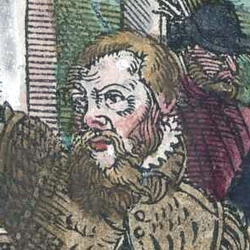 | |
| Born | ca. 1537 Basel, Germany |
| Died | 24 February 1571 (aged 34) Schwerin, Germany |
| Spouse(s) | Appolonia Ruhlman |
| Occupation |
|
| Citizenship | Strasbourg |
| Patron |
|
| Movement | Freifechter |
| Influences | |
| Influenced | |
| Genres | Fencing manual |
| Language | Early New High German |
| Notable work(s) | Gründtliche Beschreibung der... Kunst des Fechtens (1570) |
| Manuscript(s) |
|
| First printed english edition |
Forgeng, 2006 |
| Concordance by | Michael Chidester |
| Translations | |
| Signature | |
Joachim Meyer (ca. 1537 - 1571)[1] was a 16th century German cutler, Freifechter, and fencing master. He was the last major figure in the tradition of the German grand master Johannes Liechtenauer, and in the later years of his life he devised at least four distinct and quite extensive fencing manuals. Meyer's writings incorporate both the traditional Germanic technical syllabus and contemporary systems that he encountered in his travels, including Italian rapier fencing. In addition to his fencing practice, Meyer was a Burgher and a master cutler.[2]
Meyer was born in Basel,[3] where he presumably apprenticed as a cutler. He writes in his books that he traveled widely in his youth, most likely a reference to the traditional Walz that journeyman craftsmen were required to take before being eligible for mastery and membership in a guild. Journeymen were often sent to stand watch and participate in town and city militias (a responsibility that would have been amplified for the warlike cutlers' guild), and Meyer learned a great deal about foreign fencing systems during his travels. It's been speculated by some fencing historians that he trained specifically in the Bolognese school of fencing, but this doesn't stand up to closer analysis.[4]
Records show that by 4 June 1560 he had settled in Strasbourg, where he married Appolonia Ruhlman (Ruelman)[1] and was granted the rank of master cutler. His interests had already moved beyond smithing, however, and in 1561, Meyer's petition to the City Council of Strasbourg for the right to hold a Fechtschule was granted. He would repeat this in 1563, 1566, 1567 and 1568;[5] the 1568 petition is the first extant record in which he identifies himself as a fencing master.
Meyer probably wrote his first manuscript (MS Bibl. 2465) in 1561 for Georg Johann Ⅰ, Count Palatine of Veldenz,[6] and his second (MS A.4º.2) in 1568 for Otto (later Count of Solms-Sonnewalde).[7] Both of these manuscripts contain a series of lessons on training with long sword, dusack, and rapier; the 1561 also covers dagger, polearms, and armored fencing. His third manuscript (MS Var.82), written between 1563 and 1571 and containing a dedication at the end to Heinrich, Count of Eberstein, is of a decidedly different nature. Like many fencing manuscripts from the previous century, it is an anthology of treatises by a number of prominent German masters including Sigmund ain Ringeck, pseudo-Peter von Danzig, and Martin Syber, and also includes a brief outline by Meyer himself on a system of rapier fencing based on German Messer teachings.
Finally, on 24 February 1570, Meyer completed an enormous treatise entitled Gründtliche Beschreibung, der freyen Ritterlichen unnd Adelichen kunst des Fechtens, in allerley gebreuchlichen Wehren, mit vil schönen und nützlichen Figuren gezieret und fürgestellet ("A Thorough Description of the Free, Chivalric, and Noble Art of Fencing, Showing Various Customary Defenses, Affected and Put Forth with Many Handsome and Useful Drawings"); it was dedicated to Johann Casimir, Count Palatine of Simmern,[6] and illustrated at the workshop of Tobias Stimmer.[8] It contains all of the weapons of the 1561 and '68 manuscripts apart from fencing in armor, and dramatically expands his teachings on each.
Unfortunately, Meyer's writing and publication efforts incurred significant debts (about 300 crowns), which Meyer pledged to repay by Christmas of 1571.[1] Late in 1570, Meyer accepted the position of Fechtmeister to Duke Johann Albrecht of Mecklenburg at his court in Schwerin. There Meyer hoped to sell his book for a better price than was offered locally (30 florins). Meyer sent his books ahead to Schwerin, and left from Strasbourg on 4 January 1571 after receiving his pay. He traveled the 800 miles to Schwerin in the middle of a harsh winter, arriving at the court on 10 February 1571. Two weeks later, on 24 February, Joachim Meyer died. The cause of his death is unknown, possibly disease or pneumonia.[5]
Antoni Rulman, Appolonia’s brother, became her legal guardian after Joachim’s death. On 15 May 1571, he had a letter written by the secretary of the Strasbourg city chamber and sent to the Duke of Mecklenburg stating that Antoni was now the widow Meyer’s guardian; it politely reminded the Duke who Joachim Meyer was, Meyer’s publishing efforts and considerable debt, requested that the Duke send Meyer’s personal affects and his books to Appolonia, and attempted to sell some (if not all) of the books to the Duke.[1]
Appolonia remarried in April 1572 to another cutler named Hans Kuele, bestowing upon him the status of Burgher and Meyer's substantial debts. Joachim Meyer and Hans Kuele are both mentioned in the minutes of Cutlers' Guild archives; Kuele may have made an impression if we can judge that fact by the number of times he is mentioned. It is believed that Appolonia and either her husband or her brother were involved with the second printing of his book in 1600. According to other sources, it was reprinted yet again in 1610 and in 1660.[9][10]
Contents
- 1 Treatises
- 2 Temp
- 3 Temporary section break
- 3.1 Gründtliche Beschreibung der… Kunst des Fechtens (1570)
- 3.1.1 Introduction
- 3.1.2 Sword
- 3.1.2.1 Introduction
- 3.1.2.2 1 - Of Man and His Divisions
- 3.1.2.3 2 - Of the Sword and Its Divisions
- 3.1.2.4 3 - Of the Stances or Guards
- 3.1.2.5 4 - Of the Strikes
- 3.1.2.6 5 - Of Displacing
- 3.1.2.7 6 - Of the Withdrawal
- 3.1.2.8 7 - A Lesson in Stepping
- 3.1.2.9 8 - Of Before, After, During, and Indes
- 3.1.2.10 9 - A Guide to the Elements
- 3.1.2.11 10 - How One Shall Fence to the Four Openings
- 3.1.2.12 11 - Fencing from the Stances
- 3.1.2.13 Part Three
- 3.1.3 Dusack
- 3.1.3.1 Introduction
- 3.1.3.2 1 - Contents of the Fencing with Dusacks
- 3.1.3.3 2 - Of the Stances or Guards and Their Use
- 3.1.3.4 3 - Of the Four Cuts, with Four Good Rules
- 3.1.3.5 4 - Of the Secondary Cuts
- 3.1.3.6 5 - How One Shall Use the Four Openings
- 3.1.3.7 6 - Of Displacing, and How All Cuts Are Divided into Three Types
- 3.1.3.8 7 - Now Follow the Stances with the Elements
- 3.1.3.9 8 - Of the Watch and the Elements Assigned to It
- 3.1.3.10 9 - Of the Steer with Its Elements
- 3.1.3.11 10 - Of the Wrathful Guard
- 3.1.3.12 11 - The Direct Displacement or the Slice
- 3.1.3.13 12 - How You Shall Fence from the Bow
- 3.1.3.14 13 - Of the Boar
- 3.1.3.15 14 - Of the Middle Guard, and How One Shall Fence from It
- 3.1.3.16 15 - Of the Changer and Its Elements
- 3.1.4 Rapier
- 3.1.4.1 1 - Contents of the Fencing with the Rapier
- 3.1.4.2 2 - Of the Divisions of the Man, and of the Weapon, and of Their Use.
- 3.1.4.3 3 - Of the Guards and Stances of the Rapier
- 3.1.4.4 4 - Of the Classification of the Four Strikes
- 3.1.4.5 5 - Of Thrusting
- 3.1.4.6 6 - A Good Lesson and Rule How One Can Change Strikes into Stabs and Stabs into Strikes
- 3.1.4.7 7 - Of the Misleading
- 3.1.4.8 8 - In This Chapter Will Be Handled Changing, Following After, Staying, Feeling, Twitching, and Winding
- 3.1.4.9 Part Two
- 3.1.4.10 How You Should Use the Weapon Along with a Sidearm
- 3.1.5 Dagger
- 3.1.6 Polearms
- 3.1 Gründtliche Beschreibung der… Kunst des Fechtens (1570)
- 4 Temporary section break
- 5 Additional Resources
- 6 References
Treatises
Joachim Meyer's writings are preserved in three manuscripts prepared in the 1560s: the 1561 MS Bibl. 2465 (Munich), dedicated to Georg Johannes von Veldenz; the 1563-68 MS A.4º.2 (Lund), dedicated to Otto von Solms; and the MS Var. 82 (Rostock), including notes on teachings from Stephan Heinrich von Eberstein and which Meyer may have still been working at the time of his death in 1571. Dwarfing these works is the massive book he published in 1570 entitled Gründtliche Beschreibung der ...Kunst des Fechtens ("A Thorough Description of the... Art of Fencing"), dedicated to Johann Kasimir von Pfalz-Simmern. Meyer's writings purport to teach the entire art of fencing, something that he claimed had never been done before, and encompass a wide variety of teachings from disparate sources and traditions. To achieve this goal, Meyer seems to have constructed his treatises as a series of progressive lessons, describing a process for learning to fence rather than merely outlining the underlying theory or listing the techniques. In keeping with this, he illustrates his techniques with depictions of fencers in courtyards using training weapons such as two-handed foils, wooden dusacks, and rapiers with ball tips.
The first section of Meyer's treatise is devoted to the long sword (the sword in two hands), which he describes as the foundational weapon of his system, and this section devotes the most space to fundamentals like stance and footwork. His long sword system draws upon the teachings of Freifechter Andre Paurenfeyndt (via Christian Egenolff's reprint) and Liechtenauer glossators Sigmund ain Ringeck and Lew, as well as using terminology otherwise unique to the brief Recital of Martin Syber. Not content merely to compile these teachings as his contemporary Paulus Hector Mair was doing, Meyer sought to update—even reinvent—them in various ways to fit the martial climate of the late sixteenth century, including adapting many techniques to accommodate the increased momentum of a greatsword and modifying others to use beats with the flat and winding slices in place of thrusts to comply with street-fighting laws in German cities (and the rules of the Fechtschule).
The second section of Meyer's treatises is designed to address new weapons gaining traction in German lands, the dusack and the rapier, and thereby find places for them in the German tradition. His early Lund manuscript presents a more summarized syllabus of techniques for these weapons, while his printed book goes into greater depth and is structured more in the fashion of lesson plans.[11] Meyer's dusack system, designed for the broad proto-sabers that spread into German lands from Eastern Europe in the 16th century,[12] combines the old Messer teachings of Johannes Lecküchner and the dusack teachings of Andre Paurenfeyndt with other unknown systems (some have speculated that they might include early Polish or Hungarian saber systems). His rapier system, designed for the lighter single-hand swords spreading north from Iberian and Italian lands, seems again to be a hybrid creation, integrating both the core teachings of the 15th century Liechtenauer tradition as well as components that are characteristic of the various regional Mediterranean fencing systems (including, perhaps, teachings derived from the treatise of Achille Marozzo). Interestingly, Meyer's rapier teachings in the Rostock seem to represent an attempt to unify these two weapon system, outlining a method for rapier fencing that includes key elements of his dusack teachings; it is unclear why this method did not appear in his book, but given the dates it may be that they represent his last musings on the weapon, written in the time between the completion of his book in 1570 and his death a year later.
The third section of Meyer's treatise is omitted in the Lund manuscript but present in the Munich and the 1570, and covers dagger, wrestling, and various pole weapons; to this, the Munich adds several plays of armored fencing. His dagger teachings, designed primarily for urban self-defense, seem to be based in part on the writings of Bolognese master Achille Marozzo,[13] but also include much unique content of unknown origin (perhaps the anonymous dagger teachings in his Rostock manuscript). His staff material makes up the bulk of this section, beginning with the short staff, which, like Paurenfeyndt, he uses as a training tool for various pole weapons (and possibly also the greatsword), and then moving on to the halberd before ending with the long staff (representing the pike). As with the dagger, the sources Meyer based his staff teachings on are largely unknown.
Temp
Temporary section break
Temporary section break
For further information, including transcription and translation notes, see the discussion page.
| Work | Author(s) | Source | License |
|---|---|---|---|
| Lund Figures | Lunds Universitets Bibliotek | Lunds Universitets Bibliotek | |
| 1570 Figures | Tobias Stimmer | Universitätsbibliothek Leipzig | |
| Rostock Figures | Universitätsbibliothek Rostock | ||
| Translation | Mike Rasmusson | Schielhau.org | |
| Translation | Kevin Maurer | Meyer Frei Fechter Guild | |
| Translation | Thomas Carrillo | Meyer Frei Fechter Guild | |
| Translation | Jon Pellett | Megalophias his Page | |
| Translation | Jordan E. Finch | Wiktenauer | |
| Lund Transcription | Olivier Dupuis | Index:Joachim Meyers Fäktbok (MS A.4º.2) | |
| 1570 Transcription | Michael Chidester | Index:Gründtliche Beschreibung... der Kunst des Fechtens | |
| Rostock Transcription | Jens P. Kleinau | Index:Fechtbuch zu Ross und zu Fuss (MS Var.82) |
Additional Resources
The following is a list of publications containing scans, transcriptions, and translations relevant to this article, as well as published peer-reviewed research.
- Adamson, William Charles (2011). The Nationalism of Joachim Meyer: An Analysis of German Pride in his Fighting Manual of 1570 [Unpublished thesis; paper 1286]. East Tennessee State University School of Graduate Studies. http://dc.etsu.edu/etd/1286
- Bas, Pierre-Henry (2021). "La modernité dans l'escrime de Joachim Meyer?." Martial Culture in Medieval Town. http://martcult.hypotheses.org/1322
- Chidester, Michael (2020). The Illustrated Meyer: A Visual Reference for the 1570 Treatise of Joachim Meyer. Somerville, MA: HEMA Bookshelf. ISBN 978-1-953683-00-7.
- Dupuis, Olivier (2006). "Joachim Meyer, escrimeur libre, bourgeois de Strasbourg (1537?-1571)." Maîtres & Techniques de Combat à la fin du Moyen Age et au Début de la Renaissance: 107-120. Ed. by Fabrice Cognot. Paris: Association pous l'Edition et la Diffusion des Études Historiques. ISBN 2-907594-10-9.
- Dupuis, Olivier (2016). "Joachim Meyer, free fencer, citizen of Strasbourg (?1537–1571)." The Art of Sword Combat: A 1568 German Treatise on Swordsmanship: 171-190. Trans. by Jeffrey L. Forgeng. London: Frontline Books. ISBN 9781473876750.
- Dupuis, Olivier (2021). "A New Manuscript of Joachim Meyer (1561)." Acta Periodica Duellatorum 9(1): 73-86. doi:10.36950/apd-2021-004.
- Kieffer, Fanny (2022). "Dessiner le geste technique à la Renaissance : le dialogue entre le peintre Tobias Stimmer et le maître d'armes Joachim Meyer." Arts, Civilisation et Histoire de l'Europe 20: 49-72.
- Kiermayer, Alex (2012). Joachim Meyers Kunst Des Fechtens. Gründtliche Beschreibung des Fechtens, 1570. Arts of Mars Books. ISBN 978-3981162738.
- Kintz, Pierre (2021). "Tobias Stimmer, illustrateur du Fechtbuch de Joachim Meyer." Martial Culture in Medieval Town. http://martcult.hypotheses.org/1316
- Meyer, Joachim (2006). The Art of Combat: A German Martial Arts Treatise of 1570. Trans. by Jeffrey L. Forgeng. London: Greenhill Books. ISBN 978-1-85367-643-7.
- Meyer, Joachim (2006). The Art of Combat: A German Martial Arts Treatise of 1570. Trans. by Jeffrey L. Forgeng. New York: Palgrave MacMillan. ISBN 978-1-40397-092-0.
- Meyer, Joachim (2011). Joachim Meyer 1600: Transkription des Fechtbuchs 'Gründtliche Beschreibung der freyen Ritterlichen und Adelichen kunst des Fechtens'. Ed. by Wolfgang Landwehr. Herne: VS-Books. ISBN 978-3-932077-37-1.
- Meyer, Joachim (2015). The Art of Combat: A German Martial Arts Treatise of 1570. Trans. by Jeffrey L. Forgeng. London: Frontline Books. ISBN 978-1-84832-778-8.
- Meyer, Joachim (2016). The Art of Sword Combat: A 1568 German Treatise on Swordsmanship. Trans. by Jeffrey L. Forgeng. London: Frontline Books. ISBN 9781473876750.
- Meyer, Joachim (2023). Foundational Description of the Art of Fencing: The 1570 Treatise of Joachim Meyer (Reference Edition). Trans. by Rebecca L. R. Garber. Ed. by Michael Chidester. Medford, MA: HEMA Bookshelf. ISBN 978-1-953683-30-4 (Vol 1); 978-1-953683-32-8 (Vol 2).
- Meyer, Joachim (2023). Foundational Description of the Art of Fencing: The 1570 Treatise of Joachim Meyer (Reading Edition). Trans. by Rebecca L. R. Garber. Ed. by Michael Chidester. Medford, MA: HEMA Bookshelf. ISBN 978-1-953683-34-2.
- Mondschein, Ken; Olivier Dupuis (2019). "Fencing, Martial Sport, and Urban Culture in Early Modern Germany: The Case of Strasbourg." Journal of Medieval Military History XVII: 237-258. Ed. by Kelly DeVries; John France and Clifford J. Rogers. Woodbridge: Boydell Press. ISBN 9781783273928.
- Naas, Laurent (2021). "L'exemplaire sélestadien de la Gründtliche Beschreibung der freyen Ritterlichen unnd Adelichen Kunst des Fechtens de Joachim Meyer (BHS., K.161)." Martial Culture in Medieval Town. http://martcult.hypotheses.org/1302
References
- ↑ 1.0 1.1 1.2 1.3 Dupuis, Olivier. Joachim Meyer, escrimeur libre, bourgeois de Strasbourg (1537 ? - 1571). In Maîtres et techniques de combat. Dijon: AEDEH, 2006.
- ↑ Naumann, Robert. Serapeum. Vol. 5. T.O. Weigel, 1844. pp 53-59.
- ↑ According to his wedding certificate.
- ↑ The influence of Achilles Marozzo's printed treatise is, however, apparent in the rapier illustrations of his 1561 manuscript and the dagger plays in his book.
- ↑ 5.0 5.1 Van Slambrouck, Christopher. "The Life and Work of Joachim Meyer". Meyer Frei Fechter Guild, 2010. Retrieved 29 January 2010.
- ↑ 6.0 6.1 Though as a prince of the Wittelsbach dynasty, he was addressed by the loftiest titles held by the family: Count Palatine of the Rhine and Duke of Bavaria.
- ↑ Norling, Roger. "The history of Joachim Meyer’s fencing treatise to Otto von Solms". Hroarr.com, 2012. Retrieved 14 February 2015.
- ↑ Whose members included Christoph Maurer and Hans Christoffel Stimmer.
- ↑ Schaer, Alfred. Die altdeutschen fechter und spielleute: Ein beitrag zur deutschen culturgeschichte. K.J. Trübner, 1901. p 76.
- ↑ Pollock, W. H., Grove, F. C., and Prévost, C. Fencing. London and Bombay: Longmans, Green, and co, 1897. pp 267-268.
- ↑ Roberts, James. "System vs Syllabus: Meyer’s 1560 and 1570 sidesword texts". Hroarr.com, 2014. Retrieved 14 February 2015.
- ↑ Roger Norling. "The Dussack - a weapon of war". Hroarr.com, 2012. Retrieved 6 October 2015.
- ↑ Norling, Roger. "Meyer and Marozzo dagger comparison". Hroarr.com, 2012. Retrieved 15 February 2015.
- ↑ Up to this point, the text matches the Lund manuscript, folia 6r to 7r.
- ↑ Note: this translation could be interpreted to mean “so that your half edge slides downward [presumably on his blade], hitting his right shoulder”. Meyer used the words mit Glitschen = to slither, to slide, to glide, to move with sliding.
- ↑ A number in the margin refers to the illustration in page number 13.
- ↑ The text starts matching the Lund manuscript again here (beginning on folio 7v), continuing until the Figures.
- ↑ Note: The Lund also mentions “the figure above” yet that figure does not appear in the Lund! Here it does, and it could be a representation of Meyer himself?
- ↑ The "l" appears to be written over another letter, perhaps a "b".
- ↑ Note: here I have included this line for clarity from Dr. Forgeng’s 1568 Lund translation: “Therefore every fighter shall know as has been said above, for when two good fighters come together, whoever thinks quicker triumphs quicker.”
- ↑ Note: the image shows the opponent on the left in Barrier Guard with point to the ground, hence Meyer’s advice to “take his blade away from the ground”.
- ↑ 22.0 22.1 22.2 22.3 Torn page on left.
- ↑ 23.0 23.1 Torn page on right.
- ↑ To help illuminate the connections to Liechtenauer's teachings, I've added the verse numbers used in the Johannes Liechtenauer article and the various glosses to Kevin's translation. I've also added a few footnotes, and included my initials to distinguish them from Kevin's notes. Note all the verses in this section are found in Christian Egenolff's 1531 edition of Andre Paurenfeyndt's treatise—except the "First Rhyme", verses 17-20. ~Michael Chidester
- ↑ Note: the interpretation here is a generalized summary found in the 1570 at Ⅰ.45v—46r
- ↑ These two lines are a paraphrase of verse 77 of Liechtenauer's Zedel. ~MCC
- ↑ This rhyming section is reminiscent of the eight-line Indes poem found in several of the 15th century glosses (despite not being part of Liechtenauer's Zedel), but only the last two lines are the same. ~MCC
- ↑ This rhyme found in Egenolph's 1531 Frankfurt edition of Pauernfeindt, page 4v.
- ↑ Unclear.
- ↑ This rhyme found in Egenolph's 1531 Frankfurt edition of Pauernfeindt, page 7r.
- ↑ Note: gesechen = may be gesehen ENHG
- ↑ Unclear.
- ↑ This is a reference to Liechtenauer verses 56 and 79. ~MCC
- ↑ Liechtenauer verse 57. ~MCC
- ↑ This is the fourth of Paurnfeyndt's Twelve Rules for the Beginner Fencer, found on page 4r of Egenolff 1531. This is particularly odd because the first line comes from Egenolff, but the second line seems to be from Liechtenauer verse 11, which the rule was based on. The version in the fourth rule is Der darff sich kunst nit frewen. ~MCC
- ↑ The above text appears somewhat synonymous with pages 44-45 of the Lund Dussack section, except that in the Lund Meyer says there are 12 cuts and yet here he says there are 16.
- ↑ This text also appears in the Lund pg 45, yet there Meyer gave an alternate name to the Watch guard as Luginslandt, here he does not mention Luginslandt. Additionally, Meyer does not include the Blind Cut in the Lund, yet here he does and it also appears in 1570 Dussack. In addition, here Meyer names the Slice and the Bow as guards. Yet in the 1560 he lists them with the guards but says they are the two parrys. Here he gives a separate paragraph about these two.
- ↑ Above text also appears in Lund 47v.1.
- ↑ The translation for this paragraph is incomplete. The missing part says something like "thus trap his hand as is drawn here, step behind him, and". ~MCC
- ↑ Lund 57v.1 Zornhau.
- ↑ The first paragraph “A good attack from the Steer” is synonymous in the 1560 57v.2. Last two paragraphs here are not found there.
- ↑ Unclear.
- ↑ Found in Lund 60v.1.
- ↑ Abrauschen = to shoot off.
- ↑ The second rule omits this sentence found in the Lund, “so that your Dussack comes onto your left shoulder”, and rather Meyer says here, “lift simultaneously your body together with the Dussack to your left side”. Then the Lund synonymously says “turn your body well after your Dussack upon your left side”.
- ↑ These two paragraphs found in Lund 61v.1 and 62r.1; with above noted differences.
- ↑ The 4th rule and other paragraph synonymous with Lund 62r.2, 62r.3
- ↑ The Counter to the Bow is synonymous with Lund 62v.1, except that here Meyer added the target of striking besides his parry to the face, ad also changed last line to read: “This technique often works as has been shown previously in the Bow”, while in the Lund he says “This technique often works as has been shown previously in the Bow and Change.” So he omitted the word Wechsel or Changer here.
- ↑ It refers to the picture set at the page with the number 31.
- ↑ Found in Lund 63r.1 63r.2 63r.3.
- ↑ Above paragraph “Breaking in over the Bow” is found in Lund 63v.1. Here Meyer added schenkel (thigh), also he added another line to the next; “zum gesicht das dein versatzung hoch pleibt” The third paragraph here is not found in the Lund.
- ↑ First paragraph here found as last and separate para in 63v.1 Lund. Meyer changed words here on the last line of the second paragraph from hand to haft, “so that your haft remains high”.
- ↑ Durcken Zug = this may mean Turkish Cut. A slice using a drawing motion, usually with a curved blade.
- ↑ Kniebugen = crook of knee, bend of knee.
- ↑ These descriptions differ in wording from the Lund.
- ↑ Apicem id from Latin: Apex Cut or a Scalp Cut; as also used in the Lund.
- ↑ Possible translation of anckell: “back of head”, as the image clearly shows a strike there.
- ↑ Curious typographical sign.
- ↑ Unclear.
- ↑ Note: The first paragraph of Two Constrainers appears in Lund 55v.1, but it does not include second paragraph found here from left steer.
- ↑ This paragraph is from Lund 56r.1, but is titled there: "a Good Stuck from the Constrainer"; here Meyer calls it an “Example”.
- ↑ The Rose Cut's first paragraph above is found in the Lund 56r.2, but the 2nd paragraph here is not found in Lund.
- ↑ Feler hau description here is mostly synonymous with the Lund 50r.1, but here Meyer ends with “how it is reported in the Boch hau”, which is not found in the Lund.
- ↑ Synonymous with Lund 56v.3.
- ↑ Synonymous with Lund 57r.1.
- ↑ Synonymous with Lund 57r.2.
- ↑ Unclear.
- ↑ Arbeit im einlauffen from Lund 60r.2; last 3 lines do not appear in Lund. Item etc.
- ↑ The isolated “s” seems a mistake and not the beginning of an unfinished word.
- ↑ The Drivings also appear in Lund 64v.1 – 65r.1.
- ↑ Note this line is missing from 6th driving here, but found in Lund 65r.1: sonderlich einem starcken zum schlachtschwert, "particularly for someone who is strong with a Battlesword".
- ↑ Note: The handwriting appears closer together with less spacing between sentences and words, so that maybe the author had a lot to share and yet was bound to limit the page space used? Appears Crammed together more.
- ↑ Unclear.
- ↑ Unclear.
- ↑ This paragraph here is from Lund 76v.1.
- ↑ These paragraphs found in Lund 77v.1 and 78v.1. These paragraphs found in Lund Rapier prior to this poem: Drei Lauffende Stich auss dem linken Pflug von einer seitten.
- ↑ Paragraph found in Lund 78v.2.
- ↑ From Lund 79r.1.
- ↑ Unclear.
- ↑ Unclear.
- ↑ Unclear.
- ↑ 82.0 82.1 82.2 orig. dolchen; all instances of "dagger" in this document are dolchen excepy when footnoted.
- ↑ orig. ararmschirleinn
- ↑ orig. stichen, "thrust"/"stab" (context dependent); instances of stabbing that use other verbs will be footnoted.
- ↑ orig. Armschiene - seemingly a part of the armour
- ↑ orig. geordinirtt
- ↑ orig. schießen; see here
- ↑ orig. findt
- ↑ orig. spis
- ↑ orig. schwertt
- ↑ orig. sebell
- ↑ 92.0 92.1 orig. kempff degen; it can mean either “combat sword” or “combat dagger” (Source 1, Source 2). See here for a painting with kempffdegen in its caption
- ↑ 93.0 93.1 orig. Anngreiffen; "attacking" or "grappling"; cf. angreifen
- ↑ orig. zimlich
- ↑ alt. "endure"
- ↑ Ittem has many potential meanings: "further", "likewise", "the same as", and also simply as a means of 'bullet-pointing' numerous items. I've found that "likewise" works as an apt translation most of the time, but for clarity I will leave it untranslated. See this article.
- ↑ orig. noch eines Idenn woll gefalen
- ↑ orig. Reren; cf. Rohre/Röhre
- ↑ orig. lest
- ↑ orig. Schranckenn
- ↑ orig. dringen/thringen; refers to pressing one's point into an opponent['s armour/mail], cf. modern sense of "pushing through a crowd". See this glossary for more information
- ↑ orig. donerschlag; a strike with the hilt of the longsword while holding the blade
- ↑ orig. vnnd las Inn vorverthobenn; messy ink makes it difficult to transcribe; possible alt. "and read above beforehand"
- ↑ A blunt strike, as opposed to a cut or slice. See here.
- ↑ orig. versezen; alt. "parrying"
- ↑ Unclear.
- ↑ orig. ansezen; most likely means "pinned", "planted" (in the sense of placing your weapon or hand against an opponent, in a grappling sense); alt. "attacking" (cf. modern ansetzen). See this glossary for more information
- ↑ orig. erlang
- ↑ see nachreissen
- ↑ 110.0 110.1 110.2 110.3 110.4 110.5 110.6 orig. stehenn; often coupled with ansezen in this section; alt. "stand against"
- ↑ orig. uchsen
- ↑ orig. Gelenck. Refers to joints in armour, but also body parts - in the context of armoured fencing, it is most likely referring to the joints in the armour
- ↑ orig. greifest
- ↑ 114.0 114.1 114.2 114.3 orig. brich
- ↑ orig. anbrichen
- ↑ 116.00 116.01 116.02 116.03 116.04 116.05 116.06 116.07 116.08 116.09 116.10 116.11 orig. stos
- ↑ orig. goch
- ↑ 118.0 118.1 118.2 118.3 118.4 118.5 118.6 orig. schlag
- ↑ 119.0 119.1 119.2 see absetzen
- ↑ orig. drissel; cf. thrissel
- ↑ orig. schlag dein beidt vnder dein Recht achsell. From interpretation, the word schlag here doesn't make much sense: it's possible that beidt was intended to be said or written as bindt, as in "put your grip under your right shoulder".
- ↑ orig. Achsell
- ↑ 123.0 123.1 see Ringen
- ↑ 124.0 124.1 see arbeiten
- ↑ 125.0 125.1 125.2 125.3 125.4 125.5 orig. streich, cf. schlag
- ↑ 126.0 126.1 126.2 126.3 126.4 126.5 126.6 126.7 orig. inndes
- ↑ alt. "attacks"
- ↑ orig. last Er dür die seitten
- ↑ 129.0 129.1 orig. Ring; alt. lists
- ↑ orig. vergesezsten
- ↑ 131.0 131.1 131.2 see abzucken
- ↑ orig. fies
- ↑ 133.0 133.1 see gleich
- ↑ unclear transcription; possibly nim, ergo "take the weight"
- ↑ Unclear.
- ↑ orig. zwerchs
- ↑ 137.0 137.1 orig. degen; see kempffdegen
- ↑ orig. hawen. A cut or slice, as opposed to a blunt strike. See see here.
- ↑ 139.0 139.1 139.2 orig. bickell; most likely referring to the artificial, "mason's hammer", pickaxe shape of the crossguard in armoured fencing
- ↑ orig. klos
- ↑ orig. Stuck
- ↑ orig. knefftiglich, interpreted as krefftiglich
- ↑ orig. verfelen - described earlier in 1561 as a feint whereby you wait for your opponent to react to a strike, then change the direction of the strike
- ↑ orig. entgehenn
- ↑ orig. faren/auffaren; cf. fahren
- ↑ originally transcribed as knefftiglich, but krefftiglich (lit. "powerfully") seems more likely, in my opinion
- ↑ orig. gerecht; possible mistranscription/misspelling of gemecht, lit. "groin" or "genitals"
- ↑ 148.0 148.1 148.2 orig. las dein bindt fahren, lit. "let your grip drive"; alt. "release your grip and drive"
- ↑ Possibly "hauberk"(?).
- ↑ 150.0 150.1 orig. ausnemen; alt. "take out [the blade with a parry]"; "deflect"(?)
- ↑ orig. verzoblen; cf. verzögern
- ↑ lit. oben hutt; contrast Oberhutt
- ↑ orig. heutt; possible verb form of hutt
- ↑ orig. überwegest
- ↑ 155.0 155.1 orig. schlagen. Probably means "place" in this context.
- ↑ orig. sez; no accompanying adposition but I assume he means ansezen
- ↑ listen
- ↑ orig. Bundtschlag, lit. "grip strike"
- ↑ orig. fertt
- ↑ orig. wie nechst
- ↑ orig. oder Aber fus gesicht, lit. or but foot face, possible alt. "or his foot or face"
- ↑ orig. wendt
- ↑ orig. Reüb
- ↑ orig. geschmidt, lit. smithed. Possibly misspelling of Geschmeidt, which means "jewellery" - perhaps slang for gemecht ("genitals)".
- ↑ orig. steßen
- ↑ orig. abgewünnen
- ↑ Note that he uses the word degen but seems to refer to the aforementioned "threefold" dagger, which he referred to using the word dolchen.
- ↑ orig. feder
- ↑ orig. spietzen
- ↑ Reference in the left margin to picture on page 61.
- ↑ orig. auf dz schlos am Rucken; alt. "clasp of the back"
- ↑ orig. Wappenrock
- ↑ Unclear whether die refers to the dagger or the heart, here
- ↑ orig. kurz halbenn; alt. "short edge"
- ↑ orig. concordiren
- ↑ This word overwrites an initial die.
- ↑ The first 10 lines of this paragraph are shorter of 30% than the last four, as if there is a left place here for a picture or a diagram.
- ↑ The second letter looks a bit like a “b” but it is nonsense. It can be also considered like a small capital “e”.
- ↑ The first letter corrected from “w” by cancelling the first bow of the letter.
- ↑ The first letter could also read as an “l", but “b” seems more probable here.
- ↑ The first letter corrected from “b” by overwriting.
- ↑ The ink is a bit blurred, particularly in the beginning of the word which results in an ambiguous reading; stucken would be more plausible in this context but does not fit with the appearance of the first couple of letters at all.
- ↑ The writer first wrote hawst but the “s” has been cancelled afterwards.
- ↑ Recte: und.
- ↑ The writer first wrote arms but the final “s” has been cancelled afterwards.
- ↑ The letter “s” has ben cancelled just before the word den.
- ↑ Above the letter “i” a large circle is drawn as it is used to mark the letter “u”.
- ↑ Doubling of the word seitten, considered as a mistake and corrected here as the first finished a line.
- ↑ Setzen has been written afterwards just under ver- and looks like a catchword; however, the following page does not start with the same word. It could be a mistake of the scribe.
- ↑ An abbreviation sign at the end of the word tends to signify that it should be expanded to hawen, but it has been cancelled.
- ↑ The “h” is writen above a “e”.
- ↑ Unclear reading. The word has been corrected, possibly from zu, which, however, cannot be definitely affirmed.
- ↑ The words und oder after this word are cancelled.
- ↑ At this place is a sign that commonly indicates a line break or an end of a paragraph. Here, however, the following text continues in the same line.
- ↑ The first letter appears to be a cancelled “t”; however the reading remains ambiguous.
- ↑ The end of this word, sicht is inserted below the line at the right, like a catchword. However, the following written page, fol. 23r, does not start with the same word. Could be a mistake by the scribe or a clue for a missing page.
- ↑ After this word a large circle is drawn and its only meaning seems to complete the line to the right and avoid a big default in the right alignment.
- ↑ The letter “d” is cancelled just before the “b” of this word.
- ↑ The initial letter “b” is written above another letter, maybe a “g”.
- ↑ This first two letters are written above the letter “k”.
- ↑ A letter “b” or “l” has been written after this word but has ben cancelled.
- ↑ The first letter seems to superscribe an initial “I”.
- ↑ The writer firstly wrote an “m” as a final letter and subsequently cancelled the last leg to get an “n”.
- ↑ The final letter “t” is written above the line, in replacement for a previously cancelled letter.
- ↑ This word is written above a previous one, which is unreadable now.
- ↑ The first letters are difficult to make out due to a (water?) damage.
- ↑ The first letter of this word has been written above another, now illegible one.
- ↑ A letter “h” was written in the second position to begin with but cancelled afterwards.
- ↑ The first letter is curiously composed, but seems to have been readen as a "v".
- ↑ The second letter has been canceled and corrected by "o" above the line.
- ↑ The original text is derholhalben derhalben, which seems to be an unnecessary repetition.
- ↑ Doubling of the word handt, a probable mistake as the first is written a the end of the line. Same mistake as 17r.
- ↑ Doubling of the words den andern, probable mistake, only it is conserved here.
- ↑ A lone letter "h" is writen here, perhaps a beginning for “hew”, which was finally written after the digit “4”. Corrected in this edition.
- ↑ This sentence can be found in the printed book: « und merck wann du zur rechten undern Blöß schlechst, es sey flech, lang oder kurtz » (plate XXIXv from the 1570 edition)
- ↑ The third letter “h” was cancelled by overwriting it with an “l”.
- ↑ The letter “a” is crossed out in the beginning of the word.
- ↑ The first letter was first written in lower case but was corrected with an upper-case letter.
- ↑ Unclear reading. It appears as if the scribe first intended to write “halber” but noticed his error in the middle of the word. The reverse may be true also.
- ↑ The "R." has been inserted at the end of the line afterwards.
- ↑ Right of this place a large blank space remains until the end of the line.
- ↑ The written put a "n" between sch and enckel and canceled it.
- ↑ Linck and seitten are reversed in the manuscript but superscribed with “1” and “2” respectively in order to indicate the correct order.
- ↑ Corrected from Im, the first stroke of the “m” has been cancelled.
- ↑ Spitz uber- is clearly copied twice, this is probably an eye-skip.
- ↑ Correction done on sticht by canceling the last letter.
- ↑ This entire paragraph is justified on the right by a vertical line, unique in the manuscript.
- ↑ Corrected on Ⅲ.47v.
- ↑ Corrected on Ⅲ.47v.
- ↑ The "st" ligature is inverted.
- ↑ Typo, should be "wolt, könne".
- ↑ Originally printed "abzutzest", but corrected on Ⅲ.47v.
- ↑ Originally printed "verhauren", but corrected on Ⅲ.47v.
- ↑ The "t" is inverted.
- ↑ Ⅲ.47v indicates that this was printed "erbangen" and needed to be corrected to "erlangen", but that's not true in any copy available for consult.
- ↑ Originally printed "mim", but corrected on Ⅲ.47v.
- ↑ Originally printed "Higur", but corrected on Ⅲ.47v.
- ↑ Originally printed "Fellen", but corrected on Ⅲ.47v.
- ↑ Originally printed "gem" (with an inverted g), but corrected on Ⅲ.47v.
- ↑ Originally printed "allo", but corrected on Ⅲ.47v.
- ↑ Originally printed "Atm", but corrected on Ⅲ.47v.
- ↑ The first 't' is inverted.
- ↑ Terminal 'e' is inverted.
- ↑ Originally printed "bleiden", but corrected on Ⅲ.47v.
- ↑ Originally printed "klnie", but corrected on Ⅲ.47v.
- ↑ Originally printed "duch", but corrected on Ⅲ.47v.
- ↑ The second "e" is inverted.
- ↑ Originally printed "fein", but corrected on Ⅲ.47v.
- ↑ Originally printed "behendig ich", but corrected on Ⅲ.47v.
- ↑ Misnumbered 87r.
- ↑ 251.00 251.01 251.02 251.03 251.04 251.05 251.06 251.07 251.08 251.09 251.10 251.11 251.12 251.13 251.14 251.15 251.16 251.17 251.18 251.19 251.20 251.21 251.22 251.23 251.24 251.25 251.26 251.27 251.28 251.29 251.30 251.31 indes
- ↑ palm up
- ↑ Illegible deletion.
- ↑ oberhauw
- ↑ ‘right’ is originally written, ‘left’ is written above it
- ↑ short edge
- ↑ “Degen”, lit. dagger, could either refer to a sword or dagger.
- ↑ short edge
- ↑ Unleserliche Streichung. Illegible deletion.
- ↑ Unleserliche gestrichen Einfügung oberhalb der Zeile. Crossed out illegible insertion above the line.
- ↑ Die Schlaufe des »h« trägt ein Diärese. The loop of the “h” carries a diaeresis.
- ↑ Korrigiert aus »mitelhauw«. Corrected from “mitelhauw”.
- ↑ Leicht unleserlich. Slightly illegible.
- ↑ Überschriebens »vom«. Overwritten “vom”.
- ↑ Inserted by means of a special mark.
- ↑ Word inserted next to the text.
- ↑ Inserted nest to the text.
- ↑ Zwei Worte am Seitenrand nachgetragen. Two words inserted at the margin.
- ↑ Wort am Seitenrand nachgetragen. Word inserted at the margin.

